- Amalfi Coast

Visiting The Ruins of Herculaneum

As opposed to Pompeii , it's possible to visit all of Herculaneum in just a few hours. The archaeological park is ideal stop for those who have limited time but want to experience the thrill of walking in the footsteps of the ancient Romans!
Herculaneum has been preserved like no other site in the world, not even nearby Pompeii . The city was buried beneath 16 meters of ash and mud during the eruption of Mount Vesuvius in 79 AD, and this layer of detritus saved two-story domus homes with the internal architecture and décor intact, including features in wood and marble, decorations, jewelry, and even organic remains like food, providing a unique view into the daily lives of the ancient population of Herculaneum.
We suggest spending at least a half day exploring the Herculaneum Archaeological Site; follow our itinerary to see the most important buildings in the site in 2-3 hours . In addition to an itinerary, we suggest the top sights to see along the route on this page, which are marked with the same numbers as the official map provided free of charge at the entrance to the ruins. You can also download the official map following the link below.
Opening time: From 16/03 to 14/10: from 8.30am to 7.30pm (last entry 6.00pm; the archaeological area must be left by 7.00pm) From 15/10 to 15/03: from 8.30am to 5.00pm (last entry 3.30pm; archaeological area must be left by 4.40 pm) Closing days: 1 January, 25 December Tickets: Ordinary ticket: €13. Under 18: free. Young people between 18 and 25 years of age: €2.
A Brief History of Herculaneum
Herculaneum is named for the mythical Greek god, Hercules , who, according the legend told by Dionysius of Halicarnassus, founded the city in 1243 BC. Historic analysis, however, suggests that the city was founded by the Oscans or the Etruscans in the 7th century BC , conquered by the Samnites in the 5th century BC. In 90 BC the city was dominated by Rome and transformed into a municipium . In the final years of the Roman Republic, Herculaneum reached the height of its splendor thanks to its coastal location, clean air, and mild climate, making it a popular resort town for many of Rome's patrician families. The city was vibrant and densely populated when the earthquake struck in 62 AD, causing serious damage; work to rebuild the city was still going on when the tragic eruption of Mount Vesuvius happened in 79 AD. The cloud of toxic gases from the eruption wiped out the inhabitants, while the entire city was literally sealed under a flow of ash and volcanic rock 16 meters deep that solidifiedi , preserving almost perfectly intact organic remains like fabric, food, vegetation, and wooden structures.
Visiting the Crater on Mount Vesuvius
The discovery of the ruins at Herculaneum was a complete accident: while a well was being dug in 1707 by order of Emmanuel Maurice, Prince of Lorraine , a number of marble fragments and statues that once decorated the ancient theater of Herculaneum were unearthed. In 1738, work began again under Charles III of Bourbon led by the Spanish military engineer De Alcubierre. In 1755, after a number of important discoveries were made, the Accademia Ercolanense was established, and was active until 1792. Excavations were suspended a number of times over the years until 1927, when the site began to explored in a more systematic way. Important artifacts were unearthed in the 1980s, along with sites like the Temple of Venus, the baths, and the ancient Greek port where the inhabitants tried to find refuge in 79 AD. The site has been home to intense excavation since 2000, especially around the Villa of the Papyrus and the library.
Two to Three Hour Itinerary
Sites to visit beginning from the Corso Resina 187 entrance ( Circumvesuviana “Ercolano Scavi” stop long the Sorrento - Naples line)
- House of Argus (40)
- House of the Skeleton (42)
- Thermopolium (38)
- Men's Baths (26)
- Double Atrium House (25)
- Hall of the Augustals (24)
- House of the Beautiful Courtyard (28)
- House of Neptune and Amphitrite (29)
- Women's Baths (27)
- Samnite House (31)
- House of the Wooden Partition (36)
- Large Taberna (10)
- House of Relief of Telephus (7)
- House of the Deers (8)
- Terrace of M. Nonius Balbus (2)
- Fornici (1)
The main sights to visit Area + number on the official map in parenthesis
Visiting the Herculaneum Archaeological Park with Kids
Visiting the Herculaneum Archaeological Park with small children can be difficult as the site's ancient Roman roads and sidewalks are not easy to navigate with strollers and pushchairs. We suggest using an infant carrier or backpack for children who are too young to walk, and leaving any wheeled strollers at the free bag check area at the entrance. Otherwise, you can follow the walkway that encircles the perimeter of the site with a stroller or pushchair, viewing the ruins from above.
Older children enjoy visiting the MAV (Virtual Archaeological Museum) , located a short walk from the entrance to the Herculaneum Archaeological Park. This museum has a virtual, interactive exhibition that recreates ancient Herculaneum as it was before the violent eruption in 79 AD that destroyed the city. There are 70 multimedia displays with reconstructions, installations, and holograms that illustrate the Herculaneum, Pompeii, Stabia, Baia, and Capri ruins in an entertaining and engaging way.
MAV - Hours Tuesday - Sundays from 10am to 16:00pm (last entry) MAV - Tickets Museum + 3D Film: EUR 11 adults; EUR 9 children under 13, seniors over 65, students, teachers, and Artecard members; free entrance for children under 5. Family tickets (2 adults + 2 children): Museum + 3D Film EUR 34. Museum tickets can be purchased at the ticket office or online. Purchase MAV tickets online.
Where to Eat
There are no picnic areas or restaurants/cafés inside the Herculaneum Archaeological Park. Before entering, there is a small snack bar next to the book shop where you can purchase beverages and snacks. To eat nearby, you can walk to a number of restaurants and cafés in the immediate area for either a sit-down meal or take-away.
We suggest: Viva Lo Re (tel: +39 081 739 0207 ) Located along Corso Resina, this restaurant has an excellent wine cellar with a number of Italian and international labels and a menu that varies weekly. Tubba Catubba (tel: +39 081 344 3503 ) This delicious informal eatery is also on Corso Resina just minutes from the ruins and serves fish, meat, and traditional regional dishes. Pizzeria Luna Caprese (tel: +39 081 777 1543 ) For an delicious Neapolitan pizza at great prices, this is an ideal choice.
Top Herculaneum Sites
1. men's baths (26).

The Terme Centrali (Central Baths) date from the second half of the 1st century BC and were fully excavated in 1931. Like all baths, they were divided into areas for men (Termi Maschili) and for women. Walk through the apodyterium (changing rooms) with the wall niches to store clothing to the three bathing areas: the frigidarium (cold room), the caldarium absidato (hot room), and the tepidarium , with its beautiful black and white mosaic depicting Triton surrounded by dolphins, octopi, squids, and a cupid.
2. Hall of the Augustals (24)

This magnificent square structure was seat to the College of the Augustales, free men who were devotees of the cult of the Emperor Augustus. Columns, arches, cocciopesto floors, and two splendid frescoes: on the left wall, there is a depiction of Hercules entering Mount Olympus accompanied by Jupiter, Juno, and Minerva; the fresco on the right wall depicts Hercules wrestling Achelous. The skeleton of the building's custodian was found in his quarters, laid out on the bed.
3. Samnite House (31)

One of the oldest houses in the city, the House of the Samnites was built in the 2nd century BC and is famous for its beautiful Greek-style atrium painted in the Fourth Style (characteristic for its depiction of fantastical architecture and dramatic scenery), floors in cocciopesto, marble impluvium (rainwater pool), and a faux loggia upstairs with three sides lined in Ionic columns and the fourth (east) side open.
4. House of the Wooden Partition (36)
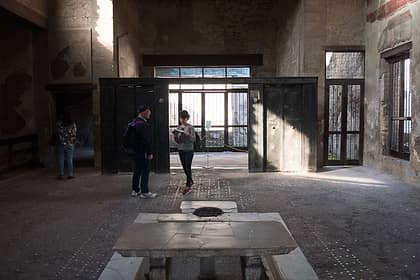
The name of this home comes from the wooden partition (tramezzo di legno) that survived the eruption and is still standing in its original location. This folding door separated the atrium from the rest of the room, lending the inhabitants privacy, and has a series of folding panels with brass handles and holders for hanging lanterns.
5. House of Relief of Telephus (7)
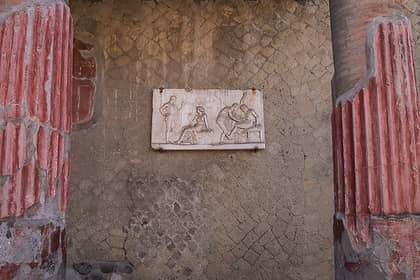
Built between 27 BC and 14 AD on the panoramic ridge overlooking the marina, this three-story home was decorated with a number of sculptures from the Neo-Attic school, including one with a relief of Telephus (Rilievo di Telefo), son of legendary found of the city, Hercules. The atrium is lined with columns supporting the upper floor, and the spaces between them were decorated with oscilla, or marble discs with reliefs of Dionysus used to guard against evil spirits.
6. Fornici (1)
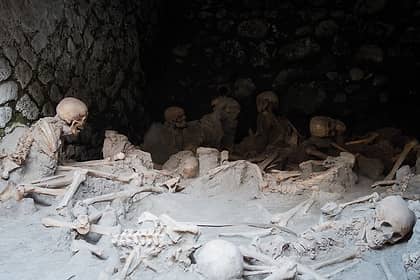
The fornici were the port warehouses (also used to shelter boats) located along the beach that was about 500 meters closer to the city in Roman times. In 1980, 300 human skeletons were unearthed here belonging to residents attempting to flee the eruption in 79 AD and killed by the scorching clouds of toxic smoke and ash created by the volcano. Along with their remains and personal objects like jewelry and coins, a nine-meter long Roman ship with skeletons of the rower and a soldier with his belt, two swords, chisel, and purse with coins were found.
Herculaneum Photo Gallery
FAQ - Frequently asked questions
Are the herculaneum ruins accessible by wheelchair.
The archaeological site of Herculaneum is accessible by wheelchair thanks to two paths on platforms. Bathrooms accessible to people with disabilities are also available.
Are the Herculaneum Ruins free for people with disabilities?
People with disabilities do not pay the ticket for the Herculaneum Ruins. Admission is also free for an accompanying person.
Is there a binding time for entrance tickets?
Skip-the-line tickets for the Herculaneum Ruins are valid for the whole day. There is, therefore, no entry time, but keep in mind that you can only enter the site up to an hour and a half before closing time.
Herculaneum: The Complete Guide
How to Visit the Archaeological Site of Herculaneum, Italy
:max_bytes(150000):strip_icc():format(webp)/ElizabethHeath-Headshot-horiz-e7525e97616245958bf3d94e8db7f119.png)
Creative Commons CCO
Archaeological Park of Herculaneum
Herculaneum is an archeological zone located at the foot of Mount Vesuvius in the town of Ercolano in Southern Italy. Named after its patron deity, Herakleia (Hercules), the wealthy seaside town (along with its more famous neighbor, Pompeii) vanished beneath a sea of lava from a devastating volcanic eruption in AD 79.
History of Herculaneum
After falling under the control of the Greeks in the 5th century BC, Herculaneum became part of the Roman Empire around 89 BC. Once a bustling seaside resort, its existence came to an abrupt end on August 24, AD 79 with the explosion of Vesuvius. Unlike Pompeii, which was buried in volcanic ash, Herculaneum was buried in a deep layer of molten magma, which engulfed nearly everything in its path.
It wasn't until the 18th century that excavations uncovered a large number of Roman houses. Unlike Pompeii, where it's estimated that 2,000 people perished along with most of the wooden structures, the fast-moving pyroclastic material that covered Herculaneum left behind buildings and domestic items remarkably preserved. Not all the residents had time to flee; some 300 Roman skeleton remains have since been found here.
The most notable home to survive is Villa dei Papiri (House of Papyri), which was the inspiration for the J Paul Getty Museum in California. The restored villa contains frescoes, mosaics, and the skeleton of a horse. It is currently not open to the public.
Designated a UNESCO World Heritage Site in 1997, much of what we know about Roman daily life was gleaned from artifacts unearthed at Herculaneum. Considered to be the most revealing ancient ruins in all of Italy, you'll see many of the antiquities extracted from Herculaneum at the National Archeological Museum in nearby Naples.
What To See and Do in Herculaneum
Wander around the excavated area, popping in and out of houses and peering into ancient public spaces. Here are some of the highlights to see in Herculaneum.
Step Inside a Typical Roman Boarding House: The Trellis House ( Casa a Graticcio ) is an outstanding example of a typical Roman boarding house. The structure was built of opus craticium: a typical half-timber and mortar technique used at the time. Incredibly, household items such as wooden beds, wardrobes, and even a portrait remained, providing a glimpse into a day in the life of average Romans.
Witness Intricate Tiling at the House with the Mosaic Atrium: The Mosaic Atrium house is believed to have been inhabited by Roman aristocracy due to its elaborately decorated interiors and a million-dollar position facing the Bay of Naples. But it's the floor that is the thing: a black-and-white checkerboard mosaic motif that covers a grandiose atrium.
Marvel at the Sculptures at the House of the Stags: Named for the sculpted group of male deer found inside, The House of the Stags ( Casa dei Cervi ) is a fine example of how the "other half" lived. There's an inner porticoed garden, a formal dining room, several bedrooms, and a shady arbor sporting enviable sea views.
Get a Peek of a Nobleman's Digs at the House of the Bicentenary: Buried deep beneath the rubble, the House of the Bicentenary ( Casa del Bicentenario ) was unearthed more than 200 years after excavation of Herculaneum had begun (hence, its name).
Tour the House of the Gem: The two-story House of the Gem ( Casa della Gemma ) was named after a piece of cameo jewelry found there. The carved shell bore the engraved effigy of Livia, wife of the emperor Augustus, mother of emperor Tiberius, and grandmother of emperor Claudius. That's some family tree!
See an Ancient Infographic at the House of the Relief of Telephus: Casa del Rilievo di Telefo contains a 1st-century relief that narrates the mythical story of Achilles and Telephus.
Enter the Garden at the House of Neptune & Amphitrite: Inside this fashionable home is a garden court with the colorful portraits of Neptune and Amphitrite for which the house was named.
Imagine a "Spa Day" at the Central Baths: Constructed in the first half of the 1st century BC, the bath complex is divided into two distinct sections: one for men, which includes a heated swimming pool or "tepidarium" (a bath with an underfloor heating system). The other sector was for women: quite a bit smaller, but much better preserved.
How to Visit Herculaneum
Location: Corso Resina, 80056 Ercolano
Hours: Herculaneum is open April to October, 8:30 am to 7:30 pm (final entry 6 pm), and November to March, 8:30 am to 5:00 pm (final entry 3:30 pm). Closed January 1 and December 25. Check the website for updates.
Prices: Adult one-day tickets cost €11. Young adult EU Citizens between 18 and 25 years old can purchase a one-day ticket for €5.50.
Visiting Tips: Herculaneum is compact and therefore much easier to tour than Pompeii, and less crowded as well. It can be explored with a map and an audio guide. Be careful when moving about and do not stand on the edge of the digs or climb the walls.
How to Get There: If you're arriving by train (which we recommend), take the Circumvesuviana line from Naples to Herculaneum (Ercolano Scavi station). It's a short walk from the station to the park entrance. If you're driving, there are parking lots near the entrance.
Nearby Attractions
Pompeii . Located 10 miles south of Herculaneum, Pompeii was a thriving metropolis until its demise by the Vesuvius eruption of AD 79.
Oplontis & Stabiae. Oplontis is best known for its Roman Villa Poppaea, a UNESCO World Heritage Site, and Stabiae for its remains of both an Oscan settlement (oppidum) and the later Roman town.
Antiquarium of Boscoreale. Another casualty of Vesuvius's wrath, the town, and archeological area is located on the slopes of Vesuvius, just north of Pompeii where its fertile lands were resettled after the eruption.
National Archeological Museum . Located in Naples, see Roman treasures recovered from Herculaneum and Pompeii, as well as Greek art, and works from the Farnese Collection.
National Archaeology Museum of Naples
The 14 Best Day Trips from Rome
The Top 10 Day Trips from Naples, Italy
Visiting Ancient Pompeii: A Visitors Guide to the Excavations
Visit the Amalfi Coast of Italy
Paestum: Planning Your Visit
Roman Amphitheaters in Italy
The Top Museums in Naples, Italy
48 Hours in Athens: The Perfect Itinerary
Borghese Gallery: A Complete Guide
22 Things to Do in Central Naples, Italy
The Top 23 Things to Do in Italy
Top 6 Tourist Attractions in Italy
The Best Time to Visit Naples, Italy
Italy UNESCO World Heritage Sites - Southern Italy
The 25 Top Attractions in Rome, Italy

Visiting Herculaneum: 13 Top Attractions
Written by Barbara Radcliffe Rogers Updated Dec 27, 2023 We may earn a commission from affiliate links ( )
Destroyed in AD 79 by the same eruption of Mt. Vesuvius that engulfed Pompeii, Herculaneum was buried in molten lava, instead of the ash that covered Pompeii. The town of about 6,000 people lay for centuries encased in a solid mass of pumice and ash to a depth of 12 to 30 meters.
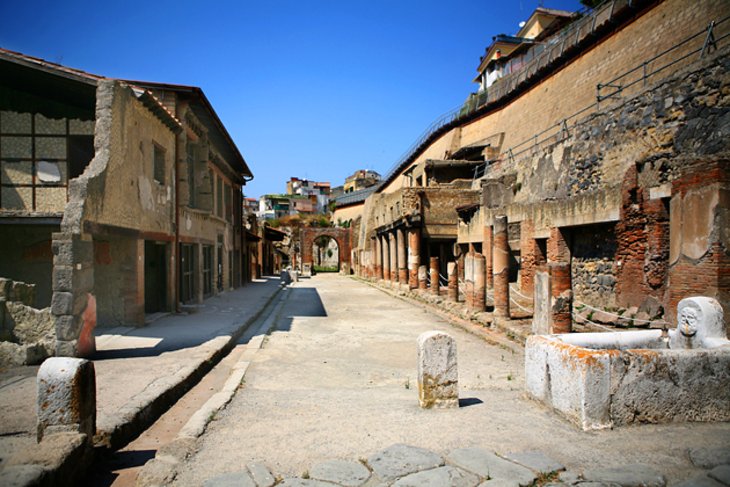
This hard, deep covering formed an airtight seal that protected it from plunderers and even from early excavation methods, saving artifacts and priceless details that have been lost at Pompeii. And unlike Pompeii, all but the very first finds and artworks have been left in their original places, not stripped for transport to off-site museums, adding to the experience of visiting Herculaneum.
In addition, instead of a sudden weight of falling ash that crushed roofs and collapsed houses in Pompeii, the fast-flowing lava filled Herculaneum from the ground up, supporting walls and roofs as it encased them. This preserved its multi-storied homes, complete with doors and staircases, as well as a wealth of organic material missing in Pompeii.
Wooden furniture, textiles, and even food and skeletons tell us much about everyday life here, and its vivid frescoes and mosaics remain intact. For these reasons, and because the site is smaller, less crowded, and the attractions are easier to explore, many tourists find visiting Herculaneum more interesting than Pompeii . The two ancient cities can be combined on a day tour from Naples , or Herculaneum is easily reached on a half-day trip from Sorrento .
See also: Where to Stay near Herculaneum
1. Casa dell'Albergo (Inn)
2. house of galba, 3. sacello degli augustali, 4. thermae (baths), 5. samnite house, 6. casa del tramezzo de legno (house of the wooden partition), 7. house of the neptune mosaic, 8. house of the bicentenary, 9. palaestra and shops, 10. house of the deer, 11. house of the relief of telephus, 12. suburban baths (terme suburbane), 13. the fornici, where to stay near herculaneum for sightseeing, tips & tactics: how to make the most of your visit to herculaneum.
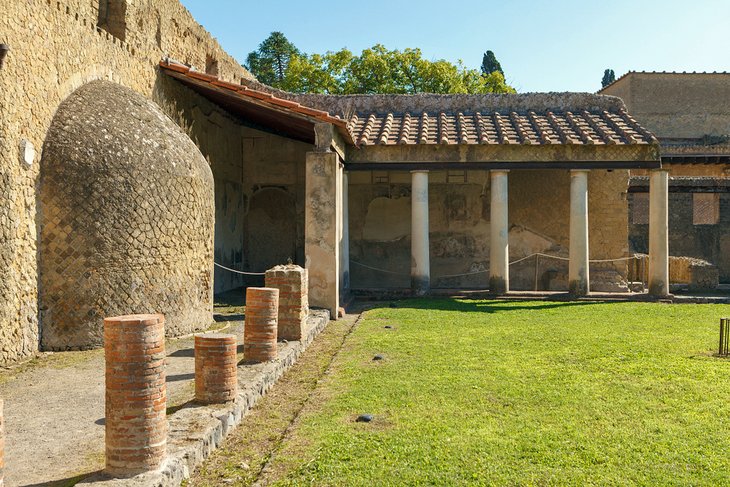
At the south end of Cardo III, which runs through an area excavated in the 19th century, Casa dell'Albergo filled almost an entire block. From the lines of columns that were once in its atrium, you can get a sense of the original size of this patrician house that was made into an inn.
Facing it on the other side of the street are the House of Aristides , a sumptuous country villa, and the House of Argus , with wall paintings and a garden with pillars. Farther along on the left is the House of the Genius, a fine patrician mansion with a garden enclosed by colonnades. Beyond the inn is the House of the Skeleton , with both wall paintings and mosaics.
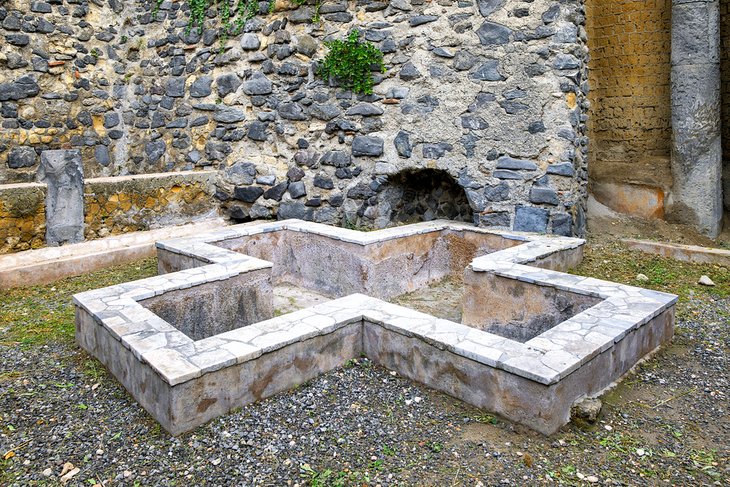
Halfway along Cardo III, the street is crossed by the Decumanus Inferior, beyond which is the House of Galba, on the left. Another fine patrician mansion, this one is interesting for its peristyle, which has a pool in the shape of a cross.
It might have been a reservoir, an ornamental fish pond, or intended for bathing, but it is unique in its shape. The area's original Doric columns were later covered in stucco. Beyond this house are more residences that are still unexcavated.
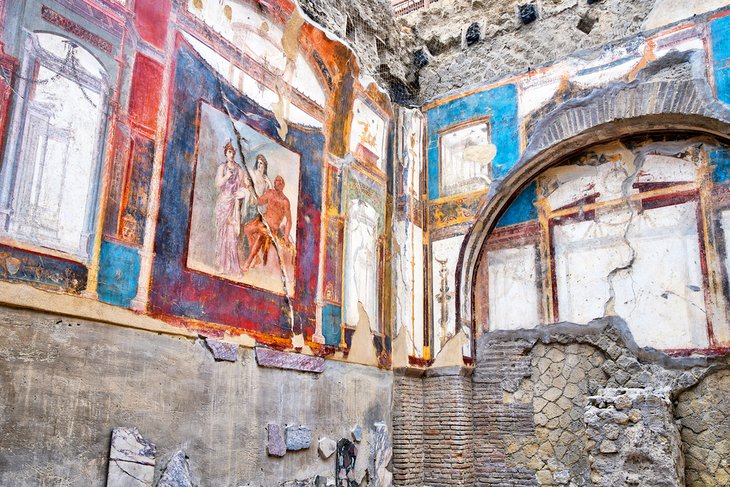
On the opposite side of Cardo III, at the end, the Sacello degli Augustali is a very large square shrine lit by an opening in the roof. It was originally dedicated to Hercules, patron of Herculaneum, for whom the town was named. It was later consecrated to the Imperial cult of Augustali, priests dedicated to the first Roman Emperor, Octavian Augustus, who was proclaimed a god after his death.
It has excellent frescoes, especially the one showing Hercules in Olympus with Juno and Minerva. Another shows Hercules fighting an Etruscan god.
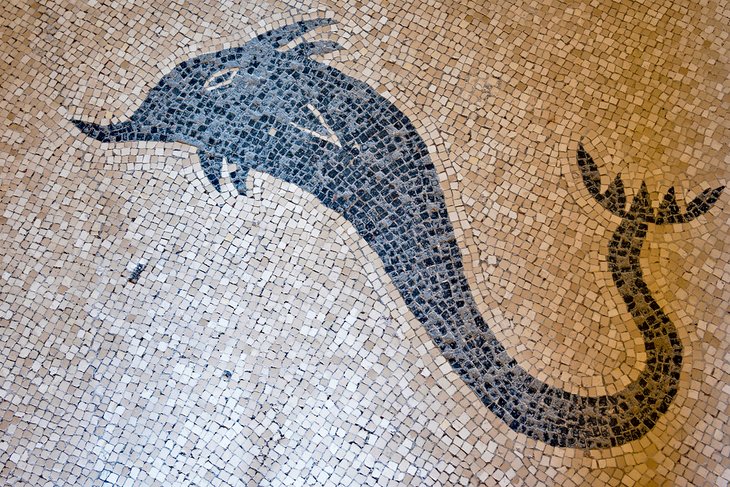
Among the more recent excavations along the Decumanus Inferior, on the left, are the well-preserved thermal baths, with separate sections for men and women. The men's domed frigidarium has a floor mosaic of dolphins, and the women's tepidarium floor, also in excellent condition, has a geometric pattern. Some of the wooden shelves are intact, as well.
Opposite the baths, across the Decumanus Inferior is the Cloth-Merchant's Shop , with a restored wooden press.
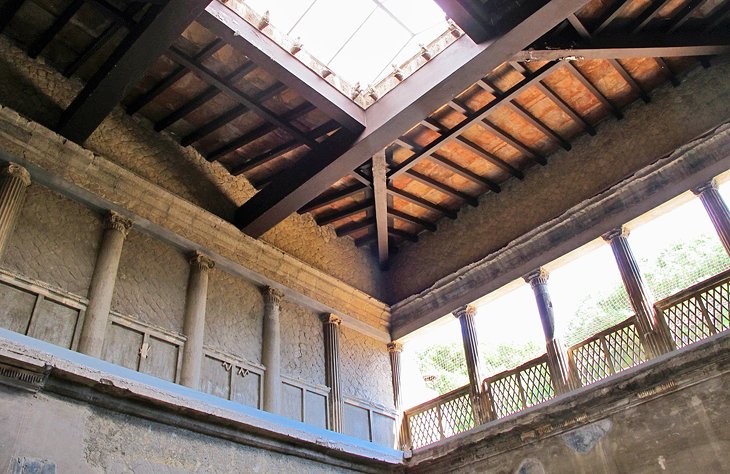
At the corner of the Decumanus Inferior and Cardo IV is the Samnite House, one of the oldest patrician mansions in the town. It was built in the second century BC, making it about 300 years old at the time of the eruption. The beautiful atrium is in the Greek style, with dramatic frescoes and a gallery lined by Ionic columns.
The atrium floors are of cocciopesto, a lime plaster mixed with ground terra-cotta, and there is a marble pool to catch rainwater. Throughout the house are rich stucco and fresco decoration. Be sure to look up to see the delicately carved tufa capitals.
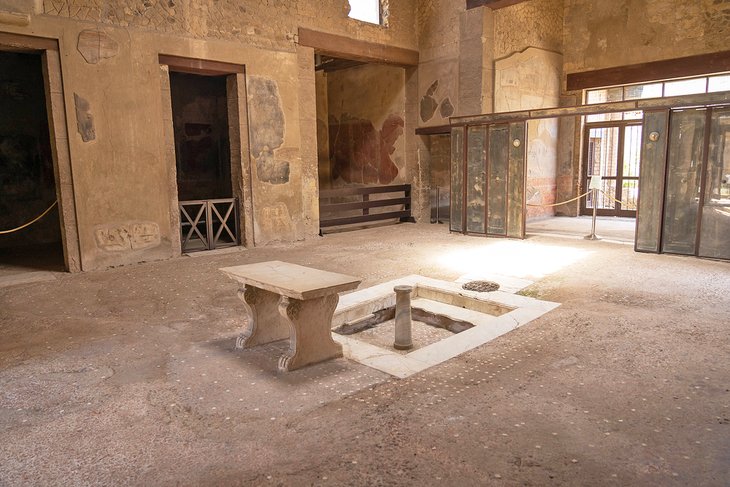
Diagonally across from the Samnite House is the House of the Wooden Partition , a patrician house of Samnite type but without a peristyle or colonnaded court. The name derives from the wooden partition that was still standing after the eruption.
The folding partition formed a wall of several hinged panels with brass handles, and was designed to give the bedrooms some privacy from the rest of the house. The bedrooms still contain bedsteads and a wooden chest. In the center of the central room is a small fountain with a marble bench.
The adjoining Casa a Graticcio was a more modest house with interior walls of wattle.
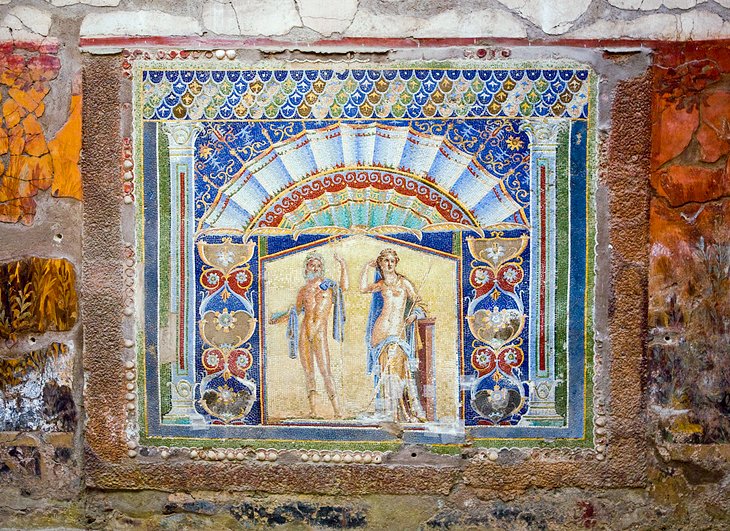
Farther up Cardo IV, on the other side of Decumanus Inferior, past the House of the Charred Furniture , is the House of the Neptune Mosaic. It is named for the well-preserved glass wall mosaic of Neptune and Amphitrite, one of a number of beautiful mosaics in this house, which evidently belonged to a wealthy family.
At the rear of the house is a courtyard with a nymphaeum, a grotto-like alcove with a fountain. On the wall beside the nymphaeum is the well-preserved mosaic of Neptune and Amphitrite, in vivid colors.
On the Decumanus Maximus, which parallels the Decumanus Inferior on the north and is still only partly excavated, the House of the Bicentenary contains one of Herculaneum's most fascinating mysteries. Stucco on a wall shows clear evidence of having once held a wooden Christian cross .
As St. Paul is known to have preached nearby, it is thought that this might have been a meeting place for early converts. If so, it may be the oldest known Christian cross. The house derives its name from the fact that it was uncovered in 1938, 200 years after excavations were started.
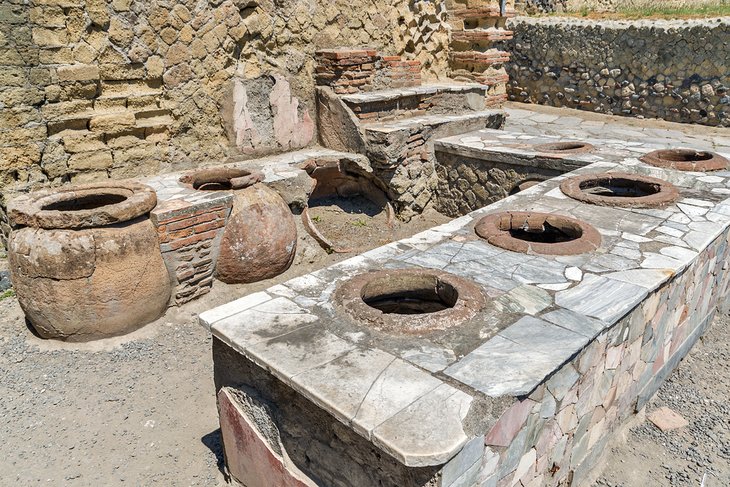
At the end of the Decumanus Maximus, Cardo V leads back past a series of shops, including a weaver's shop with looms; a dye shop with dye pots; and a bakery, in whose yard are ovens and mills for grinding grains. Also found here were bronze baking pans used for making flat bread. Along this street were a number of food shops, in which excavations turned up containers filled with walnuts and chickpeas.
The large area behind these shops was the Palaestra, a public field for games and other events.
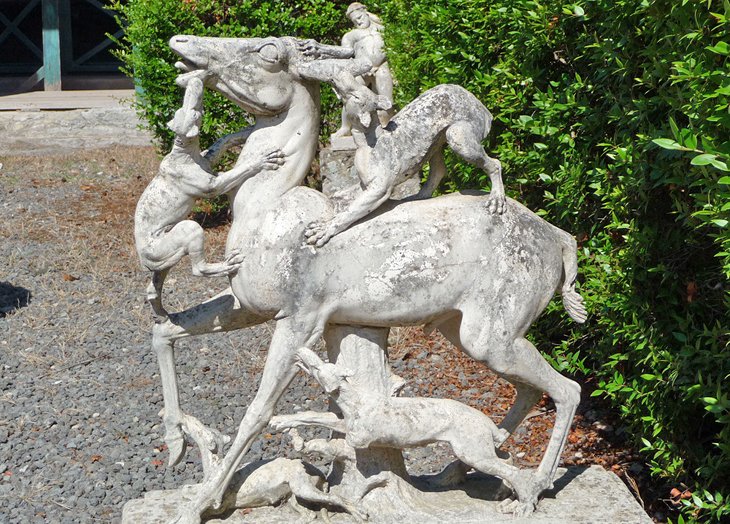
At the southern end of Cardo V, the House of the Deer was another luxury villa, with two stories built around a central courtyard. Notice especially its marble-chip and mosaic floors and frescoed walls. In the large garden, marble tables and deer statues were found, which are now preserved in the on-site museum. Marble replicas of those and other statues that were found here are displayed in the house.
Next to it is the House of the Mosaic Atrium , a spacious home with an unusual room divided into three naves, like a cathedral, the only one of its kind found here.
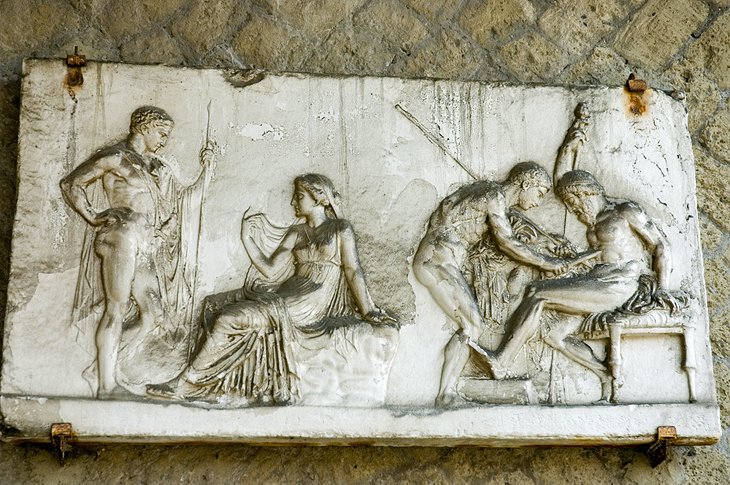
Opposite the House of the Deer, the House of the Relief of Telephus is one of the most elegant mansions in Herculaneum. In its spacious colonnaded atrium is a marble basin and a colonnade leading into the park, which sloped down to the marina.
The columns in the atrium support the upper floor of the three-story house. The original marble masks that hung between the columns have been replaced by cast replicas. The house is named for the marble relief, a finely worked piece in excellent condition.
At the edge of town near the ancient beach, the Suburban Baths are among the best preserved. Smaller than the central baths, they do not have twin facilities for men and women, so were either co-ed or used at different times.
The slate, mosaic, and marble floors; wall frescoes; and fountains are in good condition, although you can see some damage that was done by the force of the lava pouring in through the window. The House of the Gem , next to the baths, is beautifully painted in reddish-brown tones.
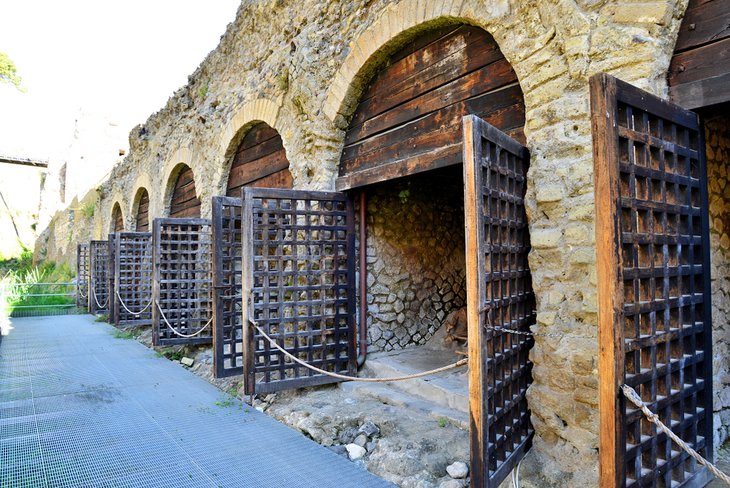
It was long believed that unlike Pompeii, Herculaneum's residents had escaped, as few human remains were evident in the town. But in 1982, further excavations at the port uncovered the skeletons of 300 people who had fled the city only to be incinerated by the sudden blast of extreme heat.
Perhaps the most dramatic sight in Herculaneum is at the Fornici, the warehouses at the port where boats were also kept. Fleeing the eruption, Herculaneum residents rushed here hoping to escape by boat, only to be enveloped by clouds of toxic smoke and volcanic ash before they could get away.
Along with the human skeletons, the Fornici excavations found the treasures these people hoped to save, including jewelry and coins, and a Roman ship nine meters long was found.
- Il San Cristoforo : Although it's a bit out of the center, this top-rated hotel offers a free scheduled shuttle to the railway station and archaeological site. The advantages of staying in this location are the spacious park-like grounds and gardens that surround the modern hotel, and the views of Mt. Vesuvius from some of the luxurious rooms. Breakfast and parking are free and there is a swimming pool.
- Andris Hotel : Also out of town and in the same price range, Andris Hotel is convenient if you're traveling by car. The peaceful location has views of Mt. Vesuvius, and rooms are spacious.
- Hotel Villa Signorini : In the same moderate price range , and a five-minute walk from the archaeological site, Hotel Villa Signorini occupies an 18th-century villa with an old-world atmosphere; breakfast and parking are both included.
- Hotel Herculaneum : This budget-friendly hotel is opposite the archaeological site and close to several restaurants. An excellent breakfast is included, and there are family-sized rooms. It's a five-minute walk from the train station.
- Ruins B&B : Sharing a reception area in a convenient location with the Hotel Herculaneum, Ruins B&B has budget-wise rooms , some with private terraces. Directly opposite the gates of the ruins, it is also at the stop for the minibus to Mt. Vesuvius. Breakfast is included.
- Tours of Herculaneum: A four-hour Herculaneum Tour from Sorrento provides round-trip transport by air-conditioned coach from your hotel in Sorrento and a tour of the ancient city led by an expert local guide. The two ancient cities can be combined on an eight-hour Pompeii and Herculaneum Day Trip from Naples , which includes round-trip transportation, a guided tour of Pompeii, a typical Italian lunch, and plenty of time to explore Herculaneum.
- For Your Comfort: Although there are quite a number of houses and other buildings to see in Herculaneum, these are much closer together than at Pompeii. Even so, expect a lot of walking on rough surfaces. Comfortable shoes are highly recommended. You'll find luggage storage at the ticket office.
- Getting Here on Your Own: The Circumvesuviana trains connect Naples and Sorrento, with two stops in Herculaneum. The Ercolano Scavi stop is a 10-minute walk from the entrance to the excavated area. There are shuttle buses, but unless there is a bus just loading, it's usually faster to walk.
- Address: Corso Resina, Ercolano NA, Italy
More Related Articles on PlanetWare.com
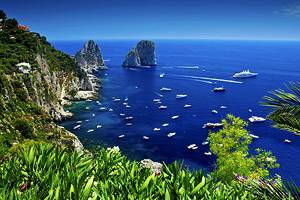
Where to Go from Herculaneum: Just a short drive or train ride away, the lovely town of Sorrento makes a good base for taking a ferry to the lovely island of Capri . It's also a good starting point for seeing the attractions of the Amalfi Coast .
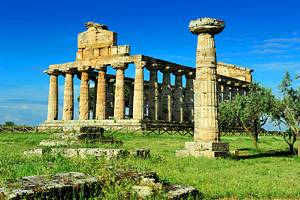
Exploring More Ancient Cities: If Herculaneum whets your appetite for more sites of the ancient world, begin with the other city destroyed by the eruption of Vesuvius in AD 79, using our page on Visiting Pompeii as a guide to the top sights. Not far south of the Amalfi Coast on the Gulf of Salerno are the well-preserved remains of the Greek city of Paestum , later occupied for 1,000 years by the Romans.
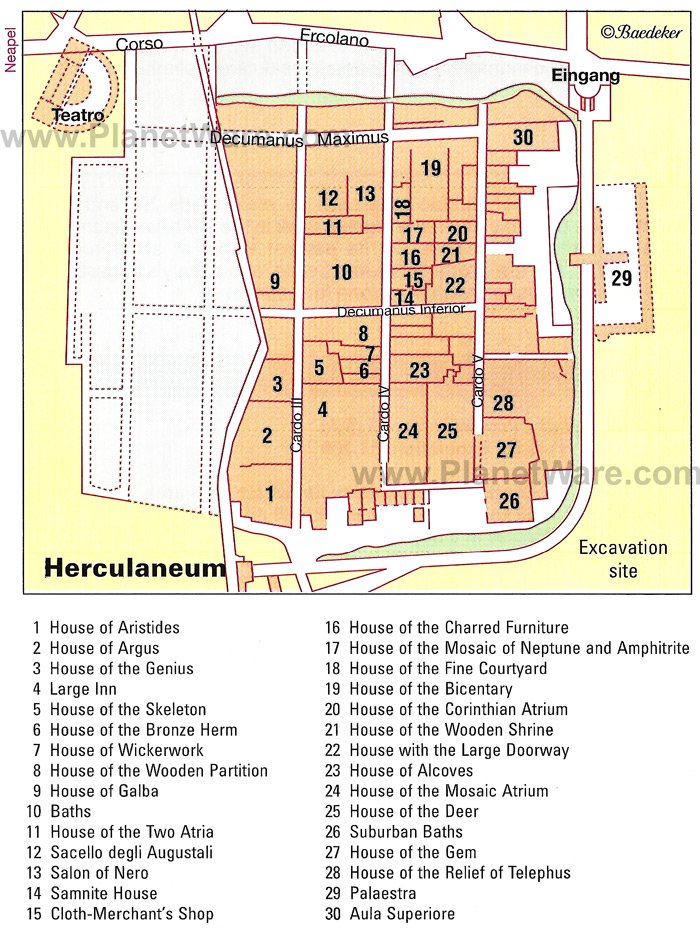
More on Italy


- What to see
Herculaneum
Herculaneum was an Ancient Roman city that suffered the same fame as Pompe ii when the volcanic eruption of Vesuvius buried it in the year 79 AD.
In the year 79 AD, Mount Vesuvius erupted and buried everything around it under more than 20 feet (6 metres) of volcanic ash . As in Pompeii , many citizens of Herculaneum weren't able to escape and the entire city was frozen in time by the lava .
What to see in Herculaneum?
Despite being smaller than Pompeii - which actually makes it much more manageable to explore ! - the ancient Roman town of Herculaneum was much wealthier, and examples of lavishly decorated villas can be found around the archaeological site.
Houses, public baths, taverns, temples and statues are almost perfectly preserved , giving unbelievable insight into what life was like for well-to-do families in the Roman Empire. It's even possible to see the frescoes and mosaics that still decorate the walls of the ancient mansions almost two thousand years after they were buried.
Unlike in Pompeii, the volcanic debris that covered Herculaneum was carbonized, which means organic-based materials like wood, food and even people were much better preserved . While some residents managed to flee the city, many didn't make it. A particularly striking area of the ancient ruins is the boat houses , where skeletons can be seen, buried alive while waiting for rescue from the sea.
A journey back in time
It may not be as famous as Pompeii, but Herculaneum is as fascinating and more beautiful as its ancient neighbouring city and is well worth a visit.
How to get to Herculaneum?
There are a few different ways to get to Herculaneum from Naples:
- Organised tour : this is the easiest way to get to Herculaneum and includes hotel pickup and drop off, and a guided tour, so you don't have to worry about transport at all. Book our Day Trip to Herculaneum .
- Train : catch the Sorrento Circumvesuviana train from Naples and get off at Ercolano Scavi. The journey takes about 15 minutes and costs around € 2 ( US$ 2.10).
- Rental car : this option can turn out to be cheaper and easier if you're travelling as a group and have other excursions planned to nearby sites. Check out our car hire prices here , but remember to factor in that most Italian roads are toll roads.
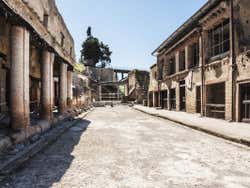
8 miles (13 km) south of Naples.
1 April - 31 October: 8:30 am to 7:30 pm 1 November - 31 March: 8:30 am to 5 pm Closed 1 January, 1 May, and 25 December
Adults: € 11 ( US$ 11.70) EU citizens between 18 and 25 years old: € 5.50 ( US$ 5.90) EU citizens under 18 years old and over 65 years old: free entry Combined ticket with Pompeii, Oplontis, Stabia, and Boscoreale Adults: € 20 ( US$ 21.20). EU citizens between 18 and 25 years old: € 10 ( US$ 10.60)
Herculaneum Tour € 69 ( US$ 73.40)
You may also be interested in
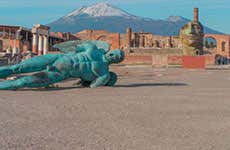
Pompeii was an ancient Roman city that was buried alive in the enormous volcanic eruption of Mount Vesuvius in 79 AD. Discover its fascinating history!
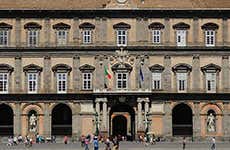
Royal Palace
Built when Naples was under Spanish rule, the Palazzo Reale is home to lavishly decorated royal apartments as well as a magnificently preserved theatre and chapel.
Take advantage of the search to browse through the World Heritage Centre information.
Share on social media
Unesco social media, archaeological areas of pompei, herculaneum and torre annunziata.
- Description
When Vesuvius erupted on 24 August AD 79, it engulfed the two flourishing Roman towns of Pompei and Herculaneum, as well as the many wealthy villas in the area. These have been progressively excavated and made accessible to the public since the mid-18th century. The vast expanse of the commercial town of Pompei contrasts with the smaller but better-preserved remains of the holiday resort of Herculaneum, while the superb wall paintings of the Villa Oplontis at Torre Annunziata give a vivid impression of the opulent lifestyle enjoyed by the wealthier citizens of the Early Roman Empire.
Description is available under license CC-BY-SA IGO 3.0
Zones archéologiques de Pompéi, Herculanum et Torre Annunziata
L’éruption du Vésuve, le 24 août de l’an 79, a enseveli les deux villes romaines florissantes de Pompéi et d’Herculanum ainsi que nombre de riches maisons de la région. Depuis le milieu du XVIIIe siècle, elles sont progressivement mises au jour et rendues accessibles au public. La vaste étendue de la ville commerciale de Pompéi contraste avec les vestiges plus restreints mais mieux préservés de la cité résidentielle de détente d’Herculanum, tandis que les superbes peintures murales de la villa Oplontis de Torre Annunziata donnent un témoignage très vivant du mode de vie opulent des citoyens les plus riches des débuts de l’Empire romain.
المناطق الأثرية في بومبي، هركولانيوم وتورّي أنّونزياتا
أدّى انفجار بركان فيزوفو في 24 آب/أغسطس من العام 79 إلى طمر مدينتي بومبي وهركولانيوم الرومانيتين المزدهرتين وكذلك عدد من المنازل الغنية في المنطقة. ومنذ منتصف القرن الثامن عشر، كُشفت تلك الآثار تدريجًا وأصبح الوصول إليها ممكنًا. كما أن المساحة الواسعة من مدينة بومبي التجارية تشكل تناقضًا مع الآثار الأقل عددًا ولكن المحفوظة أكثر للمدينة السكنية هركولانيوم، بينما تعطي الرسوم الجدارية الرائعة لفِلاّ أُبلونتيس في تورّي أنّونزياتا شهادة حيّة جدًا على نمط الحياة المترف للمواطنين الأكثر غنى في بدايات الامبراطورية الرومانية.
source: UNESCO/CPE Description is available under license CC-BY-SA IGO 3.0
庞培、赫库兰尼姆和托雷安农齐亚塔考古区
公元79年8月24日维苏威火山的爆发,吞没了两个繁盛的罗马城市:庞培和赫库兰尼姆以及那个地区的许多富家别墅。从18世纪中叶始,被掩埋的一切都逐渐挖掘出来并向公众公开开放。庞培商业城的广阔,与规模不大却保存完好的赫库兰尼姆假日胜地相得益彰,而托雷安农齐亚塔的奥普隆蒂斯别墅的壮丽壁画,呈现给我们一幅早期罗马帝国富裕的市民生活方式的生动画面。
Zonas arqueológicas de Pompeya, Herculano y la Torre Annunziate
La erupción del Vesubio ocurrida el 24 de agosto del año 79 sepultó las dos florecientes ciudades romanas de Pompeya y Herculano, así como numerosas mansiones de las comarcas circundantes. Desde mediados del siglo XVIII se empezaron a desenterrar sus ruinas paulatinamente y se hicieron accesibles al público. La vasta extensión ocupada por los restos de ciudad mercantil de Pompeya contrasta con el espacio más reducido de los vestigios, mejor conservados, de la ciudad residencial de Herculano. Las soberbias pinturas murales de la Villa Oplontis, situada en Torre Annunziata, son un vívido testimonio de la vida opulenta de los ciudadanos romanos más pudientes en los primeros años de la Roma imperial.
ポンペイ、エルコラーノ及びトッレ・アヌンツィアータの遺跡地域
source: NFUAJ
Archeologische gebieden van Pompeii, Herculaneum en Torre Annunziata
Toen de vulkaan Vesuvius uitbarstte op 24 augustus in het jaar 79, overspoelde het de twee bloeiende Romeinse steden Pompeii en Herculaneum met lava, evenals de vele rijke villa's in het gebied. De laatste zijn geleidelijk opgegraven en toegankelijk gemaakt voor het publiek vanaf het midden van de 18e eeuw. De enorme uitgestrektheid van de commerciële stad Pompeii staat in schril contrast met de kleinere maar beter bewaard gebleven resten van het vakantieoord Herculaneum. De prachtige muurschilderingen van Villa Oplontis in Torre Annunziata geven een levendige indruk van de overvloedige levensstijl van de rijkere burgers van het vroege Romeinse Rijk.
Source: unesco.nl
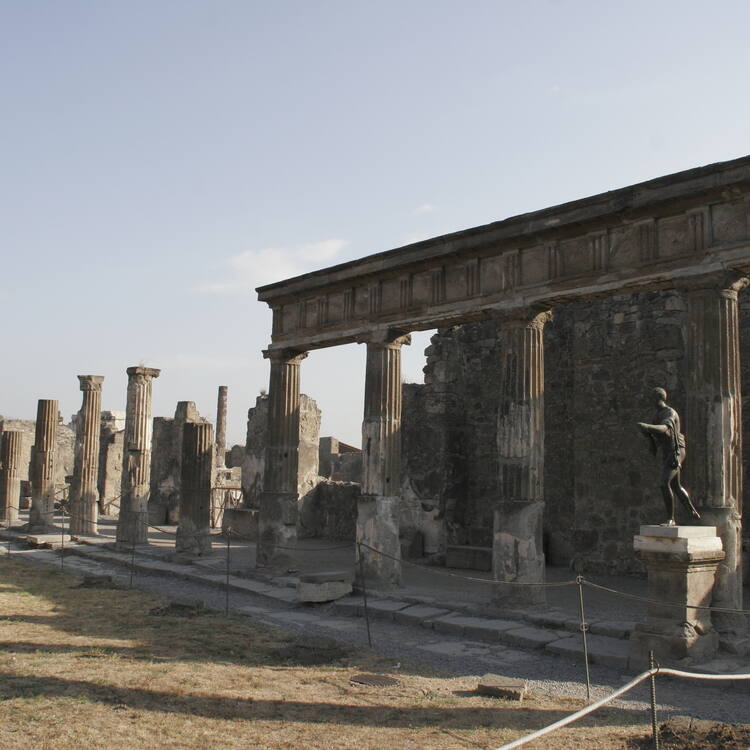
Outstanding Universal Value
Brief synthesis
The World Heritage property includes three different archaeological areas: the ancient towns of Pompeii and Herculaneum together with the Villa of the Mysteries (to the west of Pompeii) and the Villa of the Papyri (to the west of Herculaneum), and the Villa A (Villa of Poppaea) and Villa B (Villa of Lucius Crassius Tertius) in Torre Annunziata. The vast expanse of the commercial town of Pompeii contrasts with the smaller but better-preserved remains of the smaller Herculaneum, while Villa A in Torre Annunziata gives a vivid impression of the opulent lifestyle enjoyed by the wealthier citizens of the early Roman Empire.
When Vesuvius erupted in 79 AD, it engulfed the two flourishing Roman towns of Pompeii and Herculaneum, as well as the many wealthy countryside villas in the area. Pompeii was buried largely by a thick layer of volcanic ash and lapilli and Herculaneum disappeared under pyroclastic surges and flows. These sites have been progressively excavated and made accessible to the public since the mid-18th century. However, in the case of Herculaneum large areas of the ancient town still lie under the modern town and have only been explored and surveyed by the network of 18th-century tunnels that drew the attention of Grand Tour visitors, the basis still today for visiting the Herculaneum's underground ancient theatre. These areas are mostly not currently included in the World Heritage property.
Pompeii, with its well-preserved buildings in an excavated area of 44 ha, is the only archaeological site in the world that provides a complete picture of an ancient Roman city. The main forum is flanked by a number of imposing public buildings, such as the Capitolium, the Basilica and temples and within the city there are also many public bath complexes, two theatres and an amphitheatre.
In Herculaneum several impressive public buildings are well preserved, including a spacious palaestra accessed through a monumental gateway, two sets of public baths, one of which (Central Thermae ) is monumental and vividly decorated, the College of the Priests of Augustus, and a theatre of standard form. The Villa of the Papyri, outside the city walls, is an opulent establishment. The town is also noteworthy for the completeness of its shops, still containing equipment such as enormous wine jars.
Herculaneum’s urban districts and seafront display a higher level of preservation with noteworthy conservation of upper floors thanks to the pyroclastic material that buried the town. Organic matter was often carbonized by the high temperatures and exceptionally preserved finds include everyday objects such as foodstuffs, architectural elements and wooden furniture.
Both Pompeii and Herculaneum are renowned for their remarkable series of residential and commercial buildings, built along well-paved streets. The earliest is the atrium house, entirely inward-looking with a courtyard at its centre: the House of the Surgeon at Pompeii is a good example. Under Hellenistic influences, this type of house was enlarged and decorated with columns and arcades and equipped with large representative rooms. In its highest form, this type of Roman house, known from towns all over the Empire, developed into a veritable mansion, richly decorated and with many rooms, of which the House of the Faun and the House of the Chaste Lovers are outstanding examples.
The suburban villas across the Vesuvian area are perhaps even more exceptional in terms of the scale of their buildings and grounds, as well as their lavish decorations. The Villa of the Mysteries is an enormous residence just outside Pompeii’s city walls, developed from a modest house built in the 3rd century BC, named from the remarkable wall paintings in the triclinium , which depict the initiation rites ('mysteries') of the cult of Dionysus.
The two villas in Torre Annunziata are both extraordinary examples of suburban buildings in the countryside of Pompeii. The villa A, so-called “of Poppaea ”, is a huge maritime residence built in the middle of the 1st century BCE, enlarged during the Imperial period and under restoration at the moment of the eruption. It is especially well known for its magnificent and well-preserved wall paintings, one of the most important examples of Roman painting with their superb illusionistic frescos of doors, colonnades and garden views. On the other hand, villa B is an excellent example of villa rustica provided with rooms and spaces designated for market activities such as storage of amphoras and trading of locally produced foodstuffs, especially wine.
There were many changes to these buildings over time in response to changing circumstances of the owners; these include repairs and adjustments that were a response to the seismic events that led up to the AD 79 eruption and reflect a community living with changing environmental and economic conditions.
A special feature of Pompeii is the wealth of graffiti on its walls. An election was imminent at the time of the eruption, and there are many political slogans scrawled on walls, as well as others of a more personal nature, often defamatory. At Herculaneum, the volcanic deposits preserved hundreds of wax tablets, some of which conserve legal documents, and more than 1,800 papyri scrolls containing Greek philosophical texts were found at the Villa of the Papyri.
The diverse range of literary sources available in Pompeii and Herculaneum provides a picture of the final decades of these ancient cities and the image of socially complex and dynamic communities, representing exceptional evidence of typical ways of life in Roman society in the first century AD and the importance of texts in political and private life.
Other important sources of archaeological evidence are the human remains of those who died in the eruption. Pompeii witnessed an early archaeological experiment when plaster was poured into voids found in the volcanic material and which allowed casts to be made of the forms of the human and animal victims and other organic material. At Herculaneum, on the other hand, about 300 skeletons were discovered along the ancient shoreline. The study of these significant samples of victims from the towns provides insight into their health, lifestyles and death and a chance to compare the two data sets. The casts themselves are important resources as they contain both skeletal remains and evidence of 19th- and 20th-century archaeological practice.
Another important legacy of the twentieth century was the presentation of Herculaneum to the public as an ‘open-air museum’, perhaps Europe’s first, with buildings reconstructed based on archaeological evidence and displays of original objects within the archaeological site. This concept of ‘open-air museum’ had already been adopted in some buildings in Pompeii, as a medium to communicate the meaning of ancient spaces, at the end of the 19th century.
The impressive remains of the towns of Pompeii and Herculaneum and their associated villas, destroyed and yet preserved by Mount Vesuvius, provide a complete and vivid picture of society and daily life at a specific moment in the past that is unparalleled elsewhere. The rediscovery and history of these places as archaeological sites has captured the collective imagination century after century, shaping archaeological, art historical, conservation and interpretation practices in Europe and beyond.
Criterion (iii): Pompeii and Herculaneum are the only Roman cities ruins preserved in such an exceptional way and have no parallels in integrity and extent in the world. The villas in Torre Annunziata have the best preserved wall paintings of the Roman period.
Criterion (iv): The sites of Pompeii, Herculaneum and Torre Annunziata provide a full picture of Roman life from the 1st century BC to the 1st century AD through the urban, architectural, decorative and daily life aspects that have been preserved. The villa A in Torre Annunziata is the most significant example of suburban villa of the Roman period.
Criterion (v): The sites of Pompeii, Herculaneum and Torre Annunziata are outstanding examples of urban and suburban Roman settlements. They also provide a vivid and comprehensive picture of Roman life at one precise moment: the eruption of Vesuvius in 79 AD.
The inscribed property has an area of 98 ha, with a buffer zone of 1,726 ha. Owing to the eruptions, the archaeological remains are unparalleled anywhere in the world for their completeness and extent. The three parts of the property are of adequate size to contain the attributes to express its Outstanding Universal Value, except at Herculaneum where integrity would be improved by inclusion within the property, via a minor boundary modification, of the theatre and the largest part of the ancient town with its most significant public monuments still lying beneath the modern Ercolano, and known only through 18th century tunnels.
The individual components and ancient urban fabric are in overall good condition and the town plan, structures and setting with regard to the Vesuvius are still sufficiently intact. Some structures continue to be at risk of collapse or loss of decorative detail given the scale of active decay in archaeological sites of this size and nature where original urban infrastructure (drainage, roofing etc.) can only be partially reinstated. A property with such extensive ruins exposed will always require continuous and continuing maintenance.
Authenticity
Since the first discoveries, excavation, conservation, consolidation, restoration and maintenance works have been implemented on the remarkable remains of these sites with varying intensity. The sites show the evolution of archaeological practices, conservation techniques and approaches to presentation over the past two centuries. The level of reconstruction and the use of materials, such as concrete and steel utilized in restorations before the 1980s, would be approached differently today. More enduring techniques and materials have been progressively introduced. It may be argued that these early restorations have, in some cases, a historical significance of their own which should be safeguarded when they contribute to the overall coherence at an urban scale, as in the case of Amedeo Maiuri’s open-air museum at Herculaneum at its peak in the 1950s.
A general shift in conservation approaches in the 21st century is favouring authenticity; instead of concentrating on single buildings, conservation campaigns are focusing on entire districts of the ancient towns, consisting of one or more insulae, and so achieving a more coordinated and homogenous result.
Despite the nature and quality of earlier restoration and reconstruction works, the authenticity of the individual components and the ancient urban and suburban fabric as a whole is very high.
Protection and management requirements
The property was protected by the provisions of past Law No 1089/1939 and since 2004 is under the Legislative Decree No 42/2004 (“Cultural Heritage and Landscape Code”). The perimeter of the Pompeii site is protected by the Decree of June 10th 1929. Environmental legislation in the form of the Legislative Decree No 42/2004 extended this protection to a wider area. All buildings and excavation works within the modern towns around the sites must be approved by the relevant heritage authorities.
At Herculaneum, where most of the ancient city lies under the modern town, additional protection is offered by development restrictions of the high-risk zone of Mount Vesuvius and wider Regional territorial plans.
The Vesuvius National Park also provides additional layers of protection of the broader setting while the MAB Biosphere designation provides a framework to promote further coordination.
The 3 component parts are owned by the State and, together with the immediate surrounding areas, are managed by the Archaeological Park of Pompeii (also overseeing the villas in Torre Annunziata) and the Archaeological Park of Herculaneum, two autonomous institutions established recently as part of a broader ministerial reform which attempts to bring decision making closer to the sites themselves.
These local heritage authorities include technical/scientific (archaeologists, architects, restorers), security and reception staff. Annual visitor numbers at the sites exceeds two and a half million (half of these are estimated to be foreign visitors).
A major public-private partnership, the Herculaneum Conservation Project, has shaped conservation and site management and enhancement at Herculaneum since 2001. The ‘ Grande Progetto Pompei’ , approximately a 5-year project begun in 2012 with the European Union has, among other things, stabilized and conserved buildings in the areas of highest risk at Pompeii.
- Pompeii Official website
- Pompeii Facebook page (in Italian only)
- Pompeii Instagram account (in Italian only)
- Pompeii Sites Twitter (X) account (in Italian only)
- Pompeii YouTube Channel (in Italian only)
- Parco Archeologico di Ercolano - Official website (in Italian only)
- Ercolano - Parco Archeologico Instagram account (in Italian only)
- Parco Archeologico di Ercolano YouTube Channel (in Italian only)
- Ercolano - Parco Archeologico Facebook page (in Italian only)
State of Conservation (SOC)
- Czech Republic
- Falkland Islands
- Latin America
- New Zealand
- North America
- South Georgia
- Kilimanjaro
- Adventure Travel
- Archaeology
- City Guides
- Itineraries
- Portrait Photography
- Tips and Advice
- Travel Photography
- Travel Stories
- Unhelpful Guides
- Wildlife Photography
- Work With Me
An Unhelpful Guide to… Herculaneum Ruins
You’ve probably noticed that I’m a travel blogger and photographer, but if you’ve just found this site, you might not know that in my day job I work as a documentary producer-director . Last year I made a one-hour archaeology and science programme about the lost Roman town of Herculaneum for the Science Channel.
Contents (click to view)
I spent six weeks researching every aspect of Herculaneum’s history and archaeology in great detail, wrote a 25-page script, and then spent a week filming in Italy. So you might say I’m kind of an expert now, and am more than qualified to write a helpful guide to Herculaneum ruins for any traveller who might be planning to visit.
But you’d be wrong.
Because as usual when travelling for work, I learned almost nothing of any practical value. I can’t give you opening times or directions. I have no idea how much it costs to get in. I’m not even quite sure how to get there and I barely took any photos because I had my hands full of filming equipment. And although I can tell you a few fun things about pyroclastic flows and carbonisation (yeah, sexy, I know), none of it will help you in the slightest when it comes to researching your own trip as a tourist. At least, as long as Vesuvius remains dormant.
So instead of an informative top-10 article or fact-packed how-to post, here’s another one of my Unhelpful Guides , which won’t give you much practical information about planning a visit to Herculaneum, but might give you an entertaining behind-the-scenes look at life as a documentary producer on location.
Disclaimer: if you’ve read my other Unhelpful Guides you’ll know that what’s unique and special about them compared with most blogs (though by no means all) is that they contain absolutely no useful information whatsoever. But this one is a bit different because, having made a whole documentary about Herculaneum, it turns out that I do actually know a few things about it. That means a stray fact may slip in here or there. Sorry.
What are the Herculaneum ruins?
In case you didn’t know, Herculaneum is a Roman town near Naples in Italy which was destroyed by the famous eruption of the volcano Vesuvius in 79AD. If you haven’t heard of that, then I’m guessing you were the naughty kid in school. Maybe go away and read the Wikipedia page and then come back here to carry on.
If you have heard of Vesuvius, you’ll have heard of Pompeii , the famous town that was destroyed in the eruption. You might remember it from such greats as Romans history lessons, or maybe, if you were very lucky, Latin GCSE.
Herculaneum is just 10 miles from Pompeii and was also buried by Vesuvius, but for some reason Pompeii became super well-known and is now a major tourist destination while Herculaneum is still quite obscure.
Why? You may well ask. One theory is that it’s because Pompeii is where they made all those grim casts of victims’ bodies entombed in volcanic ash, which even in the 18th century, in a time before social media and rolling news coverage, made headlines around the world and put Pompeii on the map. It could also be because Pompeii is much bigger and tourists like to feel they’re getting value for money when they buy an entry ticket.
My personal theory, however, is that it’s simply because no one is quite sure how to spell Herculaneum.
You can visit both on a day trip from Naples , but if you visit Pompeii but skip Herculaneum, you’re missing out. Bigger, as it turns out, does not equal better – well, not when it comes to Roman towns, anyway. Herculaneum may be small but it’s actually far better preserved than Pompeii – because science. If you want to know more about exactly why that is, you’ll need to watch the documentary.
Those of you who get the Science Channel can actually do that here . But in true Unhelpful Guides style this is obviously only marginally useful information for everyone else. If you don’t have a subscription, tough luck, you’ll just have to stick with Wikipedia instead. It’s probably more factually accurate than my documentary anyway, so you won’t be missing much.
Getting to Naples
And so it was that on a sunny morning in July, I set off for Naples with Fabio, my Assistant Producer-slash-Cameraman-slash-Sound Recordist-slash-Translator-slash-Driver (in factual TV they like to make everyone do five people’s jobs at once, it’s called Opportunity). Sadly the days when TV crews consisted of about eight people including a producer, a director, a cameraman, soundman, camera assistant, researcher and someone to make the tea are now long gone.
Which means that when you’ve got this much kit, and the airport is one of those places where you have to get a minibus to the car rental pickup, you’re in for a wild ride.
We had to miss the first bus because although there were seats available, the pathetically small luggage space was already full of other people’s suitcases. By the time the second one arrived about 15 minutes later, the queue had filled up with more holidaymakers dragging unnecessarily large bags, and we had to use all the pointy elbows and angry British stares at our disposal to make sure that WE could get all our stuff on before someone tried to jump the queue.
At least this meant we had the entire bus to ourselves, though I was more than a little sweaty by the time we’d got everything off at the other end.
And our physical challenges weren’t over. If you’ve ever been to Naples you may remember that many of the buildings are 100-year-old townhouses at least six storeys high, with narrow stone staircases and almost never a lift.
Sensibly, the office had managed to find us somewhere that did have one, but it looked like this. Terrifying.
Quite apart from the fact that it looks like a coffin on rails that could fall off and plunge us to our deaths at any time, it was only just about big enough to take two very skinny people. We had a hell of a job trying to squeeze all the kit and our suitcases in, and then we had to press the button and race up the stairs to meet it at the top.
How to get to Herculaneum ruins
Herculaneum is about 30 minutes from Naples , so after spending the morning filming around the city we hit the road and headed southeast along the coast. If you don’t have a car there’s a train that will take you there too, but since we couldn’t possibly do that with kit, I have no idea how often it leaves or how much it costs. If you really want to know, Google it.
We aimed to get there a bit early so we could pop in and have a quick look round. Why? Because even though I was making a whole documentary on the place we didn’t have the budget for a recce day, and ruined Roman towns sadly don’t appear on Streetview.
What we also didn’t have the budget for, unfortunately, was more than a single day’s filming. It turns out the Italian archaeological authorities have twigged that they’re onto a money spinner, and merrily charge an arm and a leg and a pound of flesh for daily filming access. And can you blame them? It’s not like there’s another, cheaper Herculaneum just down the road. So why wouldn’t you cash in if you had the chance?
So we had just one day – ONE DAY! – to film all the scenes we needed. To help, the office had sent me a second crew – a crack team named Olly and Zara – whose job would be to race round the site picking up all the bits Fabio and I wouldn’t have time for. Like an archaeology version of Challenge Anneka, except with fewer jumpsuits.
Of course, if you’re not planning on filming a documentary, a day will be plenty for your visit to Herculaneum. More than enough. Aim for a couple of hours and you’ll be golden.
An early start to visit Herculaneum
If you want to avoid the crowds, it’s a good idea to get there nice and early. How about 5.30 am?
Ok, that might be just a touch early for you, as a tourist, but for us it was essential. Firstly, to make the most of our one day there, and secondly, because we needed to film some aerial shots and we didn’t want them to be full of people. There’s always a chance you might accidentally drop your drone on someone’s head, and that sort of thing is frowned upon. Plus a tourist attraction crowded with holidaymakers doesn’t exactly scream ‘abandoned Roman treasure’, does it?
So a 5.30 start it was, with a rushed breakfast of a sandwich and a can of diet coke because much to my great distress a decent cup of tea is almost impossible to find in Italy.
Still, the views were nice, and it was very peaceful.
Things to see at Herculaneum ruins
Brace yourselves, here comes the fact part. If that’s not what you’re after, you should probably skip to one of my other Unhelpful Guides instead, like this one about Canterbury , which is much less useful.
After we’d finished our drone shots we went down into the town with our Very Knowledgeable Expert™ to interview him about some of the interesting stuff there is to see in Herculaneum. Because even though it’s all ruined, and there isn’t a McDonalds or a TKMaxx, it’s still a pretty cool place.
As you can see, the town sits in a hole 25 metres below street level. In Roman times, that WAS street level, but when the volcano erupted it chucked out shedloads of ash and rock and other scorching volcanic gubbins and completely buried the place. Over time people forgot it was there, and it stayed locked in its time capsule for nearly 2000 years until it was discovered by accident in the 18th century by a worker digging a well.
The hole you can see in the photo above is what’s been carefully excavated by archaeologists – just imagine how much work it must have been to clear it all out!
What’s even more mind-boggling is that they’ve only cleared about 25% of the site. Three quarters of it is still buried under the modern town of Ercolano, which was built over the top before anyone remembered that there was actually a legendary Roman site underneath. Oops.
There’s still lots to see though – including villas, shops, and gorgeous mosaics. Herculaneum was a wealthy seaside resort where rich Romans had holiday homes – the French Riviera of the ancient world – so the houses here are all pretty impressive.
There’s plenty more finery on show in the small museum too, with loads of bling jewellery, statues, vases and more. Most of the really good stuff has been taken to the National Archaeological Museum in Naples , but you still get a pretty good sense of what life was like for the people who lived here.
Sometimes when we film in museums they open the cases for us so we can get a bit closer to the objects, but they were very strict here. Shame really, it would have been nice to slip a jug or a headless nude into the camera bag to put on the mantelpiece back home. Instead I had to settle for a fridge magnet from the site shop.
What’s fascinating about Herculaneum compared with Pompeii is that they found very few victims here. When we interviewed our Very Knowledgeable Expert™, he explained that when Vesuvius first started erupting, it spewed this column of boiling ash into the air and the wind blew it all onto Pompeii.
The people living in Herculaneum could see what was happening and had time to get their shit together and run away. Twelve hours later, the column collapsed and a pyroclastic flow of gases, ash and rocks rushed down from the volcano and smothered the town. It was so searingly hot and full of toxic gases that stuff didn’t burn (you need oxygen for that); instead the heat just made it instantly carbonise.
You can still see objects around the place that are made of wood from 2000 years ago!
Where to eat when you visit Herculaneum
After spending an hour trying to avoid the tourists and get shots without anyone walking right in front of the camera, it was time for lunch. There isn’t a restaurant on site, but it’s only a short walk back to the main street where there are plenty of places to eat. I can’t recommend any of them though, because when you’re carting loads of filming equipment around, a Short Walk becomes rather a Long Walk. So we ordered pizzas (because Italy, obvs) and sent our helpful Italian fixer to pick them up for us.
As you can see, Fabio was very happy to be allowed to sit down for 20 minutes. Don’t worry, these aren’t all for him – we were being supervised by a couple of Stern Minders™ whose job was to make sure we didn’t break anything that hadn’t already been broken by a volcanic eruption, so we bought them lunch too in the hope that might make them like us. Not sure it worked.
How not to become a tourist attraction when you visit Herculaneum
So at this point some of you might be thinking, ‘Why would I want to go to Herculaneum when there are cool dead bodies at Pompeii? I’d much rather go there!’ But if that’s the case, don’t worry. I know I said most people escaped Herculaneum, but not all of them did. Oooo, interesting!
In the 1980s archaeologists excavated these boathouses, and inside they found about 300 skeletons. These were people who made a bit of schoolboy error, and instead of leaving town they came down here to shelter from the earthquakes and falling ash, thinking it’d all be over soon and then they could go home again. Doh!
To be fair to them, that’s not quite as stupid as it sounds. In 79AD the people who lived in the shadow of Vesuvius had no idea it was a volcano. They didn’t have scientists and seismographs back then, you see, so they just thought it was a pretty mountain. They knew about earthquakes, but those always just shook the ground a bit, a few buildings collapsed, and then everything went back to normal. So when the ground started shaking they just went to hide out in these nice solid bunkers to wait it out. Fatal error… literally.
Now you might think 300 skeletons is interesting enough, but when we were there, there seemed to be something even more interesting: us . As we were filming, a noisy herd of Italian school kids showed up, absolutely fascinated by what we were doing. Like the stars of the horror movie The Birds they seemed to multiply, chattering away, getting closer and closer like some terrifying swarm of bees.
I don’t know if you’ve ever tried to film an important interview about Death with a Very Knowledgeable Expert™ while being ogled by 50 overexcited 10-year-olds, but it’s somewhat offputting.
To keep them from getting too close, our Stern Minder™ put a rope across the walkway and directed his disapproving looks at them for a bit, but it didn’t help that much. Being behind a rope observed by a large tour party only made me feel even more like a museum exhibit.
So if you want to avoid becoming a tourist attraction yourself at Herculaneum, maybe leave the professional TV camera and the Very Knowledgeable Expert™ at home. Also, wear clothes.
Behind the scenes on a visit to Herculaneum
One of the cool things about being a documentary producer is that you’re sometimes given access to places normal people don’t get to go. At Herculaneum we were allowed to film in a part of the site that’s not usually open to the public: the Villa dei Papyri. It was one of the largest and most palatial villas in the whole of the Roman Empire and it’s thought to have belonged to Julius’ Caesar’s father-in-law.
The Villa gets its name from the huge collection of papyrus scrolls that were discovered inside, thought to be the only surviving library from antiquity. These things are all black and charred and look like lumps of wood, but due to the unique conditions during the eruption they didn’t burn, and scholars have spent centuries trying to unroll and read them. So far, most of what they’ve found has been the rather mediocre works of an obscure philosopher, but they’re still hoping to find something cool, like an unseen essay by Plato, or maybe some Roman porn (of which there was a LOT, by the way. There’s loads at Pompeii… possibly a good reason to go there after all.)
We wanted to see where the famous papyri were found, so we went inside the tunnels dug by 18th century excavators. To be allowed to do this I first had to write a lengthy risk assessment, designed to make sure that what we weren’t doing wasn’t going to get us killed. Would we get poisoned by trapped gases? Might we drown in an undiscovered underground lake? Could there be an earthquake while we were inside, bringing the entire tunnel collapsing down upon us (a truly terrifying thought)?
I figured if these tunnels had survived since 1750, they were probably good for a few more months at least. So we took hard hats to prevent us from bumping our heads and… spoiler alert… we were fine.
Here’s a genuinely helpful fact: if you are going to Herculaneum, you can actually book tours of the Villa dei Papyri by appointment. Not sure exactly how, mind you, but if that’s something that interests you, maybe give it a quick google. You won’t be allowed in the tunnels though.
Other things to do around Herculaneum ruins
Once you’ve finished your visit to Herculaneum, here are a few other things you can do in the area, as personally tested and approved by me.
1/ Get stuck for 20 minutes behind an articulated lorry trying to do a 392-point turn to reverse into a tiny alleyway only marginally wider than the load itself.
2. Be the designated driver and take the team, the Very Knowledgeable Expert™, and a couple of his Italian archaeology friends out for dinner at a nice restaurant. Watch everyone else get drunk and blow the production budget while you fall asleep at the table due to having been up since 5 am.
3. Drive around the Bay of Naples looking for a spot to get a good shot of Actual Vesuvius. Fail to find one but find a nice place to take rather pleasing photos of Naples instead.
4. Eventually find a reasonable view of the volcano from a handy cafe where they say you can only come in and film if you buy something. Be forced to stop for half an hour and have a drink (oh no!) while you run a timelapse shot.
5. Head into the centre of Naples to do a bit more filming; find a director’s chair that seems just about within budget. And while you’re sitting in the inevitable traffic, read my posts about Naples .
6. Make a documentary, and then enjoy seeing your name in the credits 🙂
Further reading and watching
If all this has whetted your appetite and you’d like to find out more about Herculaneum, you can watch clips of the programme on the Science Channel’s Facebook page.
If you want to see the whole thing, you can watch it here: Unearthed: Vesuvius’s Secret Victim.
You’ll either need the Science Channel included in your subscription package, or a VPN like Hola (but you didn’t hear that last part from me!)
And if you enjoyed this post and want more behind-the-scenes stories, head over to my Unhelpful Guides .
If you liked this post, why not Pin It and share the love!
Bella is a multi-award-winning travel writer, wildlife photographer and science and history documentary director from London. Among many awards and nominations she won Blogger of the Year at the British Guild of Travel Writers’ Awards 2023 and Best Photography at the Travel Media Awards 2020. Her work has been published by National Geographic, Wanderlust, and BBC Travel among others. Her films have been shown around the world including on the BBC, Discovery and PBS.
Further Reading...
The Ruins Of Troy Turkey: How To Visit Homer’s Ancient City
Gordion in Turkey: City of King Midas and the Golden Touch
An Unhelpful Guide to… Tepoztlan Mexico
60+ awesome antarctica photography tips, 70+ stunning south georgia photography tips.
Some of the links on this site are affiliate links. This means that if you click through and make a purchase, I will earn a small commission at no additional cost to you. Passport & Pixels is a participant in the Amazon Services LLC Associates Program. As an Amazon Associate I earn from qualifying purchases.
Herculaneum, Italy: explore the ancient Roman site of Herculaneum near Naples

Visit Herculaneum
Herculaneum (known in Italy as Ercolano) is an ancient Roman town situated on the outskirts of Naples - it was buried by ash falling and subsequent lava flows after the eruption of Mount Vesuvius in 79 AD.
Less well known than Pompeii, Herculaneum is another important Roman town destroyed by the same eruption of Mount Vesuvius that has also been extensively excavated and is very revealing of the town 'frozen in time' 2000 years ago (although substantially smaller than the excavations at Pompeii).
Since the town takes its name from Hercules, from the Greek god Herakles, it is belived the town actually was an Ancient Greek town as far back as the 6th century BC.
Excavation of Herculaneum
The history of the excavation of Herculaneum has not always been a happy one, and early 19th century excavations exposed many interesting features and frescoes that have since disappeared. Likewise many excavated items seem also to have disappeared or been subject to investigation that led to their destruction.

Happily scientific techniques have improved a great deal in recent decades and work now proceeds more slowly - in fact often not at all, since funds are not available - but more carefully.
The work at Herculaneum is still very much a 'work in progress' and there is a great deal remaining to be excavated, a task not made easier by the very thick layer of ash and volcanic material that covered the site (20 metres thick, which is five times thicker than the debris that submerged Pompeii).
Herculaneum buildings and sites
Several houses, varying from grand townhouses to more humble lodgings, have been revealed in varying condition and it is possible to see many intact rooms and walls, frescoes and decorative mosaic floors and to walk along the original cobbled streets that passed between the properties.
Another highlight is the well preserved Roman Baths complex with the original mosaic floored marble baths surrounded by various carvings and murals.

One of the most unexpected discoveries at Herculaneum is the Villa of the Papyri , once home to Julius Caesar's father in law and a grand villa leading to the sea.
The name of Villa Papyri comes from the many written scrolls that have been discovered in the library of the house. Scientists are working on deciphering these but is is complicated because the scrolls were damaged by the heat and don't react well to being unrolled - so it is necessary to read them without unrolling them...not very easy!
There are also many 'small' highlights that add significantly to your visit - for example, the shops still have some of their fittings and the baths their wooden shelving, and remains of lead water pipes can be seen, small features that help to make it easier to see Herculaneum as a 'living town' rather than an archaeolgical site.

Skeletons at Herculaneum
Herculaneum is also known for the skeleton remains that have been found nearby on the sea front, which are believed to bee remains of people attempting to escape the lava flows.
These finds are important because the Romans usually cremated their dead, so skeletons are very unusual. Numerous of these skeletons have been found, and have proved effective at revealing more about the lives of citizens in Ancient Rome such as their dietary habits.
You can find more local travel ideas in the Campania guide .
Map of Herculaneum and places to visit
Herculaneum places to visit.

Mount Vesuvius
Mount Vesuvius is the volcano responsible for the destruction of Pompeii and Herculaneum in 79 AD.

A large and busy city, Naples also has many important historic monuments

Villa Poppaea
The Villa Poppaea is a sumptuous Roman Villa that was buried in the volcanic eruption that covered Pompeii and Herculaneum.

Pompeii was a bustling Ancient Roman trade town, completely submerged when Mount Vesuvius erupted in 79 AD

Marina Grande and Sorrento beaches
The coast of Sorrento, with the port of Marina Grande and several small beaches is interesting to explore

Sorrento cloister San Francesco
The cloister of San Francesco in Sorrento is a charming cloister, built in the 14th century and now often used for weddings
...or see all our recommended places to visit in Campania
Select your language
Site search

Cinque Terre
Italy This Way - copyright 2009 - 2024 :: privacy policy
Herculaneum Visiting Guide
Excavated Roman town which makes a great counterpoint to Pompeii
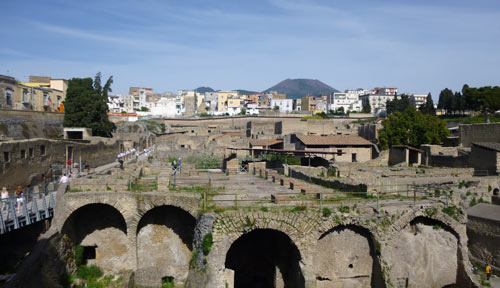
Herculaneum is a sister-site to Pompeii; a Roman town buried by the same eruption of Vesuvius which destroyed the larger Pompeii. Partly lying under the modern Naples suburb of Ercolano, the site of Herculaneum hasn’t been fully uncovered and is much smaller and more manageable to visit than Pompeii. Destroyed in a different way, by a pyroclastic surge which killed inhabitants, carbonised wood and left the city buried under 16-25 metres of rock, the archaeological site offers a different kind of insight into the Roman world. Here you’ll still see preserved wooden lofts, wine racks and bedsteads. Most of the furniture – from a baby’s cot to household shrines – is now conserved in storerooms, but a few pieces remain on the site to give an evocative impression of Roman life.
Many visitors prefer a visit to Herculaneum to a tour of Pompeii. The two archaeological sites are complementary and are both rewarding to visit, in different ways. I’d suggest visiting them over two days, along with a visit to the palatial ruined Villa Oplontis , nearby. Although it would just about be possible to visit both Herculaneum and Pompeii on the same day, I’d advise against it: you’ll be rushed and won’t be able to take everything in.
The site is included in the UNESCO heritage listing “Archaeological Areas of Pompeii, Herculaneum, and Torre Annunziata”.
About Herculaneum
When Vesuvius erupted in AD79, towns, villas and farms around the volcano were destroyed. Pompeii was buried under a layer of ash and pumice which was thinner than the covering over Herculaneum, and some of its residents (or looters) returned after the eruption to salvage valuables and sculptures. Herculaneum was preserved exactly as it was, and the different nature of its destruction has made it fascinating for archaeologists and for visitors. Discoveries of organic matter, of fruit, bread, wooden furnishings, writing tablets, upper floors, and even the contents of sewers, has helped with an understanding of Roman lifestyles and buildings. Herculaneum is thought to have been a relatively well-off small coastal town, quite different to the bigger, urban and more ‘ordinary’ Pompeii.
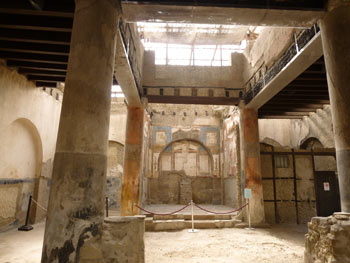
Herculaneum is much easier to explore than Pompeii. The archaeological site covers a small grid of streets, so it’s simple to cover these in a methodical fashion and keep track of what you’ve seen so far. Practical advice on preparing for a visit and getting to the site can be found below. From the ticket office, looking over the ruins, the nearest part below consists of round arches which were once on the seashore and would have been used for storing goods or boats. This is a good place to start your tour; a ramped passageway leads down and emerges by the arched vaults.
When these arches were excavated in the 1980s, archaeologists discovered what had happened to part of Herculaneum’s population. On the ancient beach and sheltered in the vaults were three hundred skeletons. Most of those under the arches were women and children, with male skeletons found on the shore outside. Perhaps they were sheltering or perhaps waiting for a deliverance which never came. Some of these bones are still preserved in-situ and are a poignant way to begin your exploration of a town whose life was cut off so suddenly on a summer’s day.
Once you’ve entered the ancient streets, as long as you have time I’d suggest just working your way around from one side of the site to the other. The site is basically composed of three streets heading north-east to south-west (at right angles to the seashore arches), with two streets crossing them. If you are in a hurry, there is a cluster of important and characteristic buildings towards the far end of the central street, and in the block which is then on your left.
Buildings at Herculaneum are labelled with a number and a name in Italian, which you can then look up using the site guide booklet or audio-guide. General features to look out for as you explore include the chances to see wooden upper floors, parts of decorative ceilings and wooden fittings such as racks for wine amphorae. Several handsome public water fountains, consisting of a tap hole, sculpted decorations and a trough, give an idea of the city’s practicalities and the civic pride its residents may have felt. On the central street (Cardo IV) a sign hanging between two buildings marks out the properties’ boundaries and owners. You can peer into shops, bars and bakeries and sometimes enter them; big stone vases set into worktops would have contained the food served up to customers who in Roman times would have obtained many of their meals out of the home. Many of the grander dwellings in the town had shops built into their street-facing façades, but once inside you enter a far more refined world where an imposing atrium or courtyard might be ornamented with a central pool, paintings around the walls and mosaics on the floor. The surviving exterior doesn’t always give a clue as to what treasures may remain inside, so poke around in all the buildings you have time to enter.
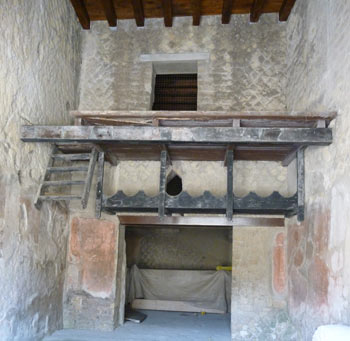
Highlights to look out for, if open include: – Hall of the Augustales (Sede degli Augustali) . A meeting hall for the priests of the Emperor Augustus, who were usually ex-slaves, decorated with remarkable surviving frescoes. Lofty and atmospheric. – House of Neptune and Amphitrite (Casa di Nettuno e Anfitrite) . This house has a wine shop outside with a wooden balcony, a screen and a rack for amphorae. In the residential dwelling behind, a dining area is decorated with beautiful wall mosaics including a famous image of Neptune and a nymph. Details of this were painted with gold. – House of the Wooden Screen (Casa del Tramezzo di Legno) . A grand house with a high-ceilinged atrium containing a marble basin to catch rainwater falling through the ‘skylight’ in the ceiling, and a reception area which could be closed off using a wooden screen; a remarkable survival. It’s a great glimpse into how the rich might actually have lived in their homes. Frescoes depict birds, vines, grapes and architectural fantasies. A bed or couch survives in a small adjoining room to add to the picture. – House of the Black Room/Salon (Casa del Salone Nero) . This luxurious house boasts a little courtyard garden, mosaic flooring and very fine wall paintings on a rather unusual black background, showing the variety of art favoured by Herculaneum’s inhabitants. The house is also evidence of the social mobility which was sometimes possible in Roman society; it is known to have belonged to a former slave who achieved the status of a Roman citizen. – Cucumas’s shop (Bottega ad Cucumas) . Cucumas’s shop, or inn, bears a wall painting by its entrance which announces the prices of pitchers of wine, along with illustrations. – Women’s baths (Terme Femminili) . Humbler than the men’s baths next door, but still elegantly decorated with a nautical floor mosaic, marble pool and marble benches. – Details such as shops, water fountains, grand doorways and lead pipes for the water supply will help give an idea of everyday life on the streets.
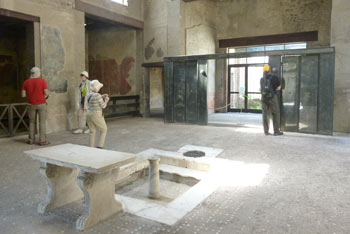
At any given time, certain buildings will be closed to the public. A list is available online and at the ticket desk. So, as with Italy in general, it’s best to approach Herculaneum with a positive attitude and get what you can from a visit while being prepared for possible frustrations. The famous Villa of the Papyri next door is unlikely to be open; this was where papyrus scrolls from an extensive library were dug up, along with a sculpture collection now in the archaeological museum in Naples.
Visit Herculaneum: practical information and travel
Herculaneum is open every day except 1 May, 25 December and 1 January. Opening hours are 8:30am-5pm between November and March and 8:30am-7:30pm April to September. Last admission is an hour and half before closing time. I’d strongly advise visiting the official Pompeii Sites website (see right-hand links panel) where you can check the latest opening times, prices and discounts, download advance information (more below) and also view the list of ruins which are currently closed to the public.
There is a choice of combined tickets for visiting Herculaneum and its sister sites. A ticket for Herculaneum alone costs €11 at the time of writing. The Pompeii sites (including Villa Oplontis, Pompeii and a couple of others) can be seen on a joint ticket for €22. Tickets can be booked online in advance. Check reductions for different age groups (e.g. 18-25) and Italian cultural initiatives for occasional free entry. Herculaneum is one of the free sites you can visit with a Campania Arte Card.
In theory, a map and an informative pamphlet should be available at the ticket desk. However, when I visited there were no pamphlets available and maps were only being handed out with the expensive audio-guide. I’d suggest downloading the useful information booklet in advance, and printing a map (see links panel, or look for “Maps and guide” on the official website). As well as being prepared for the cultural aspects of the visit, it’s a good idea to plan ahead and take water to drink and sun protection.
The archaeological site is ten-fifteen minutes’ walk from the Ercolano Scavi station of the Circumvesuviana train which runs from Naples to Sorrento ( scavi means excavations in Italian). From Napoli Garibaldi the journey takes seventeen minutes, and from Sorrento the travelling time is forty-eight minutes. If you time your travel to catch one of the rarer trains with limited stops, you can knock a few minutes off the journey. The trains fill up with tourists at Napoli Garibaldi so if you want a seat, you can try boarding at the Naples terminus, nearby Porta Nolana. At the time of writing a new, comfortable tourist express train called the Campania Express also runs between Naples, the Vesuvius sites and Sorrento, though this is more expensive.
Outside Ercolano Scavi station, walk a short way to the right to join the main road leading straight down towards the sea. Follow this road, crossing over a roundabout and continuing straight ahead down Via IV Novembre. At the end of the road is an archway leading to the archaeological site. There is very much a sense as you approach the site that Ercolano has been receiving tourists visiting its ruins for hundreds of years. Along the route you’ll find a choice of places to eat, drink and buy snacks, all very prepared for overseas visitors.
After heading through the gateway the route to the entrance lies down a walkway with a great view over the archaeological site. This makes it clear how deeply the Roman town was buried and gives an idea of how it extends under the modern suburb. The ticket office lies at the end of the sloping path. There are a couple of toilets here, and more inside the site. Through the ticket turnstiles, the access path leads along the seaward side of the site to a little building complex with a bookshop, audio-guide sales, toilets and a cafe with outside tables. Here is the actual entrance to the ruins.
I’d recommend allowing two hours or more for touring the site, though you could see highlights in less. Although I wouldn’t suggest combining Herculaneum with Pompeii (which covers a much larger area) unless you are really, really energetic and keen, it does work well in a day out with Villa Oplontis.
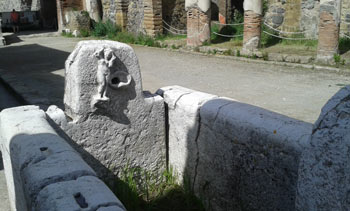
Where to stay
The most popular bases for a holiday including visits to the Pompeiian/Vesuvian sites are Naples – for a bustling city stay – and Sorrento – for an enjoyable holiday atmosphere. Some visitors, touring, choose to stay overnight in modern Pompei , which would be a practical option for combining the Roman sites over two days. Ercolano itself offers several choices. The nearest to the ruins is Hotel Herculaneum . > More accommodation in Ercolano
More archaeological sites to see
Pompeii and Herculaneum are the obvious Roman sites in the Vesuvius area. Villa Oplontis , also on the Circumvesuviana railway line and close to Pompeii, was a palatial Roman seaside villa which was partially destroyed by the eruption, and now makes a remarkable place to visit without the crowds of the two buried cities. The archaeological museum in Naples is unmissable if you’ve an interest in history and want to see the best discoveries from Pompeii and Herculaneum. Close to Sorrento, the Villa di Pollio Felice is very ruinous but has a breathtaking location on the sea’s edge; it’s also worth a visit if you’re staying in Sorrento.
> Pompeii > Villa Oplontis
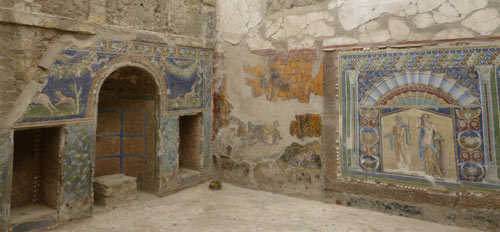
Visiting Pompeii
Villa Oplontis
Campania region destinations
Useful links
Naples hotels & B&Bs
Pompeii sites (official website)
Pompeii Sites: Herculaneum guide
Pompeii Sites: Herculaneum map
Circumvesuviana train
Herculaneum Conservation Project

How to visit Herculaneum (and 3 huge reasons why you should)
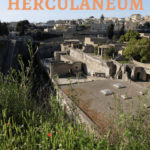
Visiting Herculaneum, a Roman city destroyed by the same volcano that engulfed Pompeii, is really rewarding. Here’s how to visit Herculaneum, and why it should be as much of a priority on your trip to Italy as seeing Pompeii.
Over 3.5 million people visit the ancient Roman city of Pompeii every year. Buried by tonnes of volcanic ash and rocks when Mount Vesuvius erupted in AD79, it’s one of the best-known tourist sites in Italy.
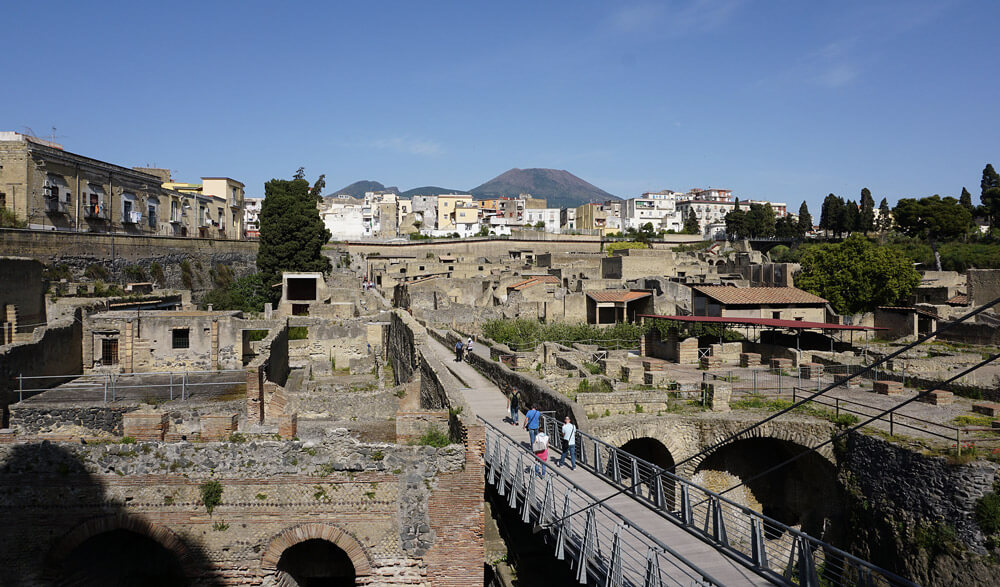
But there’s another Roman city just down the road from Pompeii that’s even better preserved and that receives only a tenth of the visitors that go to Pompeii. That city is Herculaneum, and it’s well worth a visit.
This post contains affiliate links – all this means is if you buy something as a result of clicking a link, I’ll make a small commission that helps me run this site. There’s no cost to you.
Where is Herculaneum?
Herculaneum, like Pompeii, was a Roman town on the coast of southern Italy, between modern-day Naples and Sorrento. You’ll find the ruins in the modern town of Ercolano. The ancient town actually extends underneath the modern one – what’s been excavated is probably only a small portion of what was covered when Vesuvius erupted .
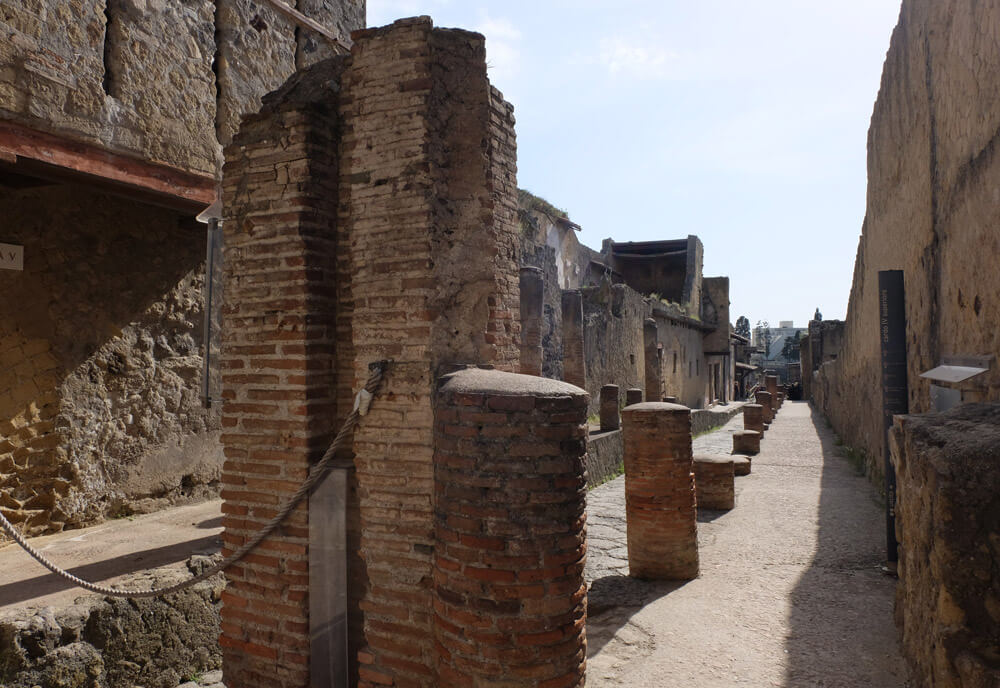
Herculaneum lies on the opposite side of Mount Vesuvius to Pompeii, and although they shared the same fate when the volcano erupted, they were destroyed in different ways; Pompeii by a 25-metre thick shower of falling rocks, Herculaneum by a lethal 100mph, 400°C pyroclastic surge of hot gas and ash.
Is it worth visiting Herculaneum?
I found Herculaneum just as fascinating as Pompeii. Here are some reasons why you should consider visiting Herculaneum.
Herculaneum is really different to Pompeii
The main reason to visit Herculaneum is because it’s so different to Pompeii. Don’t miss out on going to Herculaneum because you think it’s just a smaller version of Pompeii; it really isn’t.
Herculaneum is much better preserved than Pompeii
There’s a massive difference in the level of preservation at Herculaneum compared to Pompeii. When Mount Vesuvius erupted, the buildings in Pompeii were damaged by a deluge of falling rocks before being buried in lava and ash, meaning that very little survives above the ground floor, and virtually every building lost its roof.
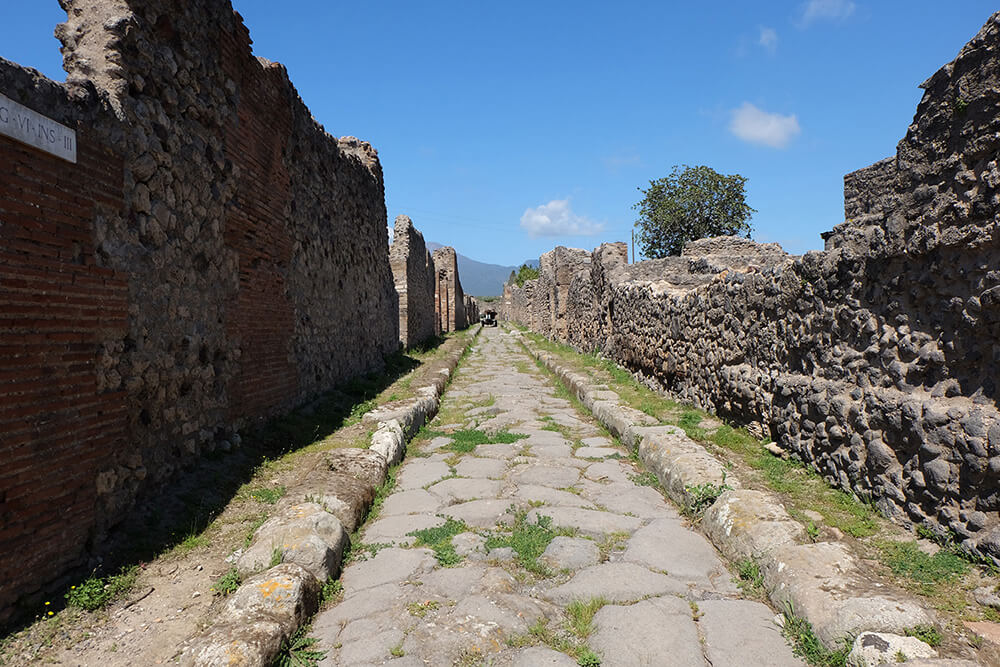
In Herculaneum, the town was buried almost instantly in hot ash. The buildings in Herculaneum are much better preserved than those in Pompeii; many of them have their upper floors still intact, and a couple even have their original wooden balcony. Unbelievably, some of the shops still have fittings.
Herculaneum was also a wealthier town than Pompeii, so many of the buildings you’ll see are more opulent and richly decorated. The mosaics and frescos are brighter, larger and more intricate here, a real treat for the eyes.
While you definitely can imagine yourself living in Pompeii as you walk its Roman streets, in Herculaneum the effect is really powerful. If you close your eyes, you can almost hear and sense the Roman life going on around you – it’s truly like a living museum.
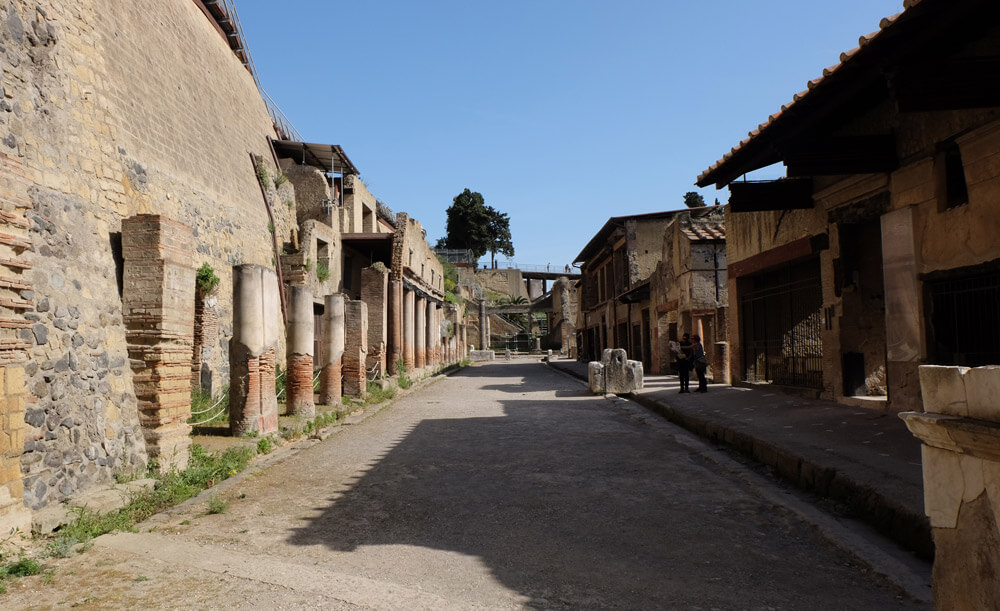
The fact that Herculaneum is better-preserved means that it’s much easier to make sense of how it worked as a town. In Pompeii it’s essential to take a guided tour to understand what you’re looking at; signs are few and far between and the grid layout makes it easy to get lost.
The excavated part of Herculaneum is far smaller than Pompeii, and each street has its own landmarks. The information signs and directions at Herculaneum are much better as well, and if you’ve taken a guided tour of Pompeii, there’ll be plenty that you’ll recognise from the other site.
Herculaneum is much smaller and quieter than Pompeii
Herculaneum gets around 300,000 visits a year compared to Pompeii’s 3.5 million, and while it is a much smaller site, the lower number of visitors gives it quite a tranquil feel. You won’t experience crowds at Herculaneum, or queues to see the most famous sights.
The sheer volume of hot ash which rained down on Herculaneum means that the modern town of Ercolano is at a much higher level than the ancient one, and as you walk down the long ramp into the ruins you’re surrounded by wild flowers and birdsong. It’s like stepping into another world.
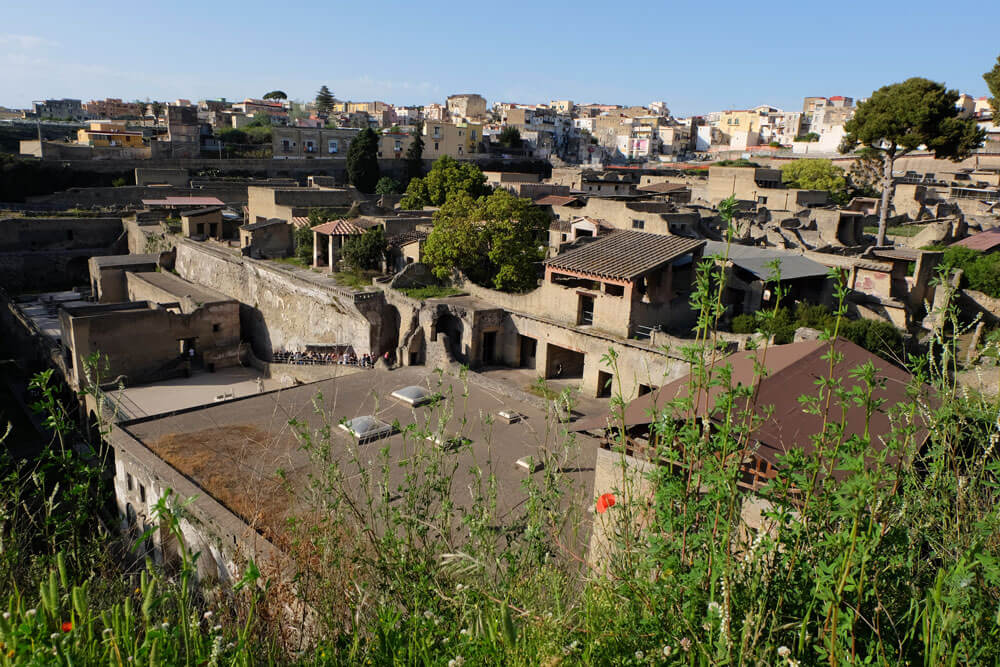
That tranquil feel, and the sense that the inhabitants have only just left, makes their deaths even more horrific. After you’ve seen the buildings where they lived, worked and socialised, you’ll reach the place where many of them died.
As you round the corner to the ancient beach (the eruption pushed the seafront 500m further out to sea) you’ll see the boathouses, and inside them, hundreds of skeletons. As these people sheltered in hope of being rescued by boat, an intense wave of hot gas hit the town. Until just a few years ago it was thought that they’d died instantly, their flesh vaporised. Unfortunately, more recent research suggests that they choked to death on the poisonous fumes as rising temperatures cooked their bodies.
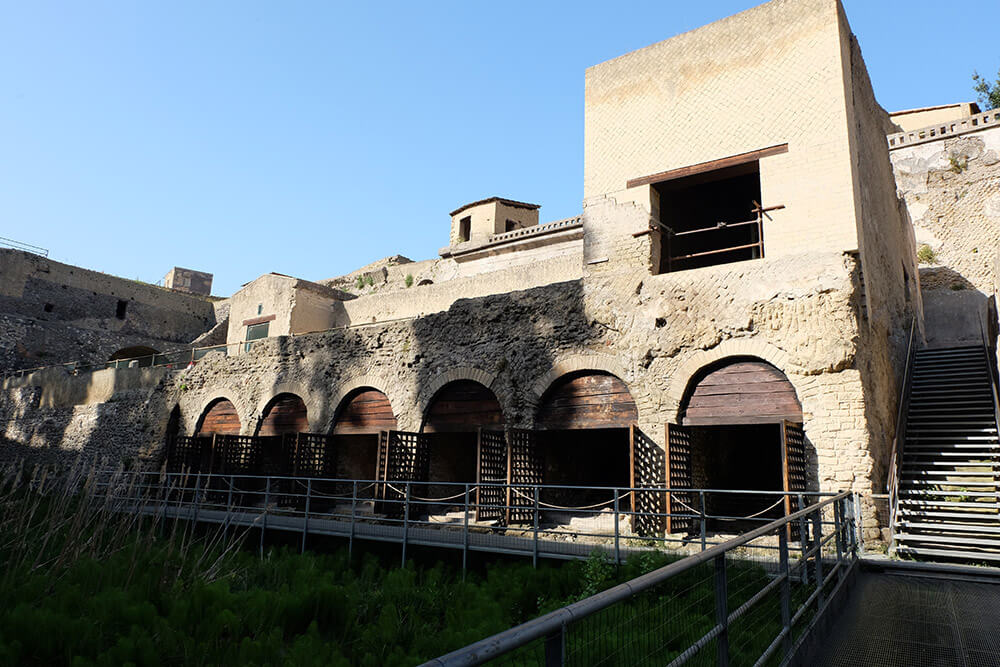
Which is better, Herculaneum or Pompeii?
It’s really difficult to choose between Herculaneum and Pompeii. If you’re interested in Roman history and what happened when Mount Vesuvius erupted, it’d be a real shame not to visit its most famous sight, Pompeii. Having said that, many people do prefer Herculaneum to Pompeii for its lack of crowds, stunning preservation and being able to see more sights in a shorter space of time with less walking.
If you’re determined to visit Pompeii, visiting Herculaneum as well adds a lot of extra richness to your trip, and it’s definitely worth visiting. It’ll give you a better understanding of what the buildings you saw in Pompeii would have looked like when they were complete, and a better feel for what the inhabitants’ lives were like.
The extra level of preservation at Herculaneum is absolutely amazing, and because it’s so close to Pompeii and so much smaller, it’s not too much extra effort to visit both. I do recommend visiting Pompeii before Herculaneum and taking a guided tour as it’ll help you understand both sites better.
Read more: Pompeii or Herculaneum – which site should I visit?
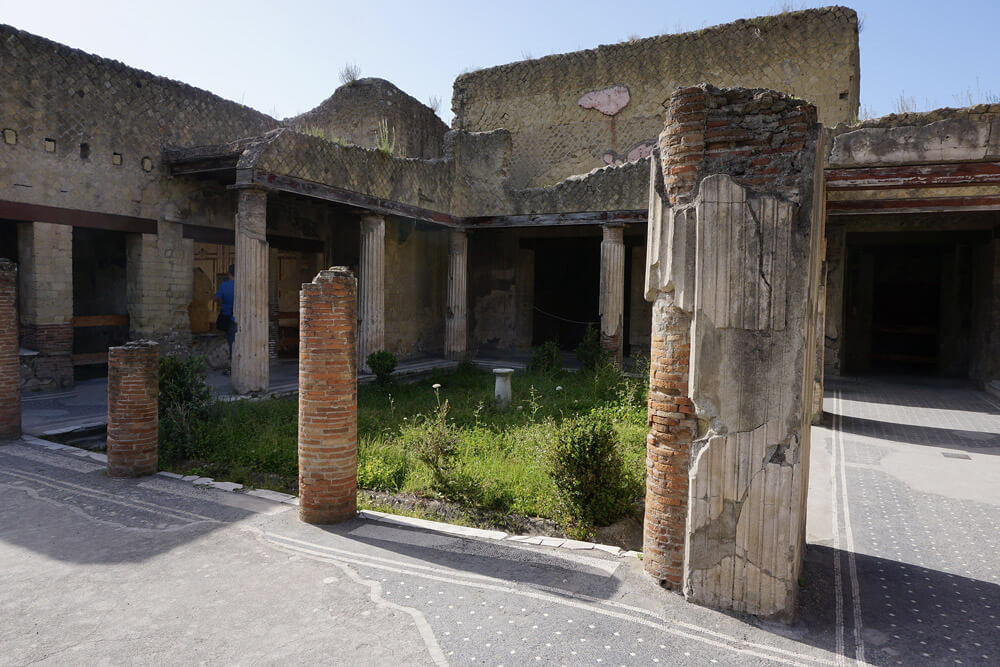
Can you see Pompeii and Herculaneum in one day?
It’s possible, but trying to visit both Pompeii and Herculaneum in one day would be exhausting. Pompeii is an enormous archaeological site, and visiting it is a lot like visiting a modern city, with the key sights spread out across the whole area. It’s definitely not a good idea to try and visit Herculaneum and Pompeii as a day trip from Rome – with the travel it’s just too much.
I also found visiting the two Roman cities where so many people died quite emotional; the casts of the bodies at Pompeii are really tragic, while the skeletons at Herculaneum are actually rather horrifying. I think visiting Herculaneum and Pompeii on the same day might be quite emotionally, as well as physically tiring.
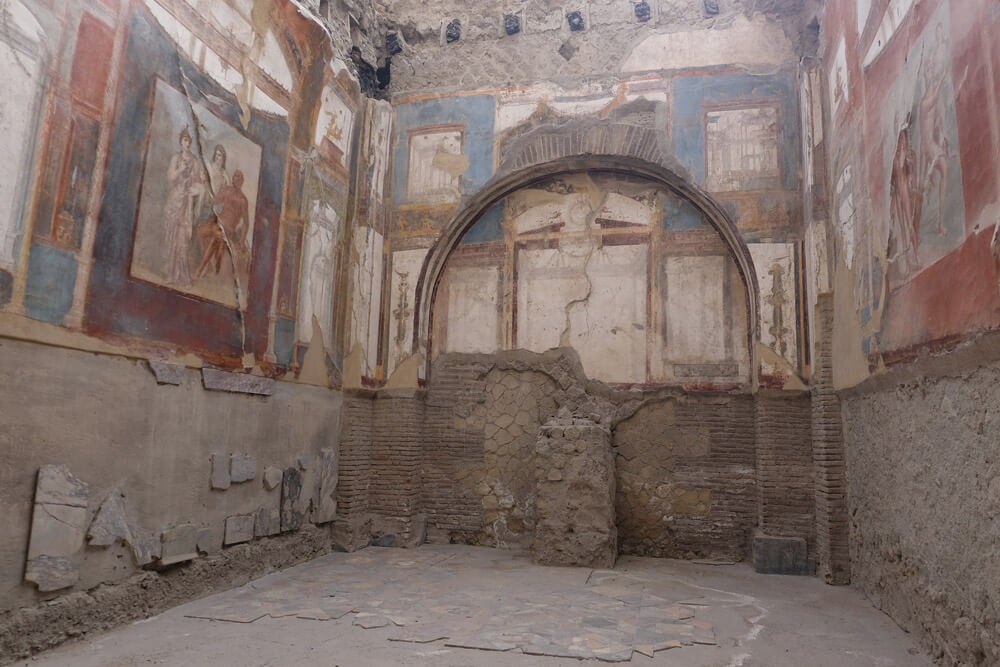
My recommended option for visiting Pompeii and Herculaneum is to first spend one full day at Pompeii, taking one of the official guided tours, then spend another day visiting Herculaneum and the crater at the top of Vesuvius. I spent around 3 hours at Herculaneum, leaving plenty of time to climb Vesuvius.
Getting to Mount Vesuvius from Herculaneum
Climbing Vesuvius is really easy from Ercolano (modern Herculaneum). Vesuvio Express buses leave from outside Ercolano train station (the same station that you’ll use to get the Circumvesuviana train to and from Naples and Sorrento) and take you up to the car park nearest the crater.
The buses depart at regular intervals, and give you around 90 minutes at the volcano – enough time to walk up to the crater, take a look around, and walk down again. A round trip transfer ticket is 12 euro per person, or 30 euro including a ticket for the hike up to the crater.
Read my tips for climbing Vesuvius
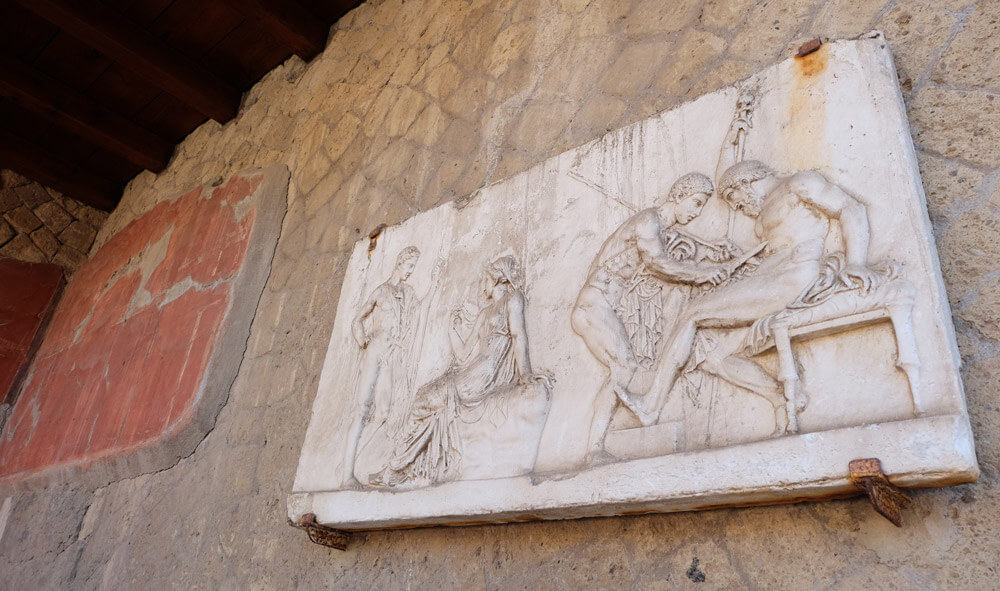
More things to do in Herculaneum (Ercolano)
Away from the main excavated site at Herculaneum, there are a couple of other interesting things to see when you go to Ercolano.
The MAV Virtual Archaeology Museum uses technology to bring the Roman cities of Pompeii and Herculaneum back to life. Through a series of interactive exhibits you can experience Roman life as it was just before the eruption. It’s an interesting way to get a different perspective on the ruins. It’s open 10am to 4pm, Tuesday to Sunday.
The Theatre of Herculaneum was the first trace of ancient Herculaneum to be rediscovered. In 1710, a man named Ambrogio Nocerino was digging a well and came across a 2,500-seat Roman theatre by accident. His find led to work starting on the excavations that we see today, but the theatre he found is still 20 metres underground, covered by the volcanic ash and accessible only by tunnels. It’s one of the best-preserved Roman theatres anywhere in the world.
Unfortunately, steep, dark tunnels and fragile historic buildings aren’t a great combination for a tourist attraction so it hasn’t generally been open to the public. However, the Theatre of Herculaneum did open in summer 2022 for an experimental series of guided tours. These didn’t happen in 2023 but the Ercolano website suggests that some dates will be announced for summer 2024.
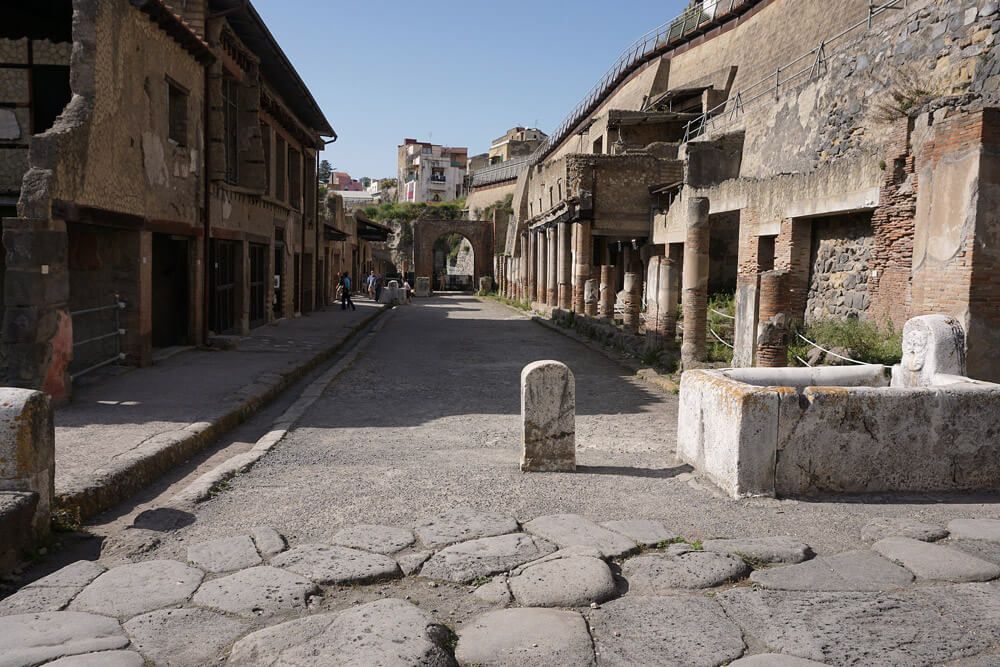
Practical advice for visiting Herculaneum in 2024
How to buy tickets for the herculaneum ruins.
Herculaneum is quieter than Pompeii and there’s usually no need to book tickets in advance. If you want to take a guided tour, I’d recommend booking that in advance as I didn’t see anyone offering tours on the spot like I did at Pompeii.
If you’re planning to go to Pompeii and Vesuvius as well as visiting Herculaneum, you can buy the Campania Artecard which will get you into both sites (plus a number of other sightseeing spots in the area) over the course of your visit.
There are five different versions of the Campania Artecard and it can get confusing comparing what’s included in each one, so I’ve put together a complete Campania Artecard review . I personally think that the Artecard Lite 365 is an absolute bargain if you’re spending a few days in the area.
Herculaneum opening hours
Summer hours for Herculaneum in 2024 are from 16 March to 14 October. In summer, the site is open from 8.30am to 7.30pm. The last admission is at 6pm, and visitors must leave the site by 7pm.
Winter opening hours start on 15 October 2024. For the winter period, the ruins at Herculaneum are open from 8.30am to 5pm, with the last admission at 3.30pm. Visitors must leave the archaeological area by 4.40pm.
It’s also closed on January 1st (New Year’s Day) and December 25th (Christmas Day). It’s free to visit Herculaneum on the first Sunday of the month, plus 25 April, 2 June and 4 November.
Please check these timings before your visit on the Herculaneum official website.
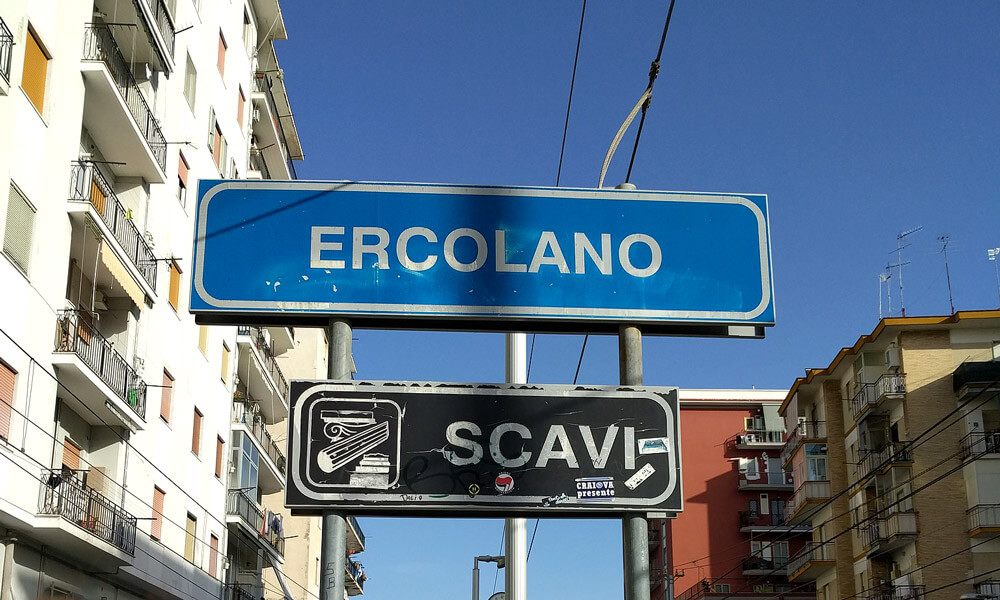
How to get to Herculaneum from Naples
The easiest way to visit Herculaneum from Naples is by taking the Circumvesuviana train from Napoli Centrale (Piazza Garibaldi) to Ercolano. The trains are a bit scruffy and get very crowded but run regularly. The Naples to Herculaneum train will take around 25 minutes.
To maximise your chances of getting a seat, try getting on at Porta Nolana station, one stop before Napoli Centrale. Get off at Ercolano Scavi station and walk straight down the hill towards the ruins. The walk from the station to the Herculaneum ticket office takes around 10 minutes.
Visiting Herculaneum from Sorrento
The journey from Sorrento to Herculaneum is another really easy trip on the Circumvesuviana train. Get on the train at the station in the centre of Sorrento and get off at Ercolano Scavi. The train from Sorrento to Ercolano takes around 40 minutes; at peak times there’s a train every 15 minutes.
When you get off the train, walk down Via IV Novembre towards the sea – the route to the Herculaneum ruins is reasonably well-signposted so you can’t go wrong. There are a number of shops, cafes and restaurants on this street as well so it’s easy to stop for a drink or something to eat either before or after your visit.
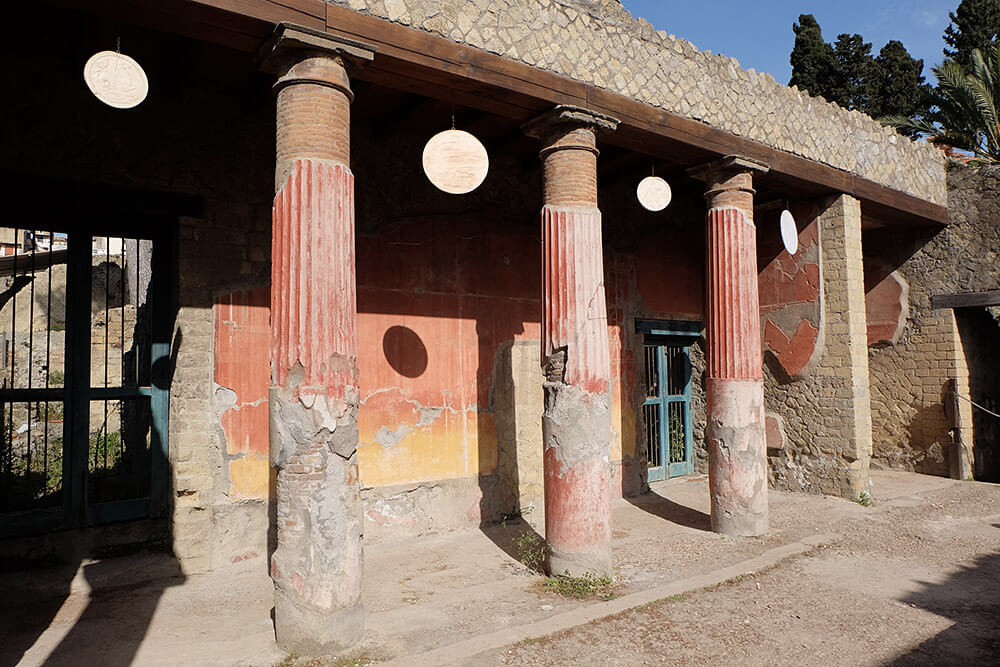
Can I take a guided tour of Herculaneum?
Guided tours are available at Herculaneum, but if you’ve done a tour at Pompeii and perhaps done some reading before your visit, I don’t think it’s essential – remember to pick up a paper map at the entrance though. Part of the reason for taking a guided tour at Pompeii is simply because of the scale of the site – there’s a really good chance that you’d get lost there without a guide!
At Herculaneum, the site is far smaller and the signage and explanations are also much better than at Pompeii. If you want a tour but you haven’t booked in advance, you can download the Ercolano app on iPhone or Android , or you can hire an audio guide from the ticket office at the entrance.
Facilities at the Herculaneum archaeological site
The ticket office at the entrance to Herculaneum includes a small museum, toilets, luggage storage and a bookshop. There’s also a vending machine for food and drink near the entrance. There’s no restaurant or cafe on site but there are plenty of cafes nearby.
If you’re driving to Herculaneum there’s no official parking for the site but there are public car parks nearby.
Large bags (bigger than 35 x 30 x 15 cm) need to be left at the entrance but luggage storage is free.
Where to stay when you visit Herculaneum
The best places to stay when you visit Herculaneum and Pompeii are Naples or Sorrento . Modern Ercolano and Pompei might be geographically closer, but they’re both working towns, and apart from the ruins there’s not much else to do for visitors.
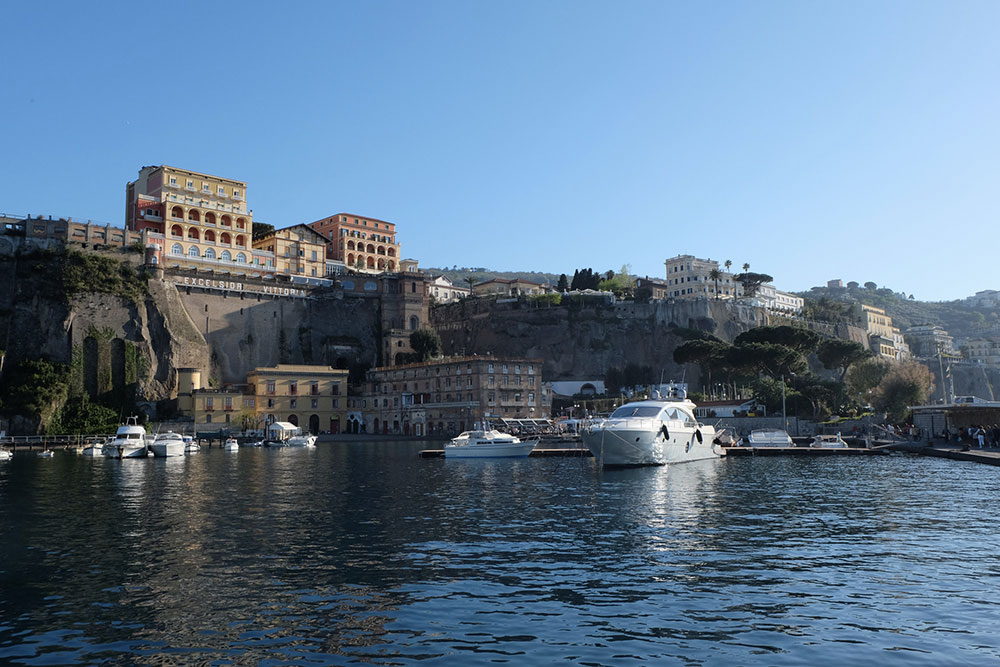
If you’re touring Italy and are short on time, stay in Naples. Naples has super-fast train services to Rome and other cities in Italy, and it also has an international airport. Naples definitely has a gritty reputation, but for convenience to get to and from Herculaneum and Pompeii, it can’t be beaten.
If you’re looking to build a relaxing vacation around your trip to Pompeii and Herculaneum, I’d recommend staying in Sorrento. Sorrento is at the end of the Circumvesuviana train line from Naples, which also stops at Pompeii and Herculaneum, making getting to both Roman sites really easy.
Read more about where to stay to visit Pompeii and Herculaneum
There are loads of things to do in Sorrento ; it’s a gorgeous town in its own right, and it’s particularly well-placed for day trips to Capri, Ischia , Procida and the Amalfi coast. Sorrento is also very welcoming for tourists, with a wide range of hotels, restaurants and bars, making it an easy, as well as scenic, option after long days spent exploring the Roman cities.
Related posts
If you enjoyed this post, you might find my other posts about places to visit near Naples useful:
- 12 tips for visiting the ancient Roman city Pompeii (plus how to climb Vesuvius)
- The best day trips from Sorrento
- The best places to stay to visit Pompeii
- The best things to do in Ischia
- How to get from Naples to Ischia by ferry
- Where to stay in Ischia – the best villages, beaches and hotels for every type of trip
- Visiting Ischia’s best thermal spa, Negombo
- How to visit Giardini la Mortella, a garden love story on Ischia
- Tips for visiting Castello Aragonese in Ischia Ponte
- Guide to visiting Procida, the tiny, beautiful island that’s a perfect day trip from Naples
- Amazing Roman ruins to visit
Would you visit Herculaneum?
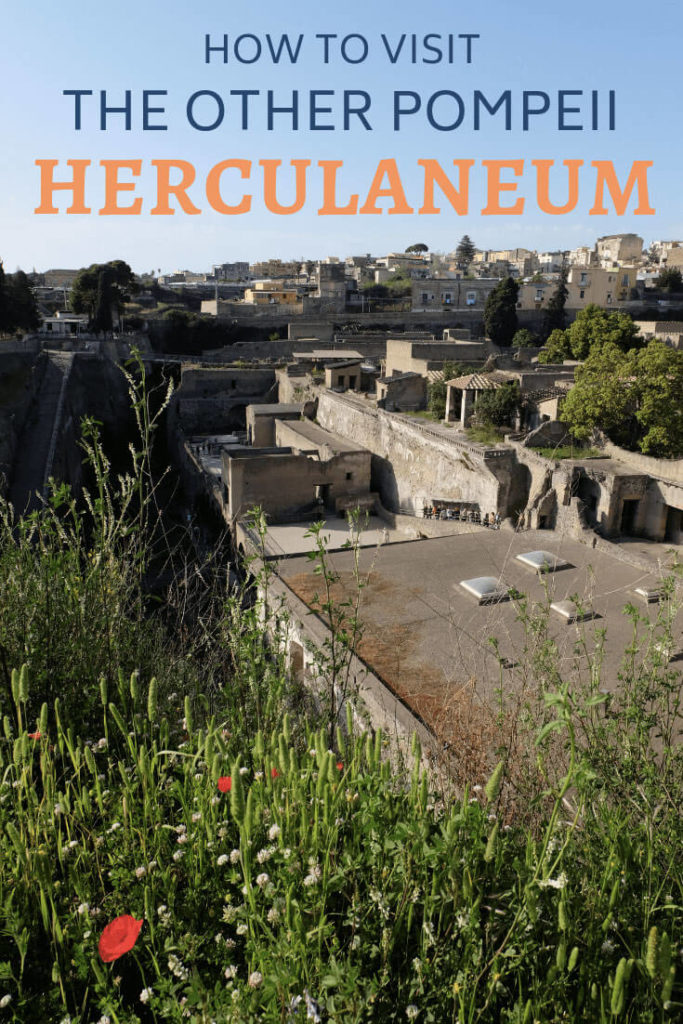
About Helen
Hi! I’m Helen , and Italy is one of my favourite destinations. I’ve been fascinated by ancient Roman and Greek history since I was a kid and I love nothing more than combining a visit to a Roman site with experiencing Italy’s beautiful landscapes and cities.
I live near Manchester, UK and work full time, so I’m all about making the most of my annual leave with day trips, weekend getaways and short breaks.
Save for later or share with a friend
20 thoughts on “How to visit Herculaneum (and 3 huge reasons why you should)”
Hi, I enjoyed visiting your site, very helpful, Can I ask you if you know if there is a ticket machine at Ercolano Scavi train station, Thanks
Hi Robert, glad you found it useful! I’m not sure as we bought return tickets from Sorrento to Ercolano, but I would think there would be a way to buy tickets.
thank so much for the informative post, I am planning a trip to Italy and never even knew about Herculaneum until I scrolled through your post about Pompeii and saw the following post Wow definitely on my list as I am over age 75 and know that I will be able to manage the smaller site
Thank you Heather, so glad it was helpful! If you do visit Pompeii then I’d recommend using the Porta Marina entrance as there’s a higher concentration of sights (the Forum, the arch of Nero, some temples and the Antiquarium museum) around that entrance compared to Piazza Anfiteatro which is closer to the large villas and the plaster casts at the Garden of the Fugitives. You might also want to look at the Pompeii for all route – it’s still 3.5km but it’s designed for wheelchairs so less tiring than walking on the uneven roads. I hope you have a wonderful trip to Italy!
This is actually really pretty, I didn’t know about this site. I’ve been looking for travel destinations for my wife’s birthday, and this looks like something she would enjoy much! We’ve been talking about Italy too, we’ll dedicate a day of our trip to visiting this ancient city. thank you!
Thanks David, hope you have a great trip!
Fascinating. We debated for a while when we were there as to which site to visit. We opted for Pompeii, and it was so crowded. After reading this, I am pretty sure for us, we made the wrong choice. If we ever get back, Herculaneum will be the top of our list
I don’t think there’s really a wrong choice as Pompeii is amazing, but I do really recommend a visit to Herculaneum 🙂
We went here a number of years ago instead of Pompeii. Very intense day. I think I’d like to go back and see Pompeii too. Herculaneum was quiet and hardly any crowds.
It’s amazing how quiet Herculaneum is isn’t it. I hope you get to see Pompeii too.
I just missed Herculaneum, arriving seconds after the ticket office shut and I was so cross with myself! I definitely want to get there soon. Your guide is super useful.
Oh no what a shame! I hope you manage to get back there and visit Herculaneum.
I love to explore historic sites and this place looks stunning. Thanks for the historic facts of how herculeam is differed from pompei. Will certainly visit this when I m in italy
Thanks Sinjana, if you’re into history then you’ll find both Herculaneum and Pompeii fascinating.
Thank you for this! I’m going to Naples later this year and am now thinking of adding Herculaneum to our itinerary!
I definitely recommend a visit to Herculaneum, it’s amazing to think of what else might be hidden underneath the modern town.
Couldn’t agree more that people should visit The Other Pompeii. Honestly, I never get tired of either one but agree that Herculaneum is a bit better preserved. Great post!
I do think people should go to both but then I love both so I would, haha. I think there’s lots of people for whom Herculaneum is a better option – Pompeii is amazing but it isn’t an easy place to visit if you’re not up for a ton of walking on those uneven roads and you’re not prepared to put a bit of work in to understand it. Herculaneum is a lot more accessible in every sense.
We plan to go back to Italy this year (Rome is my most favorite city in the world!), and I’ve always skipped Pompeii because of crowds. Thank you for this in-depth article about another, quieter option, as well as the suggestion to stay in Sorrento!
I visited Pompeii in April and honestly it wasn’t too bad. We got there mid morning and the key sights were busy but nothing that made our visit unpleasant. The site’s so big that if you step away from the main streets you can be on your own. However Herculaneum is significantly quieter and so interesting. I definitely recommend a visit!
Leave a comment Cancel reply
Save my name, email, and website in this browser for the next time I comment.
This site uses Akismet to reduce spam. Learn how your comment data is processed .
Matosinhos: the beach town with golden sand near Porto
11 fun day trips from manchester.

Herculaneum
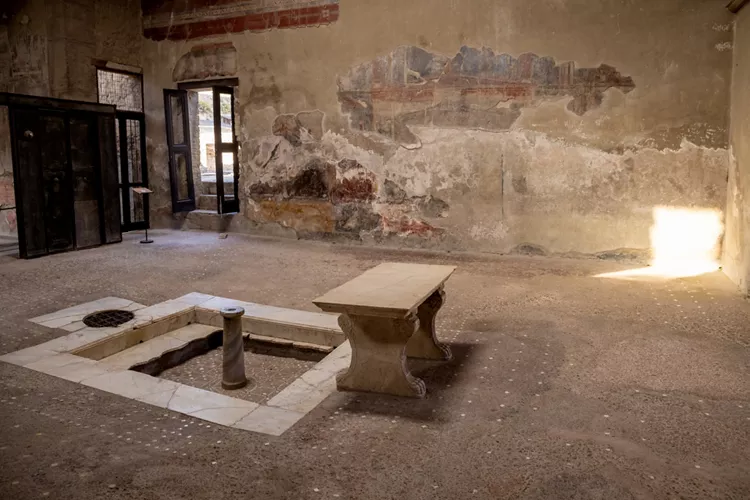
Herculaneum History, traditions and daily life
Herculaneum, together with Pompeii and Oplontis, is part of the UNESCO World Heritage Site and perfect testimony of life in a typical Roman city. Founded according to legend by Hercules, it was buried by the eruption of Vesuvius in 79 A.D. Herculaneum attracts a great many visitors every year to its succession of streets, villas, shops, spa buildings and places of worship. A place of memory that preserves a priceless cultural heritage, an example of a historical period characterized by its lifestyle and its daily life.
Full price 13 €
Reduced (young people 18-25) 2 €
Ticket Office
80056 Ercolano, Metropolitan City of Naples, Italy
Related articles
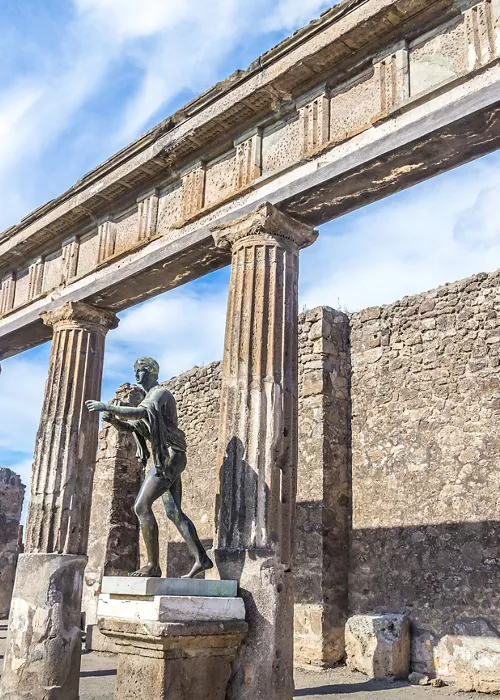

Discovering the archaeological area of Pompeii, Herculaneum and Torre Annunziata
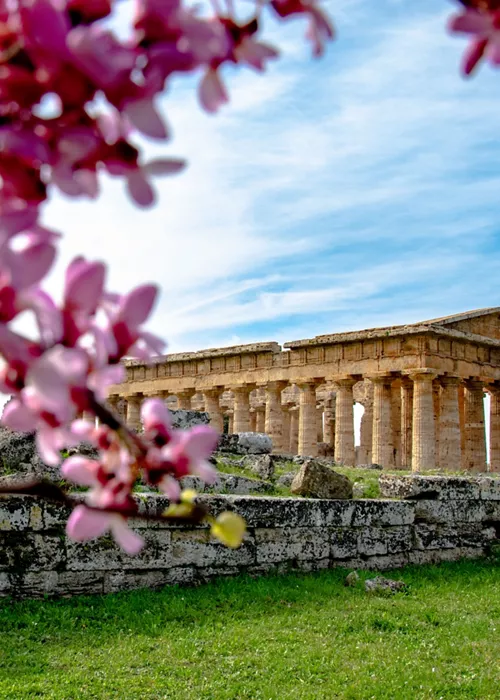
Cilento, between unspoilt beaches, wild nature and charming hamlets
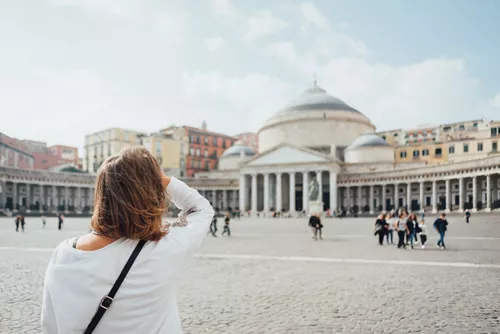
The enchanting historic centre of Naples UNESCO World Heritage Site
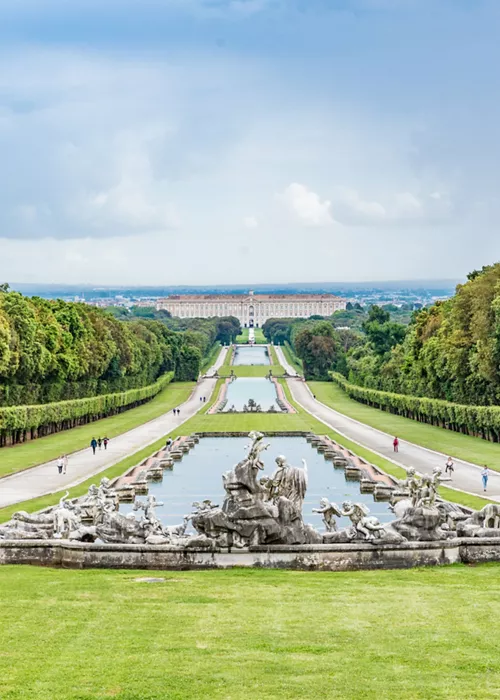
The Reggia of Caserta: sumptuous triumph of Italian Baroque
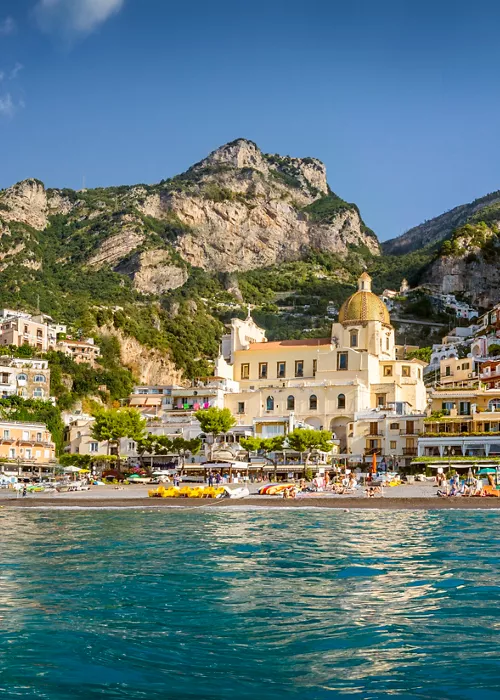
The Amalfi Coast: a hypnotic view of the cobalt blue sea
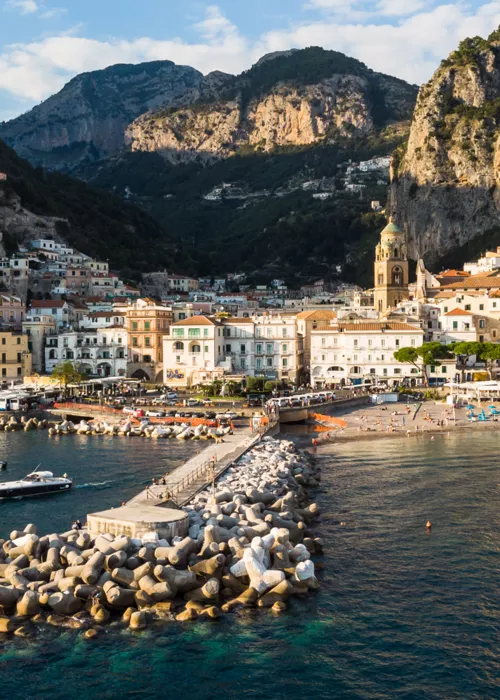
Campania: postcard-perfect sea and dizzying flavours
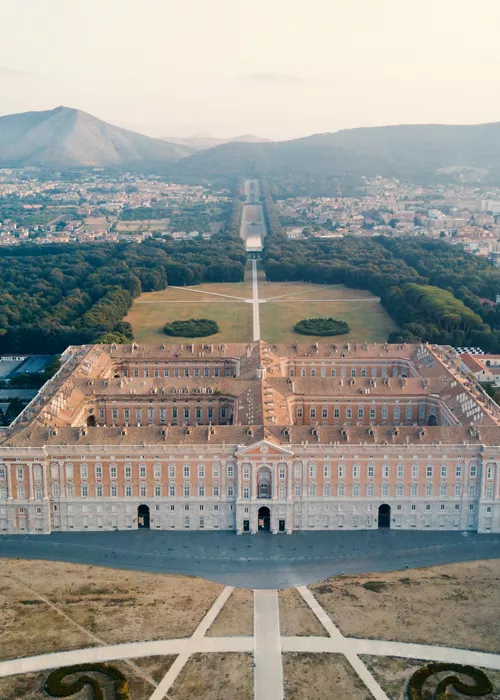
Naples-Caserta, travel like a king
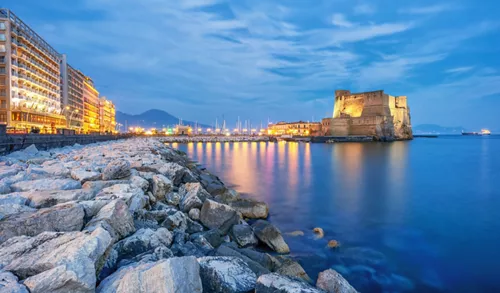
Naples, an enchanting city of sea and culture
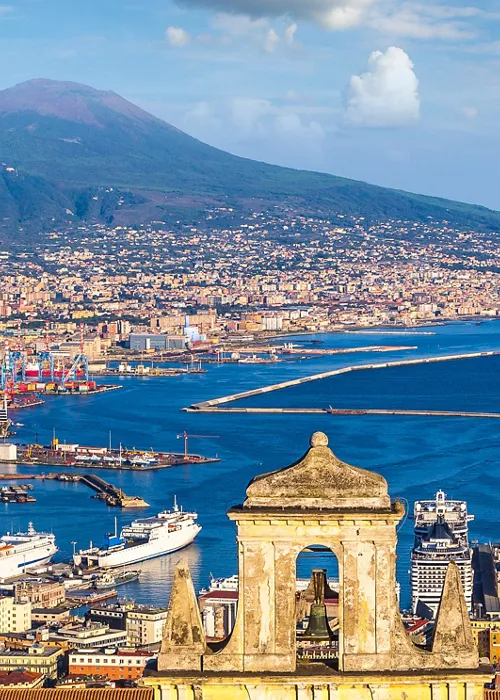
2 days in Naples: the itinerary
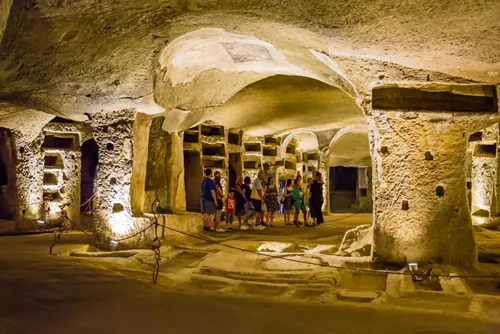
The Catacombs of Naples
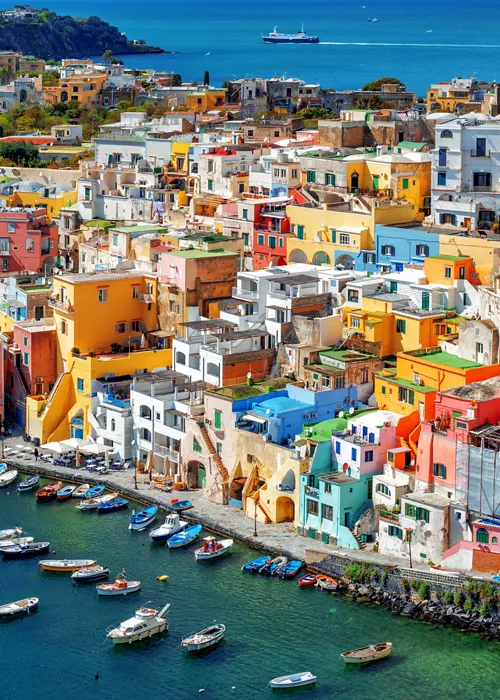
Procida: the enchanted island of watercolour houses and turquoise sea
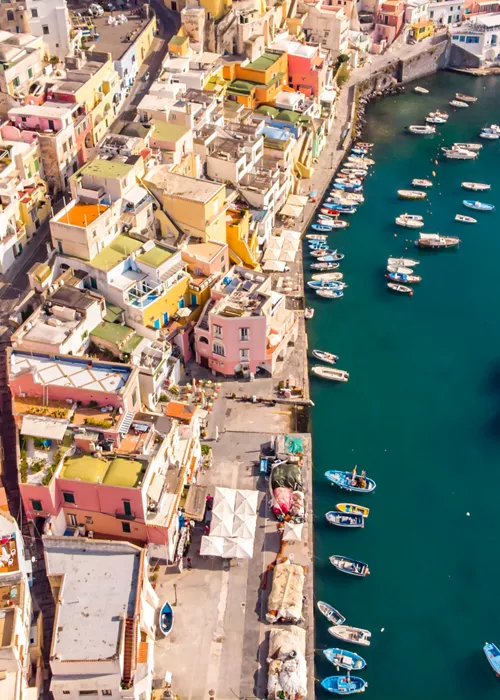
Procida: a crossroads of experiences for all the senses
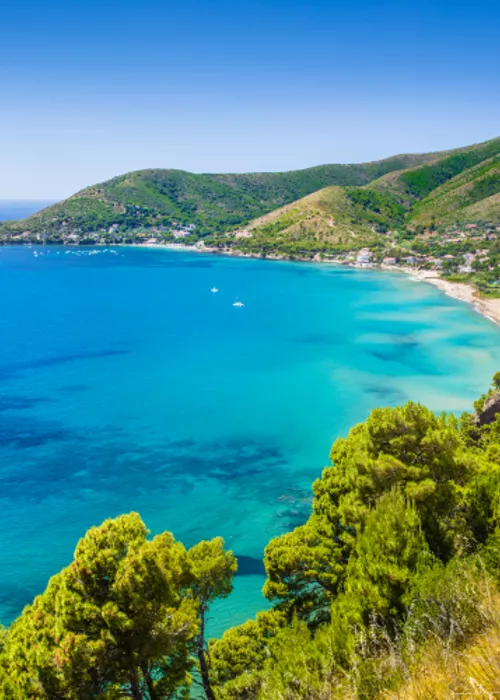
Campania Parks: sustainable tourism in the region's protected areas
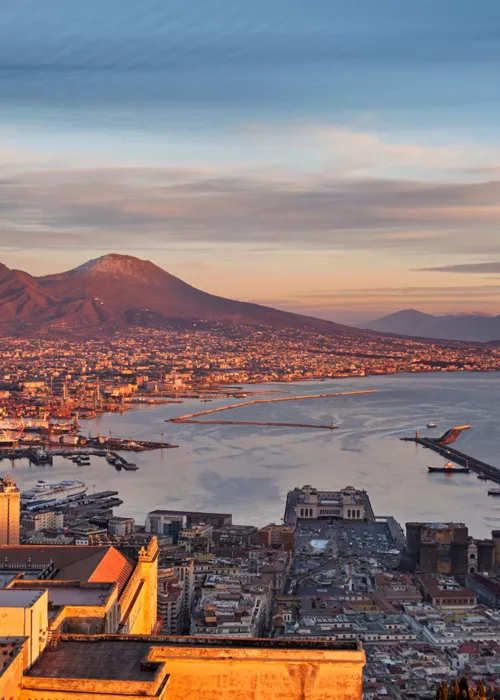
Travelling to the mountains from Naples: here's where to go
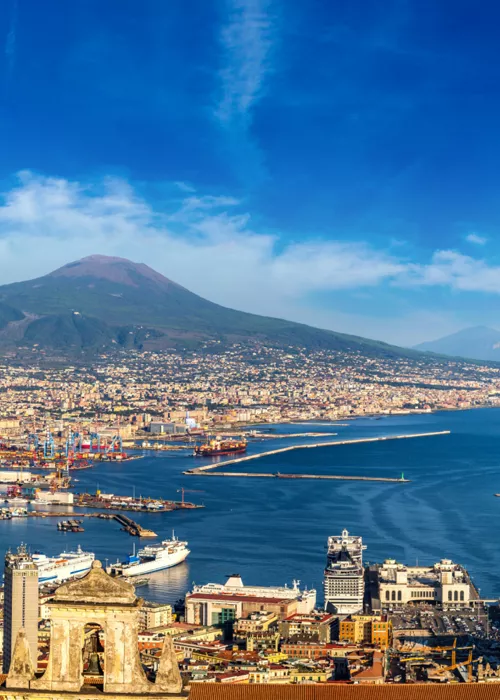
A 10.000-step itinerary around the centre of Naples
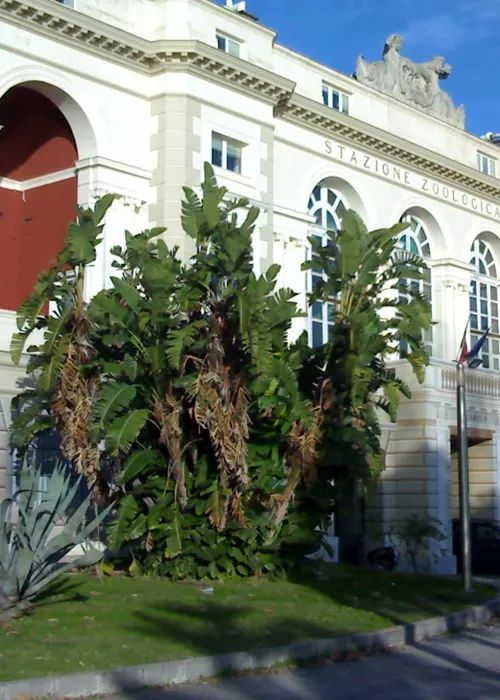
Anton Dohrn Zoological Station, the aquarium of Mare Nostrum
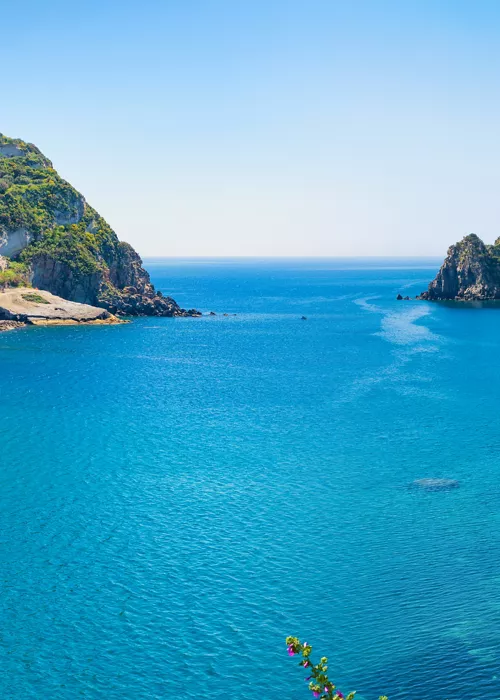
The Paths of Ischia
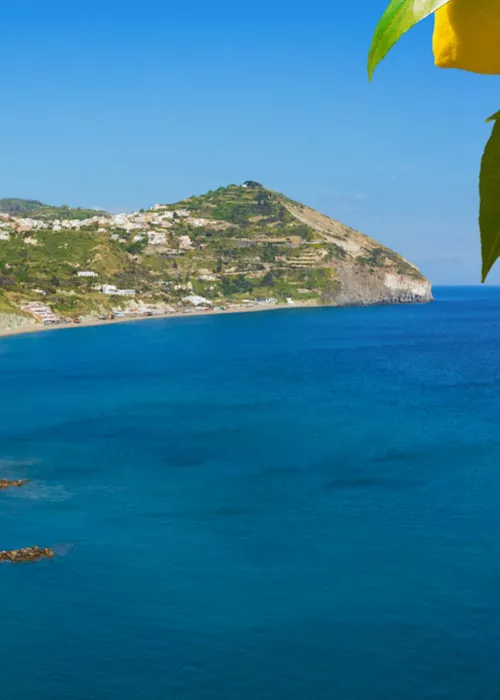
Le Fumarole: the steaming beach of Ischia, what a spectacle
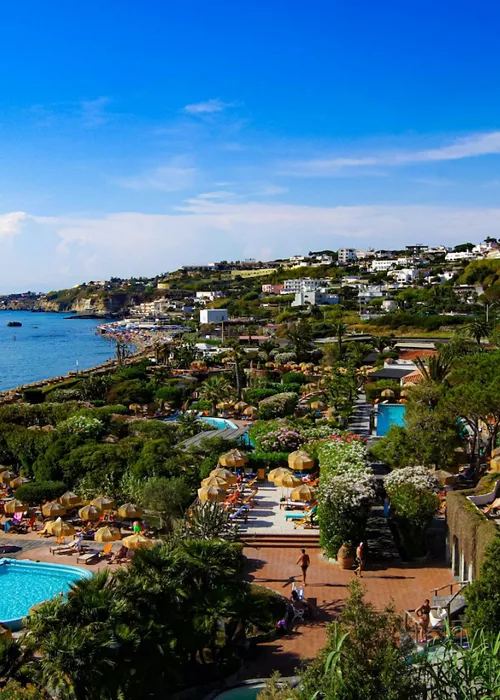
The Thermal Parks of Ischia

Street food in Naples is the quintessence of wonders for the palate
Comicon Naples: the most important network of pop events in Italy

Vitigno Italia

Continue living like an Italian
Subscribe to the Newsletter so as not to miss places, events and experiences for experiencing the best side of Italy: the authentic one.
Keep up to date
Would you like to learn about the most authentic experiences to be had in Italy, stay up to date on the most interesting events, discover our special offers and receive lots of insider hints and tips?
Save your favorite places
Create an account or log in to save your wishlist
Do you already have an account? Sign in

- Top Attractions
- Day Trips from Rome
Herculaneum
Located in the region of Campania, the town of Herculaneum suffered the same fate as Pompeii . The town was buried under Mount Vesuvius’s volcanic ashes and mud in 79 AD.
Hit before Pompeii, many inhabitants didn’t have time to escape and were engulfed in layers of debris, ashes and mud, dying instantly to be preserved for centuries.
What to see
At the foot of Mount Vesuvius, the city was the volcano’s first victim, and therefore the first wall of lava, ashes, debris and gases covered Herculaneum completely a little after midnight on 25 August. The previous day, it had been plunged in a cloud of debris leaving it without sunlight.
A UNESCO world heritage site , Herculaneum is better preserved than Pompeii . The city’s houses, baths, taverns, temples and figures are undamaged; therefore, visitors will get a real sense of the splendour of this Roman city.
Wealthier than its neighbouring Pompeii, the town is full of beautiful buildings. The different floors of most of the buildings are still intact and it is possible to see the magnificent frescoes and mosaics covering the walls of palaces, public buildings and mansions.
On the far side of the city are the most luxurious villas overlooking the sea, notably the Villa dei Papiri, which was the luxurious retreat of Julius Caesar’s father-in-law.
In Herculaneum, archaeologists have also found the first Roman preserved skeletons from the first century, since prior to this period Romans would cremate the dead. The skeletons are on display in one of the city’s houses.
Beautifully conserved
The town of Herculaneum has been magically conserved all these years . Objects like beds, and doors managed to remain under the layers of ash and mud without decaying.
Although it isn’t as well-known or as large as Pompeii , Herculaneum’s ruins are extremely impressive and gripping . Definitely worth visiting!
Today, the town of Ercolano lies extremely close to the ruins of Herculaneum, creating an interesting contrast.
Getting to Herculaneum
The most common ways of getting to Herculaneum from Rome are:
- Train : Visitors need to take a train to Naples to get to Herculaneum. These leave from Termini railway station. Once in Naples, the Circumvesuviana line goes to Herculaneum (Ercolano Scavi station). It takes between 2 – 3 hours to get there and the prices range from € 30 ( US$ 32.10) to € 100 ( US$ 107.20) for a roundtrip , depending on the train.
- Car rental : Although this is the cheapest option for families or groups of friends, you must keep in mind the price of petrol, parking and tolls. We would recommend this option only for those thinking of renting a car for additional days to visit other attractions nearby .
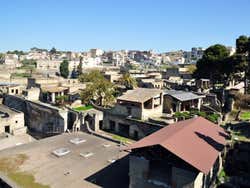
143 miles (230 km) south of Rome
1 November – 31 March: Every day from 8:30am – 5pm 1 April – 31 October: Every day 8:30am – 7:30pm
Adults: € 18 ( US$ 19.30) EU Citizens between 18 and 25 years old: € 5 ( US$ 5.40) EU Citizens under 18 years old and seniors over 65 years old: free admission
Nearby places
Pompeii (14.4 km)
You may also be interested in

Pompeii was an ancient Roman city near modern Naples that was buried by the great eruption of Mount Vesuvius in 79 AD.
Located in the Gulf of Naples, Capri is a dream-like island surrounded by a deep blue sea that reflects a very special light. Come and discover it.
- Maps of Italy >
- Campania >
- Ancient Pompeii
Pompeii Maps and Travel Guide
How to visit ancient pompeii, a very popular site in italy.
Pompeii, and to some extent its sister site Herculaneum, are notable for being destroyed by a particularly ferocious eruption of Vesuvius. Time stopped at that very moment. The archaeological site became a vast museum of that moment in time, which is why it is so compelling--and why archaeologists have learned so much from the ruins of Pompeii.
Table of contents
- How to Get to Pompeii from Naples
Recent Discoveries
- Ancient Pompeii Map
- Top Pompeii Attractions
- Map of Place Names for Pompeii
How the Wealthy Lived at Pompeii
Pompeii and wine.
- Tickets and Tours
Where to Stay
Recent developments in pompeii.
Pompeii is one of the top Roman era attractions in Italy. It's also pretty easy to get to from Naples, so you can do it as a day trip from the big city. See the details below.
As you can see from the map, the ancient town of Pompeii to the north of the modern Pompei is not so much smaller than the modern town that's grown up around it. You can take quite a long time exploring it--the whole city is at your feet.
It takes a while. The ancient streets and sidewalks aren't exactly flat. It'll tire you out sooner than you think. There is a cafe inside the archaeological site so you can have a break, but it's still an amazingly complex site.
It used to be said that the modern town, differentiated from the older one by its spelling--Pompei, with one "i"--wasn't worth staying in. But it's a pleasant enough town, especially if you stay in one of our recommended hotels, chosen for their quiet locations. Remember that lots of folks do Pompeii on a day trip, so nights can be nicely quiet and relaxing. Pompeii, in fact, has a nice passiagiata , an evening stroll that citizens participate in, walking up and down the main street, Via Plinio, that marks the southern boundary of the ancient Pompeii excavations.
Pompeii is also notable for a recent event: a new barrier free route through the ruins is the country's longest:
Unveiled on the eve of the International Day of Persons with Disabilities, a new barrier-free route through the Pompeii ruins now allows wheelchair-users access to this world-renowned archaeological site. The three-kilometer trail features smooth pathways, access ramps and a very doable grade. Previously a steep ash covered path led through the site, which prevented wheelchair access. ~ Pompeii Accessible to All
How to get to Pompeii from Naples
The Campania Express will take you directly to the Pompei Scavi Villa Dei Misteri Train Station from the Naples Piazza Garibaldi Train Station or the Naples Porta Nolana Train Station for around 15 Euro. The trip takes around half an hour.
Check Times or Buy Tickets
A segment of the fast-food counter was partially dug up in 2019 during work to shore up Pompeii’s oft-crumbling ruins. Since then, archaeologists kept digging, revealing a multi-sided-counter, with typical wide holes inserted into its top. The countertop held deep vessels for hot foods, not unlike soup containers nestled into modern-day salad bars. -- Chicago Tribune
These kinds of places have been discovered in Pompeii before, but as a recent excavation, the frescoes surrounding bar the bar are as vivid as the last day of Pompeii. The containers still had food left in them, so ongoing analysis will provide a menu of the food served at the time.
Valeria Amoretti, a Pompeii staff anthropologist, said “initial analyses confirm how the painted images represent, at least in part, the foods and beverages effectively sold inside.” Her statement noted that duck bone fragment was found in one of the containers, along with remains from goats, pigs, fish and snails. At the bottom of a wine container were traces of ground fava beans, which in ancient times were added to wine for flavor and to lighten its color, Amoretti said.

Map: Location of Ancient Pompeii
The dashed lines on the map indicate the streets of the Pompeii Archaeological Park. In the lower left is the rail station, Pompei Scavi-Villa die Misteri and the A3 autostrada exit. Pompeii is very easy to access, as you can see.
If you zoom into a structure in Ancient Pompeii, you can see a great bit of detail, including individual floor plans.
Pompeii Attractions
The recommended things to see in Pompeii are labeled on our map. The top-left quadrant is the ancient city. It takes a while to see if you want to see all of it. The modern city of Pompei is on the right, east of the ancient city of Pompeii.
Ancient Pompeii is your main target here. You'll see villas, Roman baths, the forum, and the city of Pompeii. Don't skimp on the time you spend here. Before you go, you might want to check the event page .
Santuario di Pompei is the main church of Pompei and gives its name to the stop on the Circumvesuvius stop on the train from Naples. There is a small museum downstairs. It has quite a stunning facade, and marks the spiritual center of the new Pompei.
La Bettola del Gusto Ristorante on Via Sacra across from the FS station offers good food at reasonable prices. It's especially convenient if you're staying at the Hotel Diana, which doesn't have a restaurant of its own.
Map of Place Names for Ancient Pompeii
The map below shows the major named structures as well as the train station for Pompei Scavi - Villa Dei Misteri.
This is a sketch plan of what was known as the "house of Salust" located in the northwestern corner of the site.

The house is one of the most significant examples of a dwelling in the Samnite era (dated around 180 BC), which retains much of the original layout, the severe façade made of limestone blocks, the atrium equipped with an impluvium made of tuff and the small rear portico with tuffaceous columns. Even the wall decoration of many rooms is original and is one of the most remarkably preserved in Pompeii. -- House of Salust
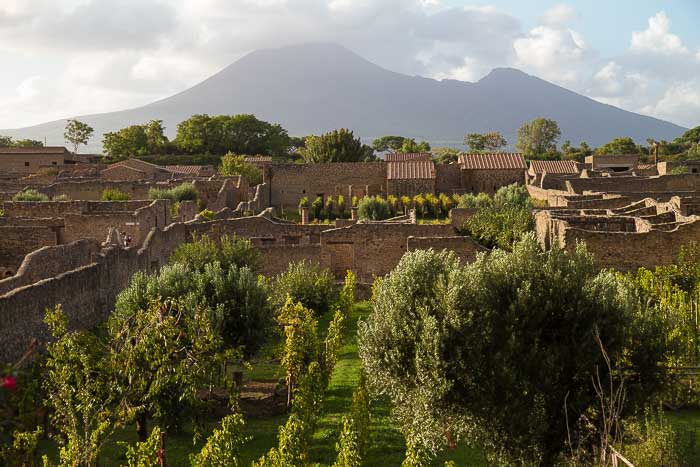
Near the entrance to the excavations of Pompeii, you will see thriving vineyards. The wine here is produced in the ancient way that Romans did it before Pompeii was covered in ash.
The vineyards were excavated in the 1980s. Archaeologists called in wine maker Piero Mastrobeardino to find out how the ancient wine was produced. By studying casts of vine roots, fragments of farming texts, and frescoes, Mastrobeardino and his team determined that the Pompeiians were growing Piederosso Sciacinoso and Aglianico, just like the local farmers. But the similarity ends there.
"Pompeii wines were fermented in open-topped terracotta pots, called dolia . These were lined with pine resin filled with wine and buried deep into the earth. Asking a modern wine-lover to drink ancient wine would be foolish. The Romans knew their system was far from perfect but didn't have the technology to change it." How Pompeii brought ancient Roman wine back to life
15 of the vineyards have been replanted and some 1,700 bottles of Villa dei Misteri are produced.
You can buy it online . Cheap it is not.
Tickets and Tours to Pompeii
Tickets you can easily purchase online are available from our partner Tiqets, these include entrance tickets, guided tours, a Pompeii and Vesuvius pass, and half-day trips from Naples.
Pompeii Tickets
If you are in Rome and you'd just like to hit a couple of the south's high points, the Tour Guy (formerly the Roman Guy) offers a day trip from Rome to Pompeii that includes Sorrento .
If you are already near Pompeii, you can also get the Skip the Line Pompeii Ruins Tour with Villa of the Mysteries from the Tour Guy, a very highly rated tour. On either of these tours you can get a 5% discount by using the links for these two Pompeii tours.
Hotel Diana Pompei a reasonably priced three star hotel in a quiet area near the FS station with good Internet connection and helpful staff. Highly rated by folks who've stayed there, which includes your humble scribe. Nice public areas where you might have a coffee or glass of wine outside while relaxing from your day of sightseeing.
Hotel Visagi is a highly rated hotel 800 meters from the excavations, also a three star hotel. Reasonable.
The B&B La Casa Di Plinio is very close to the excavations, inexpensive and highly rated by visitors.
Pompeii & Herculaneum Articles
Cucina Povera in Pompeii Herculaneum: Archaeology as a Gentleman's Game Pompeii Opening Times and Prices Pompeii News
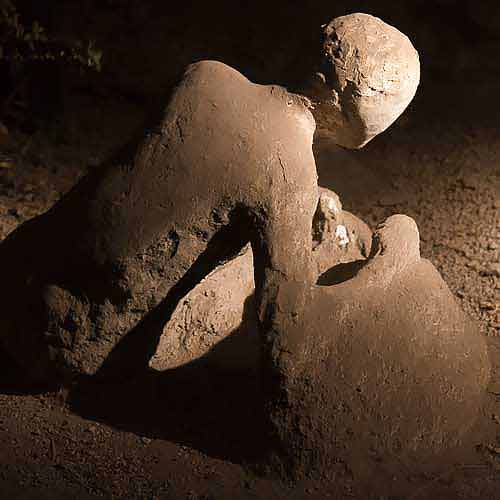
Pompeii Body Casts
Folks come to see these ancient people whose poses are frozen in time.
Learn More...
The Forum Granaries
There is a lot of archaeological work taking place in Pompeii these days. One of the most fascinating for me is the work done on the Forum Granaries. The work of the common folks is often the last to be studied, unfortunately.
An exhibit opens summer of 2021, and a reservation is recommended.
Video in English: The Forum Granaries at Pompeii
Visiting Information
The House of the Vetti
After a 20 year restoration, the house of the Vettii is now open for viewing. Famous for the erotic art collected by the owners, former slaves who were freed and became rich wine merchants, it was the place where everyone with a camera took pictures, especially of Priapis.
Here is the story:
Revealing the Risqué Art of Pompeii’s House of the Vettii
More Italy Travel Planning Resources
Book a Hotel or Hostel Book a Vacation Rental
- Travel Planning Timeline : Learn what you need to plan when.
- What Will an Italy Vacation Cost? : Tools for budgeting your Italian vacation.
- Unplanned Attractions : Save time for the good life in Italy.

Visiting the ruins of Herculaneum in Italy
Things to do in Naples Naples Attractions Landmarks in Naples Herculaneum
An ancient Roman fishing town located in the ambit of Mount Vesuvius, Herculaneum ruins offers a rare experience to travellers. This tiny city, buried by the devastating eruption of Mount Vesuvius in AD 79, has been conserved well to become a UNESCO World Heritage Site. It harbours rare archaeological treasures giving a glimpse of its original splendour. About halfway between touristy towns Pompeii and Naples, Herculaneum is a hidden gem far richer in its conserved heritage and far less crowded than its popular neighbouring towns. The pyroclastic surge as a result of the eruption led to the preservation of much of organic based wooden objects, roofs, mosaics, frescoes, skeletons etc. giving us a unique peek into how the ancient Romans lived. Not visiting Herculaneum while in such close vicinity would be a huge regret!
Know Before You Go

Handy Information
Best time to visit - Early mornings or late evenings Suggested duration - 3 Hours Closest train station - Ercolano Scavi
Opening Hours
Jan 1 - Mar 15: Daily from 8:30am – 5pm Mar 16 – Oct 14: Daily from 9:30am – 7:30pm Oct 15 - Dec 31: Daily from 8:30am - 5pm
Highlights Of The Ruins
Baths (Thermae) House of Neptune and Amphitrite Villa of the Papyri Samnite House
Corso Resina, 187, 80056 Ercolano NA, Italy Get Directions
Why Should You Visit The Herculaneum Ruins?

There are very few ghost cities that have been preserved as pristine as Herculaneum. The ruins of the ancient Greek city date back to AD79 when Mount Vesuvius erupted and destroyed both Herculaneum and Pompeii. But unlike Pompeii, this city was buried much differently.
The excavations for Herculaneum only started in the early 20th century and hence it is better preserved than Pompeii. While Pompeii was instantly buried by hot ash, the fragments of rock from the volcano created a hot avalanche headed towards Herculaneum. This kept the opulent and richly decorated three-storeyed buildings from two millennia ago still intact. The frescoes and mosaics created by the ancient Greeks give away the rich culture the people of this tiny fishing village lived in. While Pompeii is the more popular ruin, Herculaneum can quickly take you back in time where you can sense the spirit and hues of the lost vibrant city.
Herculaneum History
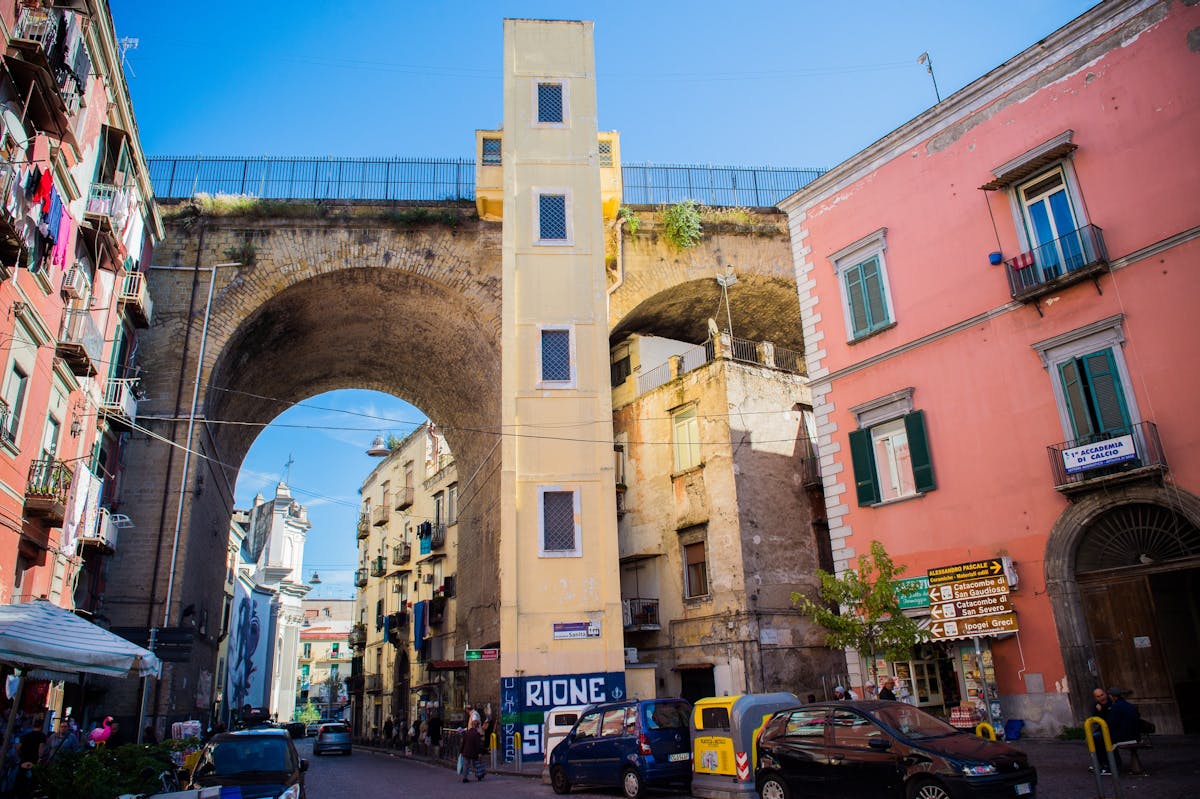
Herculaneum before eruption
Herculaneum was a 2000-year-old, ancient Roman city about 5 miles to the southeast of Naples, in Campania, Italy. With just about 4,000–5,000 inhabitants, this splendid town lay in the shadow of Mount Vesuvius. Although it was a small seaside fishing town, Herculaneum was a wealthy town that possessed a great number of lavishly done up houses with coloured marble cladding, buildings with frescoed roofs and mosaics, classic Roman furniture, wine racks, household shrines and much more.
Herculaneum Excavation
In A.D. 79, this prosperous city along with the bigger neighbouring towns bore the warth of the volcanic eruption of Mount Vesuvius. It was engulfed and buried by superheated pyroclastic flows of molten rock that encased it into a solid mass of pumice and ash. A horrific disaster albeit, it converted the living, breathing city of Herculaneum into a thoroughly protected time capsule. As archaeologists dug into the ruins in the recent years of mid 18th century, they discovered well preserved wooden and other rare organic artefacts such as roofs, racks, beds, baby cots, doors, food and even some 300 skeletons along the seashore. Since then it has been a fascinating destination for many travellers.
Herculaneum Tour - What To See?
Here is a small list of archaeological sites in the ruins that you must not miss!
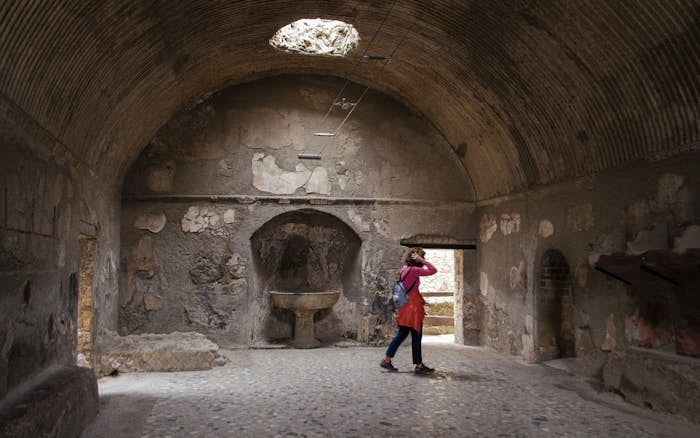
These are well-preserved thermal baths, separate for men and women. The water fed by a deep well was heated by a large furnace and distributed around the baths by a network of pipes. The men’s bath has a floor mosaic of dolphins while the women's floor has a well preserved geometric pattern and intact wooden shelves.
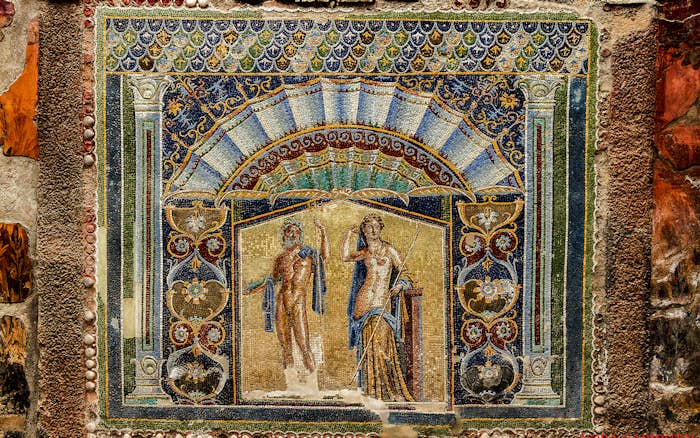
Named after Neptune and Amphitrite, a sea goddess and wife of Poseidon, this place has one of the most beautiful mosaic glass walls. The adjoining wall is also covered with a glass mosaic, with marble masks above it. It has a garden room that replaces the peristyle giving it a unique touch.

Home to the famous Herculaneum scrolls, named after the unique library of papyri (scrolls) this is a large and luxurious villa along the coastline. Spread over four terraces, it has exquisite architecture and has been home to rare works of art like frescoes, bronze and marble sculptures etc.
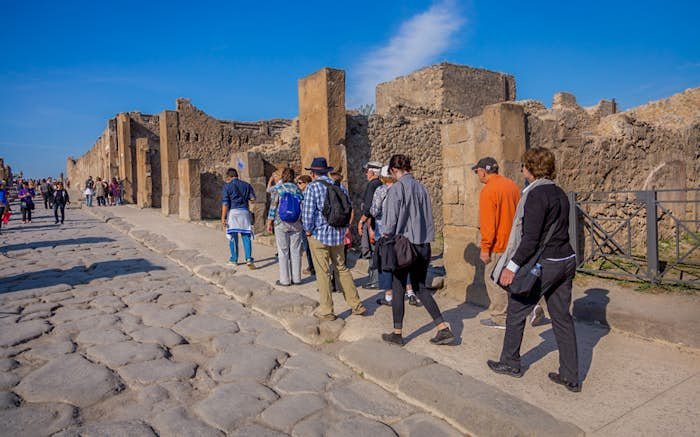
Another luxurious waterfront two-storeyed villa with a central courtyard. The floor with marble chips and mosaic patterns is quite an awesome sight. The frescoed walls are not to be missed. It had a huge garden adorned with marble tables and deer statues, well preserved now in the onsite museum.

This elegant three-storey mansion is right across from the House of the Deer. It has a spacious atrium with ionic columns and a marble basin that leads down to a park. Famed for an excellent marble relief, it has cast replicas of many of its original marble masks.
Image Courtesy: Wikimedia

This is one of the oldest aristocratic mansions discovered so far in this town. The house has rich stucco and fresco decorations and an elegant atrium with a gallery and small rooms around it. The typical columns and pillars of that era mark the structure.

This meeting hall for the priests (usually ex-slaves) of Emperor Augustus is a very large square shrine lit by an opening in the roof. It has excellent frescoes depicting historical gospels like Hercules in Olympus with Juno and Minerva and Hercules fighting an Etruscan god etc.
Image Courtesy: Google Sites
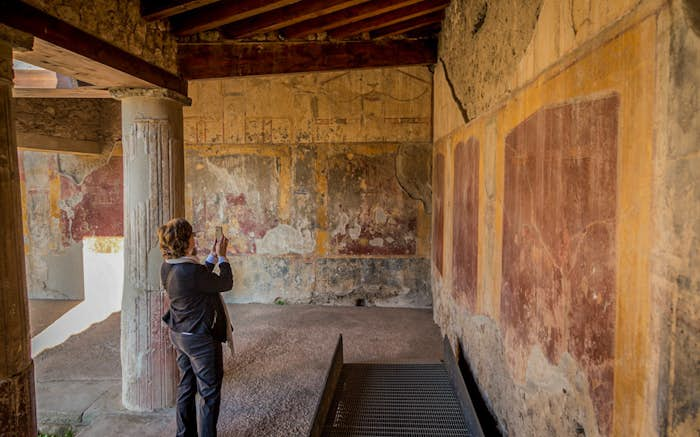
This opulent house has a little courtyard garden and beautiful mosaic flooring. It also has remains of the art appreciated by Herculaneum's natives in the form of very fine wall paintings on a rather unusual black background.

There are a series of shops including weavers loom, a dye shop and a bakery with ovens and mills. Behind these is Palaestra, a grassy area, also known as the outdoor gym. It is bordered by the remnants of pillars and was a public field for games and other events.

From 1980 to 1982, archaeologists found 140 Herculaneum skeletons at the Boathouses. This provided a surprising turn since it was thought that all the inhabitants of the fishing village had fled. These skeletons were strangely covered in black and red mineral residues. It was later hypothesized that deposits of iron from human blood exposed to extreme heat caused it.
Herculaneum Tickets
Here are the different Herculaneum tickets and how you can score them.
You can purchase the tickets at the gates. However, be prepared to stand in long lines for quite some time.
Priority Entrance Ticket
As the name suggests, the Herculaneum Priority Entrance Ticket help you skip the long ticket lines and save time. If you are one to explore places on your own, this is the best pick.
Herculaneum Guided Tour
Nothing beats a Herculaneum Archeologist Guided Tour to learn about the ghost city and its remains from an expert archaeologist! Learn all about the chronology of the excavations, the remains and what they signify with this tour.
Pompeii and Herculaneum
Go all Indiana Jones with this golden Pompeii and Herculaneum Full Day Archaeological Excursion From Naples . Your trip would be sorted with just one ticket by visiting Italy’s top attractions, Pompeii and Herculaneum, from Naples. Not only would you need not have to spend time itinerating your trip, but you will also save few euros.
Herculaneum Or Pompeii?
People are often confused about whether they should visit Herculaneum or Pompeii . Herculaneum and Pompeii, though preys of the same calamity are very different towns. Let us look at the differences more objectively to make a conscious decision.
Visiting Herculaneum - How To Get There?
Rome to herculaneum.
Herculaneum is about 150 miles south of Rome, close to Naples. The best way to get to Herculaneum from Rome is by train. This is the fastest and most comfortable option. It takes about 2 to 3 hours depending on whether you take the high speed or slow speed train. The journey involves transfer from Naples to another line. You can catch any train to Naples that leaves from Termini railway station. From Naples the Circumvesuviana line goes to Herculaneum (Ercolano Scavi station). A round trip can cost anywhere from 30€ to 100€ depending on the train.
There are round trip coaches from Rome to Pompeii and Herculaneum with a guided tour. You can enjoy the countryside vistas from the comfort of your coach. They are a good second choice. Renting a car can be another option for families and groups especially if you are planning to cover nearby places too.
Naples to Herculaneum
Herculaneum is very close to Naples, just about 8 miles. You can take the train along Circumvesuviana line from Napoli Stazione Centrale / Garibaldi to Sorrento and get off at ERCOLANO station. The archaeological site is hardly 700m from the station.
The more expensive options of renting a car or a cab are always there and though it is comparatively more expensive than the public modes of transport, it won't burn a hole in your pocket.
Pompeii to Herculaneum
Herculaneum is hardly 10 miles away from Pompeii. You can take the train going to Naples on Circumvesuviana line from the Pompei Scavi/Villa dei Misteri stop to Ercolano Scavi stop. When you exit the station and go down the stairs, it is a downhill walk of just 10 minutes to the Herculaneum entrance.
If you're not on a budget, you can easily rent a car or a cab from either of the sites to the other!
Herculaneum Opening Times
- From 1 November to 31 March | Every day from 8:30 AM – 5:00 PM (with last entrance 3.30 PM)
- From 1 April to 31 October | Every day 9:00 AM – 7:30 PM (with last entrance at 6:00 PM)
- Herculaneum remains shut on 25th December, 1st January and 1st May.
Ruins of Herculaneum Map
Use this Herculaneum map to navigate through the ruins.

Image Courtesy: Khan Academy
Herculaneum Hotels
Where to stay.
The seaside town of Ercolano is a very pretty sight. The sea to one side and ancient ruins to the other, this town makes for the perfect place if you're visiting the nearby towns of Pompeii and Naples. Here is a list of the prettiest hotels (with sea views!) that you should consider.

Hidden between the slopes of Mount Vesuvius and the Gulf of Naples, is Hotel Herculaneum, a chic hotel with views of its lush gardens and the sea. The rooms are decorated with blue and white decor. They also provide authentic Italian breakfast in their spacious dining room. Distance from Herculaneum: 900 meters

If you want to truly experience what living in an Italian palace feels like, head to Hotel Villa Signorini. They are decorated with Victorian furniture, and painted with Renaissance art. It is located near the Royal Palace of Portici, the 'Villa of the Papyri arcane and the sea. Distance from Herculaneum: 2 km

If you want to treat yourself to amazing sea views and breakfast, look no further than La Dimora le Fumarole. The staff are hospitable and the hotel offers all modern amenities for a perfect stay. Distance from Herculaneum: 5.2 km

If modern luxury is your thing, Hotel Puntaquattroventi makes a wonderful stay. Their chefs are the best in town, they have a wonderful pool facing the sea, modest rooms and excellent service. Distance from Herculaneum: 1.9 km
Herculaneum Restaurants
Where to eat.
Here are some amazing places to feast in after your long and memorable tour of Herculaneum ruins.

If you are craving elegant Italian delicacies paired with a few drinks, Casa KBirr is the place to go. They serve everything from Neapolitan, Campania, Southern-Italian to vegetarian friendly, gluten free options. Must try: Grandma's meatballs and cod

If you are in the mood for gourmet and a splendid terrace view of the sea town, head over to Masseria Guida, a Michelin star restaurant. They specialize in Italian, Seafood, Mediterranean, and European cuisine with everything gourmet. The service is reasonably quick and the food tastes delicious. Must try: Iberico pork, Apricot ice cream, Amaro at finocchietto

Taste some classic wood fired pizzas at Pizzeria Luna Caprese. They serve everything Italian with vegetarian and vegan options. If you are on a tight budget, this is a great place to find appetizing food at reasonable prices. Must try: Diavolo pizza, Lasagne, and Spaghetti

Another great pizzeria in the region is Pizzeria O' Sbarazzino, serving the local favourites with a garden view. They serve delicious pizzas at a fraction of what you would normally spend elsewhere. The service is quick, the staff are friendly as well. Must try: Wine, Pizza
Insider Tips for Visiting Herculaneum
- As you walk down the steps from the station, you are pestered by quite a few eager taxi drivers for a drive to Herculaneum. Do not give in to the temptation as it is just an easy 10 minutes downhill walk from there to the site.
- Kids have to be either prepared to walk through the site or have to be carried around in a sling/ backpack as strollers are difficult to move in the cobblestoned hilly terrain.
- It can get quite hot during summers. Carry a water bottle which you can keep refilling at many water fountains of Herculaneum.
- Carry some snacks or pack a picnic. Food options around the site are few and expensive.
- To know the Herculaneum facts, a guided walking tour of this kind of historical site is highly recommended. You can rent an audio guide or purchase a guidebook and Herculaneum map at the information desk near the ticket window.
- If you're a teacher or student, consider buying a Campania Artecard, which offers free or reduced admission to many museums and archaeological sites in and around Naples and Campania. The three-day card includes free public transport as well.
Hot Herculaneum Deals!

Herculaneum Ruins FAQs
How long do you need at herculaneum ruins.
You might need around 3 hours to cover the city since it is small and easily accessible.
Are kids allowed to the Herculaneum ruins?
Yes. Kids are allowed. But if they cannot walk, they must be carried around in a sling/backpack as strollers are difficult to use in the uneven terrain.
How to reach Herculaneum ruins?
If travelling from Rome, it takes about 2-3 hours by train
If travelling from Naples, it takes about 10-20 minutes by train
If travelling from Pompeii - take the train going to Naples on Circumvesuviana line from the Pompei Scavi/Villa dei Misteri stop. There is also the option of taking a cab/taxi for a slightly higher price from Naples or Pompeii.
What can we see in Herculaneum tour?
You can visit the thermal baths, House of Neptune and Amphitrite, Villa of the Papyri, House of the Deer, House of the Relief of Telephus, Samnite house, Hall of the Augustales (Sacello degli Augustali), House of the Black Room/Salon (Casa del Salone Nero), House of the Beautiful Courtyard (Casa del Bel Cortile).
What is Herculaneum famous for ?
You can see well preserved wooden and organic artefacts like beds, cots, roof and racks along with 300 skeletons along the seashore due to a volcanic eruption.It is also a UNESCO world heritage site.
Is Herculaneum better or Pompeii?
Herculaneum ruins have been preserved better than Pompeii. Herculaneum is also easier to navigate because it is a small town.
What is the ticket price for children in Herculaneum?
Minors below the age of 18 have free access to Herculaneum with valid photo ID.
What should I carry with me to Herculaneum?
A water bottle is recommended (can be refilled in water fountains in Herculaneum).It is advised to carry some food because of limited options in the site.
Should I book a guided tour to Herculaneum?
Visiting Herculaneum with a guided tour is always highly recommended. Audio book can be rented or a guide book can be purchased at the suggestion.
Ready To Explore Naples?
Check out our comprehensive list of things to do in Naples packed with itineraries, tours, culture trips, best hotels, restaurants and a lot more.
Lakshmi Menon
Born to parents bit by the wander bug, Lakshmi calls her love for travel "hereditary and habitual". Perpetually ensconced with a book in her hand and a mug of coffee in the other, she has been to over 15 countries in her 23 years of existence and is currently saving miles and money for her solo trip to Iceland. Always hustling towards the least trodden path, she has encountered some wonderful people during her escapades and if you ever meet her, she won't stop gushing about them.
Be a smart traveler
The first to know about trending destinations, travel deals, tips and all things travel.


Free access to the main attractions of Naples and get discounts in the best activities
✅ Free entrance to the main attractions of Naples ✅ Free public transport ✅ Discounts at the best hotels, restaurants and businesses
- Visit the ruins of Herculaneum from Naples: everything you need to know to plan your tour in 2023
- Places and Tours
Have you ever been on a visit to the ruins of Herculaneum ? Discover this historic place unchanged by time , and live this experience with us.

Visit the ruins of Herculaneum departing from Naples , find out how with our guide. This half-day group tour departs from the Neapolitan capital and takes you to discover the ancient Roman city that was submerged by the eruption of Vesuvius in 79 AD.
This tour to visit the ruins of Herculaneum departs from Naples in the morning. After a comfortable transfer service, you will travel by fully-equipped coach to the magnificent Herculaneum, where you will admire its majestic ruins , an archaeological heritage site of worldwide importance. Here you will meet your professional guide who will take you on a fascinating journey through time to discover the ancient civilisation of Herculaneum , perfectly preserved for centuries and buried under volcanic materials as early as 79 AD.
Visit Herculaneum: walks among the buildings of the ancient city

The guided tour of Herculaneum begins with a panoramic view of the city from above. Afterwards, you will descend to the archaeological site , which you can explore by walking among the most important buildings of the ancient city . You will admire the urban structure of the city, completely identical to that of 2000 years ago . The past is so well preserved in this Romanesque site that a visit to Herculaneum is highly recommended for enthusiasts and non enthusiasts alike. You can see relics, terracotta vases, ancient buildings and other materials perfectly preserved over 2000 years .
Visit Herculaneum from Naples

Herculaneum is a city on the Gulf of Naples, world-famous along with Pompeii for its archaeological excavations of the ancient Roman city . According to legend, the city was founded around 600 B.C. by Hercules and later became an important trading centre due to its privileged position near the Persian Gulf. The citizens honoured Heracles as the founder of nearby Vesuvius. In 79 A.D., Vesuvius erupted and destroyed the city , leaving Herculaneum under about 50-60 feet of volcanic mud and ash. A well digger only discovered the city in the early 18th century. At first it was thought that all the inhabitants had fled the city before the disaster, but excavations uncovered about 300 skeletons . The road leading from the archaeological excavations to Torre del Greco is called the Miglio d'Oro (Golden Mile) because of the magnificent 18th-century villas built next to it.

Herculaneum ruins visit duration

Although Herculaneum is smaller, its advantage is that it is much richer in artefacts than nearby Pompeii (more famous for tourism). At the ruins of Herculaneum, the visit duration , being smaller and more intimate, can all be visited in comfort. One can visit luxurious flats decorated with exquisitely visible and perfectly preserved frescoes . Accompanied by an experienced guide, you will relive the history of this wonderful and unhappy city. You will visit archaic workshops, public baths and the magnificent Villa of the Papyri, home to one of the oldest libraries in the world. At the end of this wonderful day trip , which takes about three to four hours, you will return to Naples by comfortable bus.

Guided tour Herculaneum

Many tourists from all over the world come on a guided tour of Herculaneum with us at Visit Italy , sure of a unique and captivating experience. When you enter the ruins, you will see many of the beautiful Romanesque houses during the guided tour of Herculaneum , consisting of luxurious coloured mosaics, wall paintings and marble cladding. The excavations of Herculaneum are listed as a UNESCO World Heritage Site. The Herculaneum Archaeological Park is open from 9:30 a.m. to 7:30 p.m., closed on Wednesdays. There is a bookshop inside the park. You should get to Herculaneum by car, as there are many private car parks in the area, as well as the municipal car park in Viale dei Papiri Ercolanesi.
Herculaneum night tour

Herculaneum never sleeps , the lights of its fascinating history are also turned on at night. In fact, from May to early October it is possible to visit the Herculaneum Archaeological Park for a 'night-time' archaeological tour . Don't miss the opportunity to see Herculaneum on a night tour . In 2022 we had 'Herculaneum Fridays', night-time itineraries with guided tours of the archaeological sites. The occasion was enriched by light games, photographic projections and memorable 'Tableaux Vivants'. The 2022 edition was dedicated to wood, building materials and interior design elements, which are witnessed by rare and unique objects at Herculaneum, thanks to which everyday life at the time can be seen in an exceptionally clear way .
We recommend

Institutional Portal of the Archaeological Park of Pompeii
- cambia lingua: Italiano
- cambia lingua: English
It is possible to buy the ticket online, through the TicketOne circuit (Official seller). It is also possible to buy the ticket at the entrances, and at the self service ticket offices at Piazza Esedra and at Piazza Anfiteatro
INFOPOINT: +39 081 8575 347
Open buildings and their opening hours : see the list … read more
From 1st April from 6.00 pm reduced access in some domus.
VISIT THE ARCHAEOLOGICAL PARK OF POMPEII SAFELY. Full details regarding access … read more It is possible to access the sites only with small bags (30x30x15 cm max.)
When visiting the excavations, display a good and acceptable behaviour
Guided tours can be booked at the Information desk in Piazza Esedra and Piazza Anfiteatro entrance
Visit the Archaeological Sites
- Castle of Lettere
- Polverificio Borbonico
Reggia Quisisana
Pompeii: a dining room decorated with characters and subjects inspired by t ..., porta nocera, the necropolis and the plaster casts of the victims of the er ..., pompeii, from the excavations in region ix new light is shed on roman const ..., 13 terracotta figurines emerge from the pumice during the excavation of a d ..., pompeii commitment. archaeological matters 2024 programme, pompeii: prison bakery emerges, an autumn evening at pompeii, pompeii: an exceptional venue for the erc (european research council),, pompeii, environmental sustainability and the ancient art of dyeing with th ..., the birth of grande pompei (greater pompeii experience) towards a “broader ..., social inclusion and archaeological heritage pompeii is launching community ..., partners committee for pompeii through modern art, public service announcements, large theatre: from 15 to 18 april access only to the upper part of the theatre (triangular forum), road works in progress: possible delays for the pompeii artebus shuttlesbus, from 10th february 2024 additional ticket to access to the suburban villas route, pompeii social.
- Exhibitions
- Pompeii and beyond
- Press Office, Web and Social
- Authorisations and forms
- Applied research laboratory
- Unesco Office
- Fundraising Office
- Events and Shows Office
- Education Department
- Excavation plans
- General Maintenance
- Special Maintenance
- Educational Offer
- Publications
- Naples Tourism
- Naples Hotels
- Naples Bed and Breakfast
- Naples Vacation Rentals
- Flights to Naples
- Naples Restaurants
- Things to Do in Naples
- Naples Travel Forum
- Naples Photos
- All Naples Hotels
- Naples Hotel Deals
- Last Minute Hotels in Naples
- Things to Do
- Restaurants
- Vacation Rentals
- Travel Stories
- Rental Cars
- Add a Place
- Travel Forum
- Travelers' Choice
- Help Center
Visit to Herculaneum, May 2024. - Naples Forum
- Europe
- Italy
- Campania
- Province of Naples
- Naples
Visit to Herculaneum, May 2024.
- United States Forums
- Europe Forums
- Canada Forums
- Asia Forums
- Central America Forums
- Africa Forums
- Caribbean Forums
- Mexico Forums
- South Pacific Forums
- South America Forums
- Middle East Forums
- Honeymoons and Romance
- Business Travel
- Train Travel
- Traveling With Disabilities
- Tripadvisor Support
- Solo Travel
- Bargain Travel
- Timeshares / Vacation Rentals
- Province of Naples forums
- Naples forum

2 replies to this topic

You're good to just tickets at the site. It is a fantastic, underrated site unlike the more famous Pompeii. We visited in July a few years back and got tickets at the site. Pompeii had been packed that morning but at Herculaneum after lunch there was only 1 other small private tour going through like us.
Other than free Sundays, you shouldn't expect much of a line at Herculaneum.
From the Ercolano Scavi station it's a half mile walk to the ticket office.
- Napoli to Pompei Scavia 1:36 pm
- Base in Naples or Sorrento? 12:28 pm
- Artecard/Campania card/integrated transport card 8:15 am
- Naples Underground Tour (Napoli Sotterranea) Question 3:51 am
- Sita bus ticket yesterday
- Market day in Naples yesterday
- How far is Pompeii from the train station.? yesterday
- Naples to the Amalfi Coast day trip yesterday
- Itenary fine tuned but absolute open to tweaking yesterday
- Parco Archeologico di Baia Questions yesterday
- Where to go for a few days after an Amalfi group tour? Apr 13, 2024
- Visit to Herculaneum, May 2024. Apr 13, 2024
- Central location - family of 4 adults Apr 12, 2024
- Naples walking safety Apr 12, 2024
- Train from Florence to Naples 12 replies
- Price for train from Rome to Naples? 19 replies
- Naples to Rome in Early Morning: Best Way to Go? 11 replies
- Is Naples a safe city? Things to do/see? 25 replies
- Transportation from Rome airport to Naples (city) 4 replies
- Best beaches near Naples?? 3 replies
- Crime in Naples 147 replies
- Train vs. air-Naples to Florence 6 replies
- safe hotel near airport in naples,italy 7 replies
- Ferry (Naples to Palermo) Questions: 7 replies
Naples Hotels and Places to Stay
- Naples CRUISE PORT to POMPEII
- Naples AIRPORT to SORRENTO via POMPEII by BUS
- Naples AIRPORT to POSITANO
- TAXI FARES in Naples fixed and metered
- Pompeii OR Herculaneum - which one?
- To POMPEII from CRUISE PORT by BUS - alternative to the train
- How Can I Save Money on the Trains from Rome to Naples?
- Should I Book the Train to Naples for Travel Immediately After Arrival at Rome FCO?
- What's the Cheapest Transportation Between Rome and Naples?
- What is the cheapest transportation between Naples and Florence
- How to get to/from Rome FCO Airport
- Campania Express Schedule for 2022
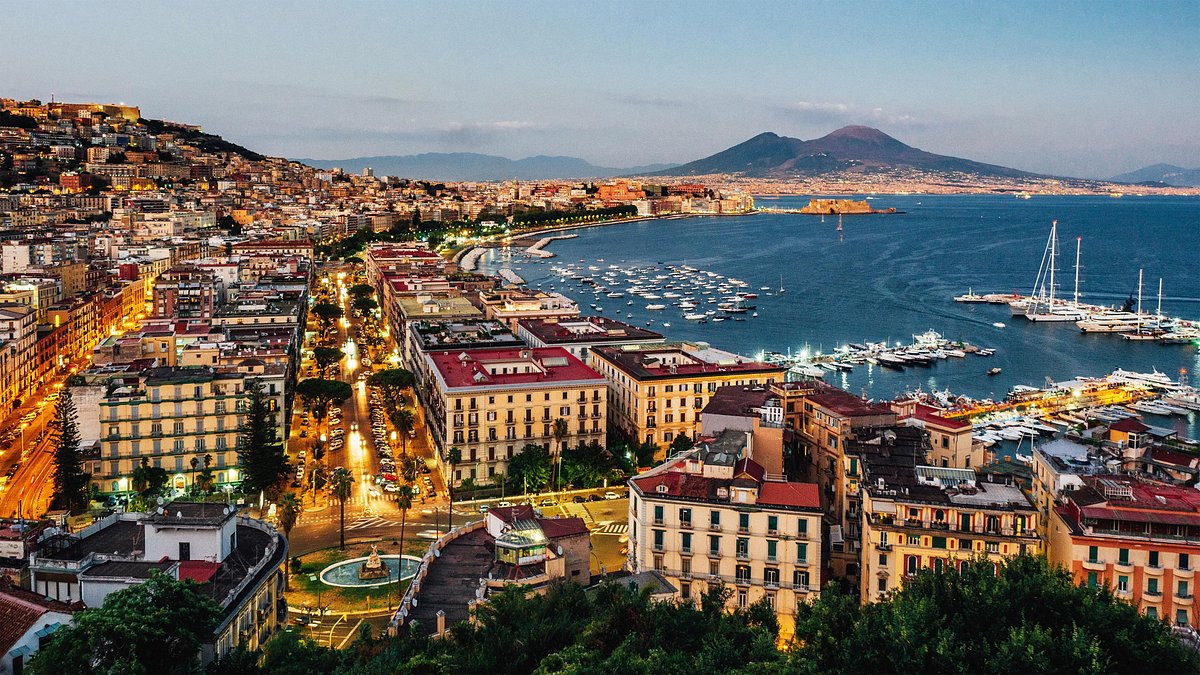

IMAGES
VIDEO
COMMENTS
Herculaneum has been preserved like no other site in the world, not even nearby Pompeii.The city was buried beneath 16 meters of ash and mud during the eruption of Mount Vesuvius in 79 AD, and this layer of detritus saved two-story domus homes with the internal architecture and décor intact, including features in wood and marble, decorations, jewelry, and even organic remains like food ...
For your convenience, we've included a self-guided Herculaneum walking tour on which you can see all the highlights of Herculaneum. The self-guided Herculaneum tour is 1.25 km (0.75 miles) long and takes about 1-2 hours at a moderate pace. If you wish, you can add additional stops along the way.
Corso Resina, 187, 80056 Ercolano NA, Italy. Phone +39 081 010 6490. Web Visit website. Herculaneum is an archeological zone located at the foot of Mount Vesuvius in the town of Ercolano in Southern Italy. Named after its patron deity, Herakleia (Hercules), the wealthy seaside town (along with its more famous neighbor, Pompeii) vanished beneath ...
A Roman Seaside Resort. Herculaneum was a small walled town located a short distance from the sea, west of Mount Vesuvius. As its name suggests, it was originally dedicated to the Greek god Herakles, who, according to the legend told by Dionysius of Halicarnassus (60 BCE), founded the city after his return from one of his twelve labours. The precise early history of Herculaneum is unclear, but ...
Herculaneum Map - Attractions (Historical) Follow us on Instagram. More on Italy. Italy Travel Guide. 25 Top-Rated Tourist Attractions in Italy. ... 28 Top-Rated Tourist Attractions in the World. 22 Best Tropical Vacations. 24 Most Beautiful Islands in the World. FOLLOW USWe're sharing tips, tools, ...
Book our Day Trip to Herculaneum. Train: catch the Sorrento Circumvesuviana train from Naples and get off at Ercolano Scavi. The journey takes about 15 minutes and costs around € 2 ( US$ 2.20). Rental car: this option can turn out to be cheaper and easier if you're travelling as a group and have other excursions planned to nearby sites.
A major public-private partnership, the Herculaneum Conservation Project, has shaped conservation and site management and enhancement at Herculaneum since 2001. The ' Grande Progetto Pompei' , approximately a 5-year project begun in 2012 with the European Union has, among other things, stabilized and conserved buildings in the areas of ...
In case you didn't know, Herculaneum is a Roman town near Naples in Italy which was destroyed by the famous eruption of the volcano Vesuvius in 79AD. If you haven't heard of that, then I'm guessing you were the naughty kid in school. Maybe go away and read the Wikipedia page and then come back here to carry on.
Visit Herculaneum. Herculaneum (known in Italy as Ercolano) is an ancient Roman town situated on the outskirts of Naples - it was buried by ash falling and subsequent lava flows after the eruption of Mount Vesuvius in 79 AD. Less well known than Pompeii, Herculaneum is another important Roman town destroyed by the same eruption of Mount ...
Herculaneum, in the outskirts of Naples, is a great alternative to Pompeii and a fascinating archaeological site to visit. The well-to-do Roman coastal town was destroyed by the eruption of Vesuvius in AD79 and now it provides an insight into how its Roman residents lived. From Italy Heaven's tourist guide to Italy.
Visiting Herculaneum from Sorrento. The journey from Sorrento to Herculaneum is another really easy trip on the Circumvesuviana train. Get on the train at the station in the centre of Sorrento and get off at Ercolano Scavi. The train from Sorrento to Ercolano takes around 40 minutes; at peak times there's a train every 15 minutes.
Full price 13 €. Reduced (young people 18-25) 2 €. Ticket Office. Some information is provided by: 80056 Ercolano, Metropolitan City of Naples, Italy. Herculaneum is an archaeological park at the foot of Mount Vesuvius in the town of Ercolano in Southern Italy. Discover its ruins.
Train: Visitors need to take a train to Naples to get to Herculaneum. These leave from Termini railway station. Once in Naples, the Circumvesuviana line goes to Herculaneum (Ercolano Scavi station). It takes between 2 - 3 hours to get there and the prices range from € 30 ( US$ 32.40) to € 100 ( US$ 108.20) for a roundtrip, depending on ...
To get to Herculaneum from Pompeii's Scavi station, hop on the train headed towards Naples. The ride is about 15 minutes and your station will be Ercolano Scavi (Herculaneum). You can also do the visit the other way round from Herculaneum to Pompeii. At Ercolano Scavi station take the train towards Sorrento and get off at Pompeii Scavi station.
What to Know Before Visiting Herculaneum from Naples. I have always wanted to visit Herculaneum and Pompeii. I knew they were close to Naples, an Italian city that I wanted to eat a lot of pizza in or take one of the famous Naples food tours in… but I yearned to go and learn about this enthralling, ancient history.. Herculaneum was an ancient Roman town located fairly close to modern-day ...
Pompeii & Herculaneum Articles. Cucina Povera in Pompeii Herculaneum: Archaeology as a Gentleman's Game Pompeii Opening Times and Prices Pompeii News. Pompeii Body Casts. ... Wandering Italy: Nuts and bolts travel tips, maps, and interesting destinations, some way off the tourist track. We lead you astray--in a good way, of course.
Stopped in their tracks by the eruption of Mount Vesuvius in AD 79, Pompeii and Herculaneum offer the best look anywhere at what life in Rome must have been like around 2,000 years ago. These two cities of well-preserved ruins are yours to explore. Of the two sites, Pompeii is grander, while Herculaneum is smaller, more intimate, and more intact; both are easily reached from Naples. Meanwhile ...
Herculaneum before eruption. Herculaneum was a 2000-year-old, ancient Roman city about 5 miles to the southeast of Naples, in Campania, Italy. With just about 4,000-5,000 inhabitants, this splendid town lay in the shadow of Mount Vesuvius. Although it was a small seaside fishing town, Herculaneum was a wealthy town that possessed a great ...
Herculaneum (it: Ercolano) is a town close to Naples in Campania, Italy. It is named after the ruined Roman city which forms its main attraction. ... Enter these co-ordinates into google maps and it will take you direct to the main entrance 40.806023, 14.349228 There is an underground car park closeby a new entrance to Herculaneum, it costs € ...
Visit the ruins of Herculaneum departing from Naples, find out how with our guide.This half-day group tour departs from the Neapolitan capital and takes you to discover the ancient Roman city that was submerged by the eruption of Vesuvius in 79 AD.. This tour to visit the ruins of Herculaneum departs from Naples in the morning. After a comfortable transfer service, you will travel by fully ...
INFOPOINT: +39 081 8575 347. Open buildings and their opening hours : see the list … read more. From 1st April from 6.00 pm reduced access in some domus. VISIT THE ARCHAEOLOGICAL PARK OF POMPEII SAFELY. Full details regarding access … read more. It is possible to access the sites only with small bags (30x30x15 cm max.)
A full page Google map showing the exact location of 27 tourist attractions in Herculaneum. TouristLink also has a map of all the tourist attractions in Positano
Apr 12, 2024, 9:42 AM. Save. We are planning to visit Herculaneum in mid-May, 2024, travelling on the train from Naples Centrale. It seems that the train is often very crowded, so not knowing all the details we are reluctant to reserve a timed entry to the site. If we just show up at the gate and pay, is it likely it will be exceptionally busy ...